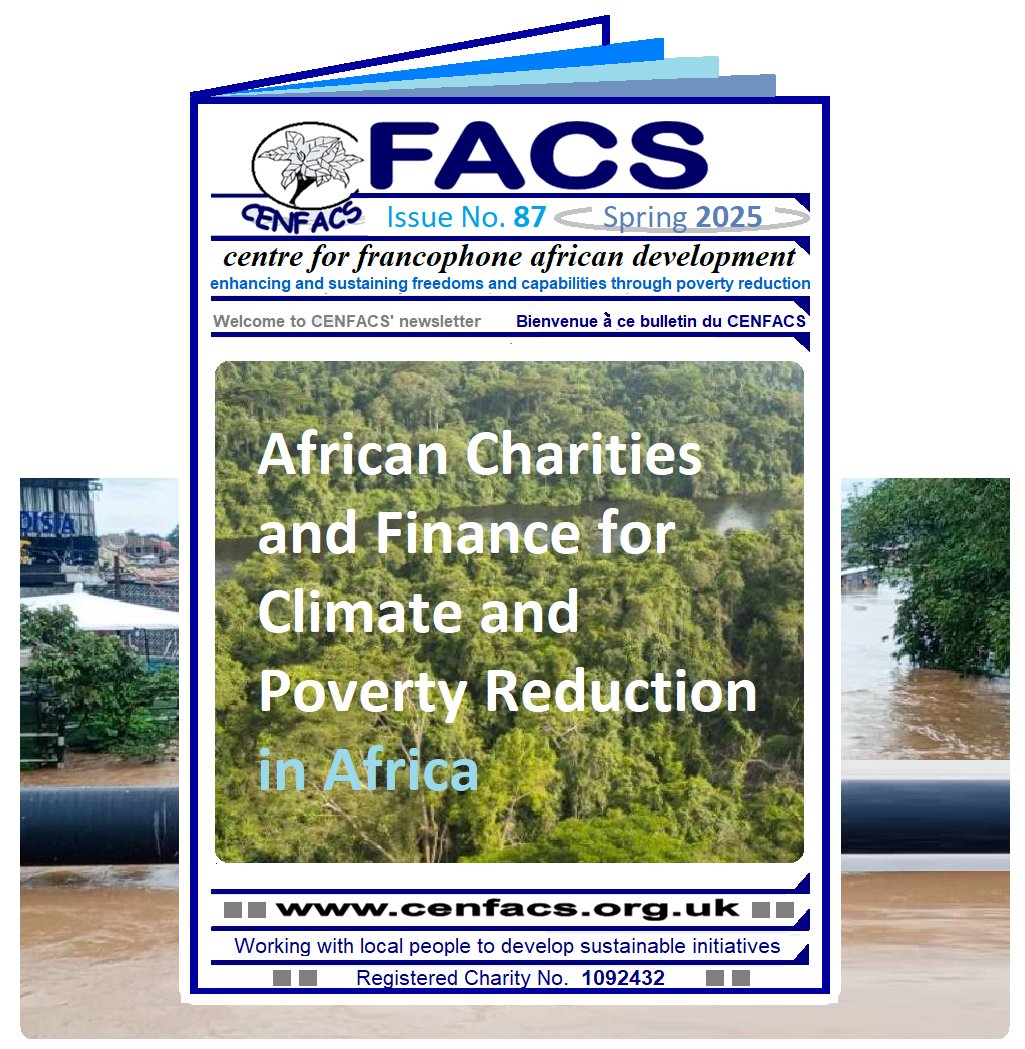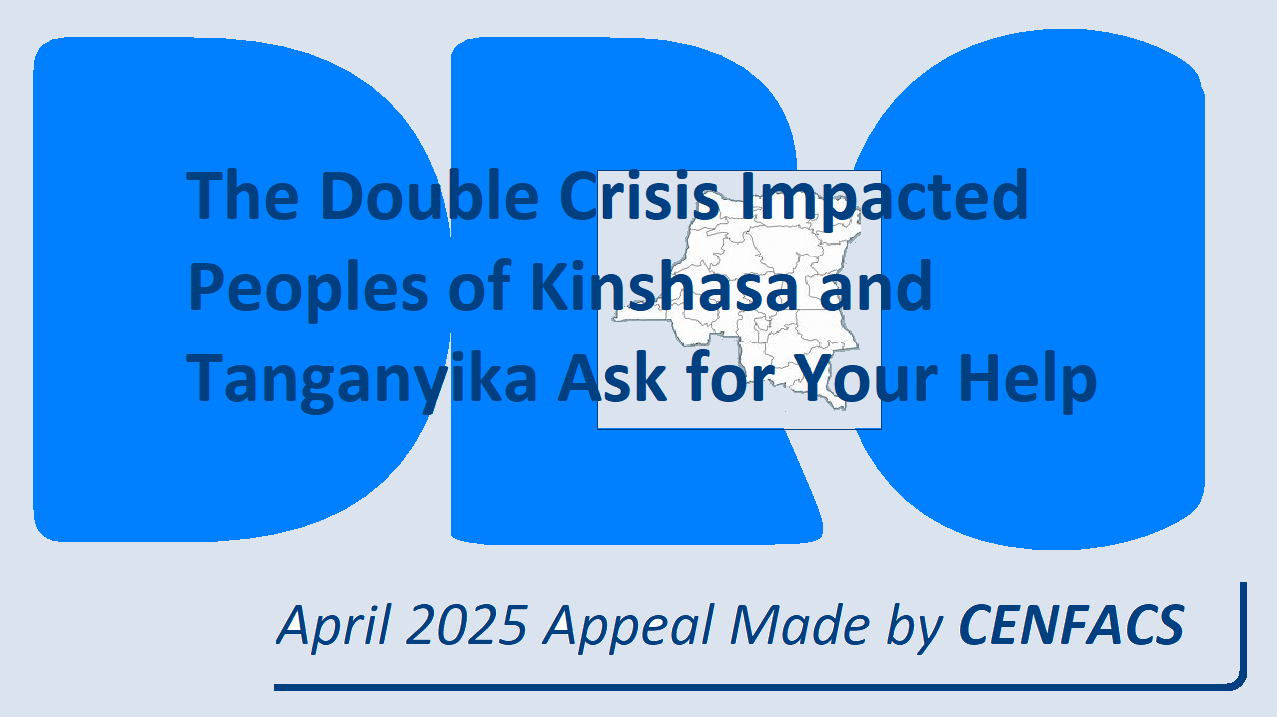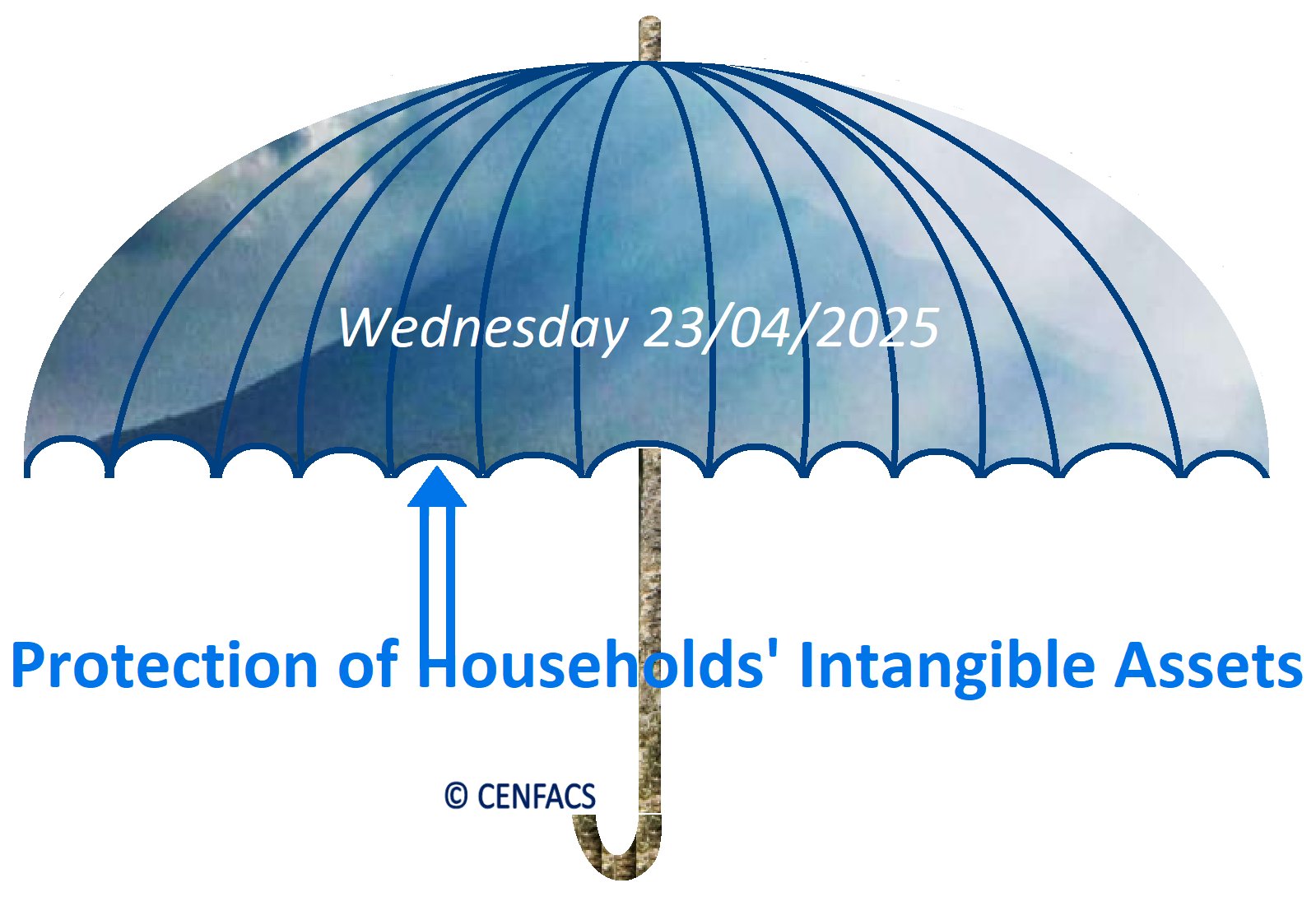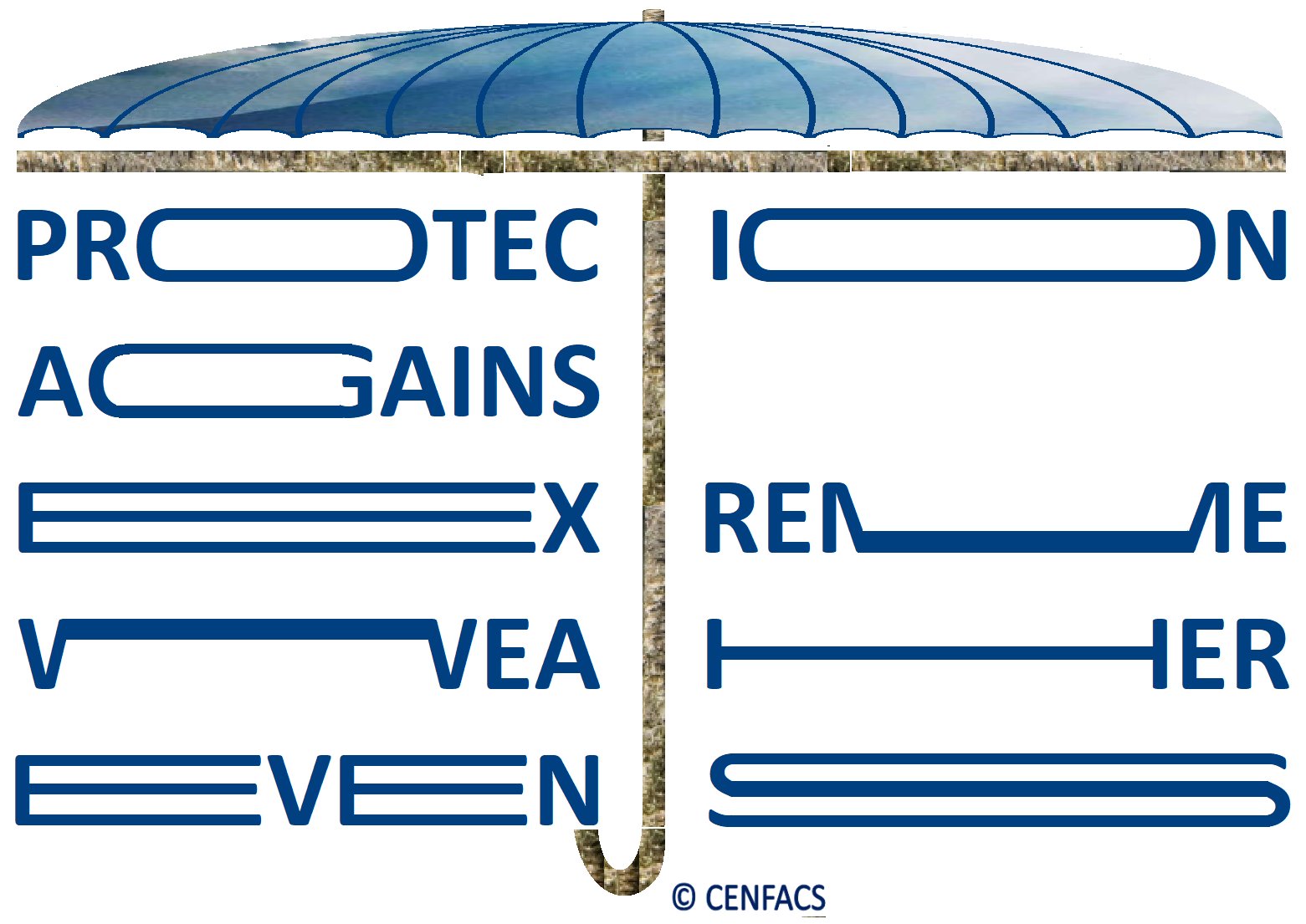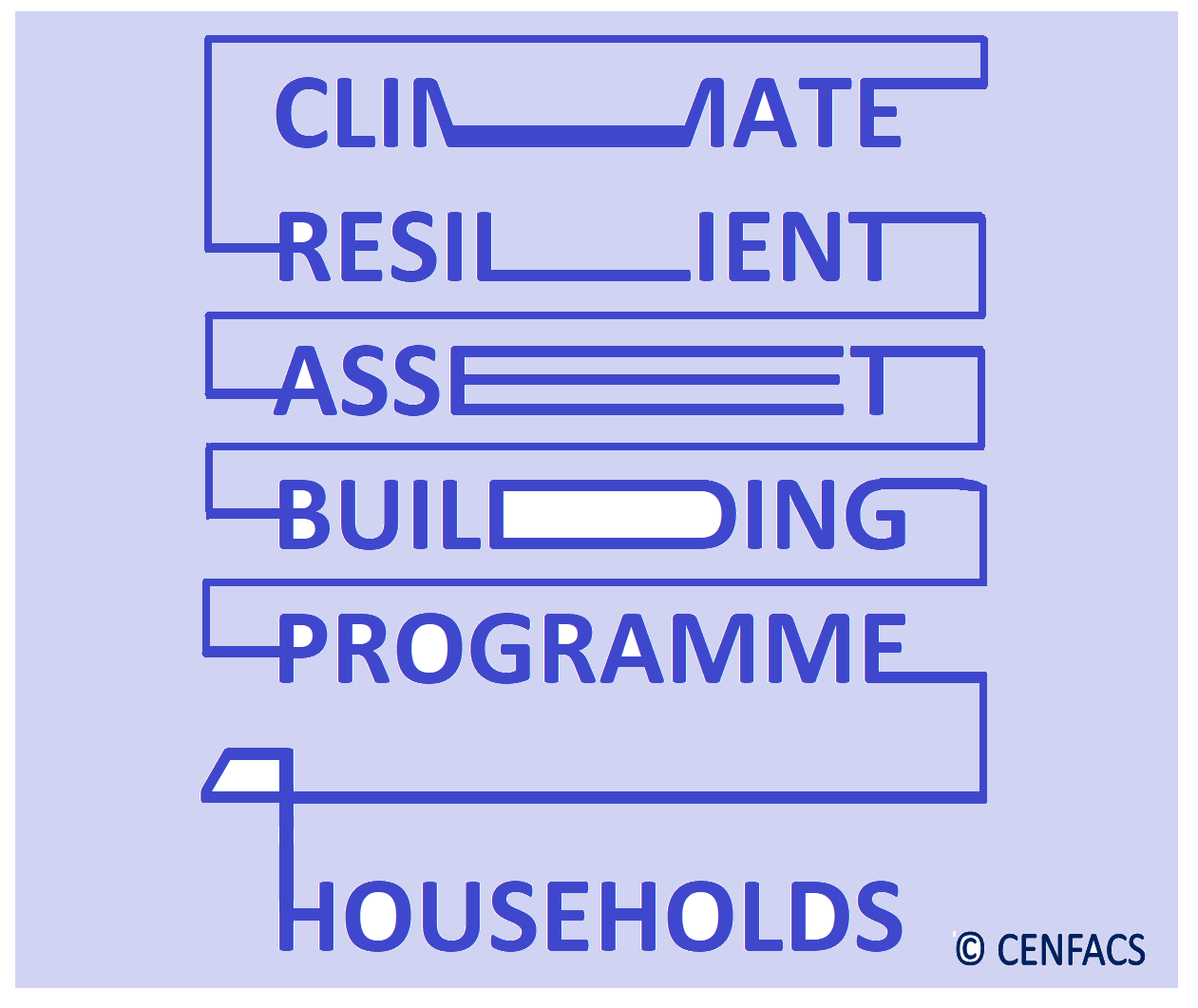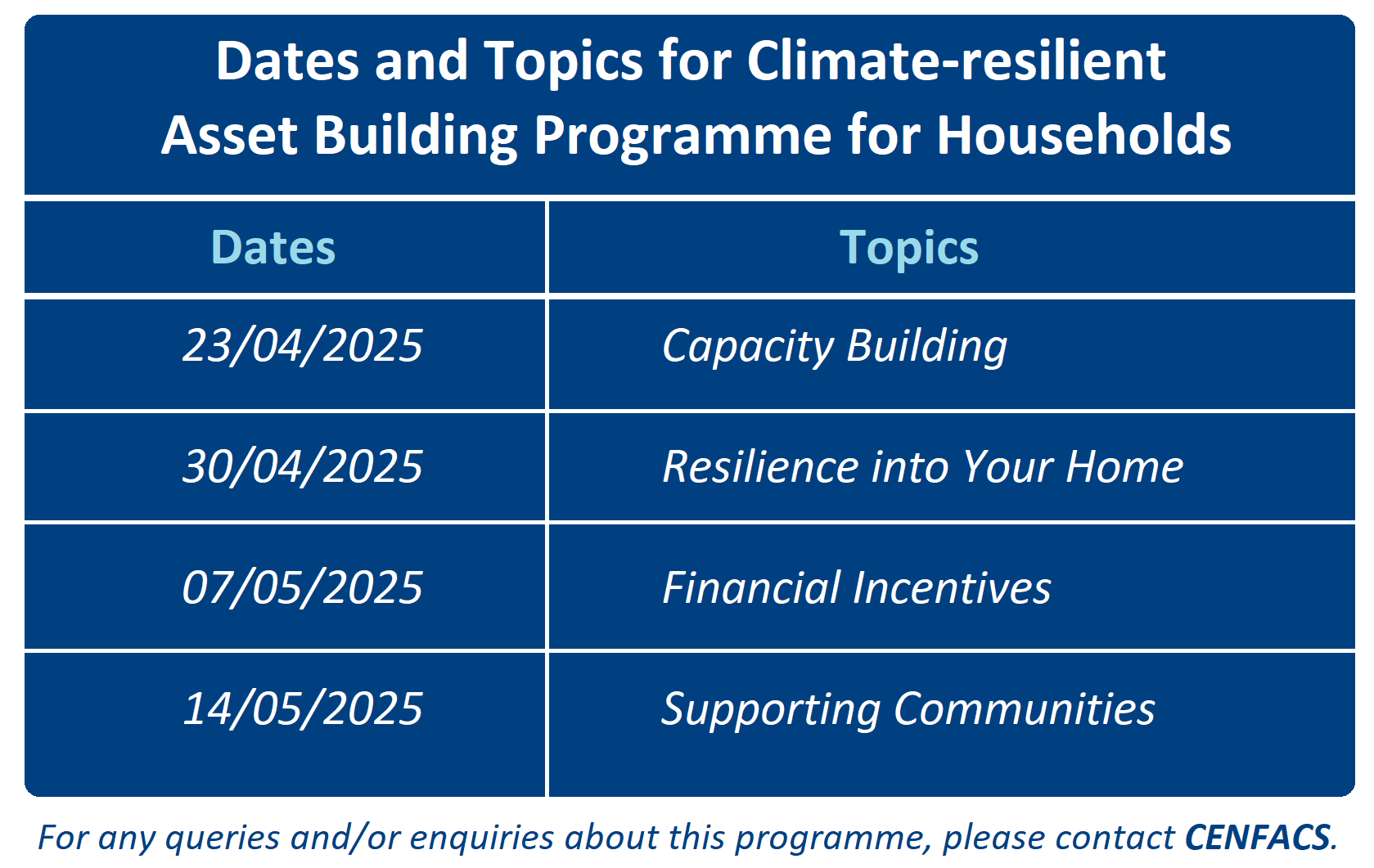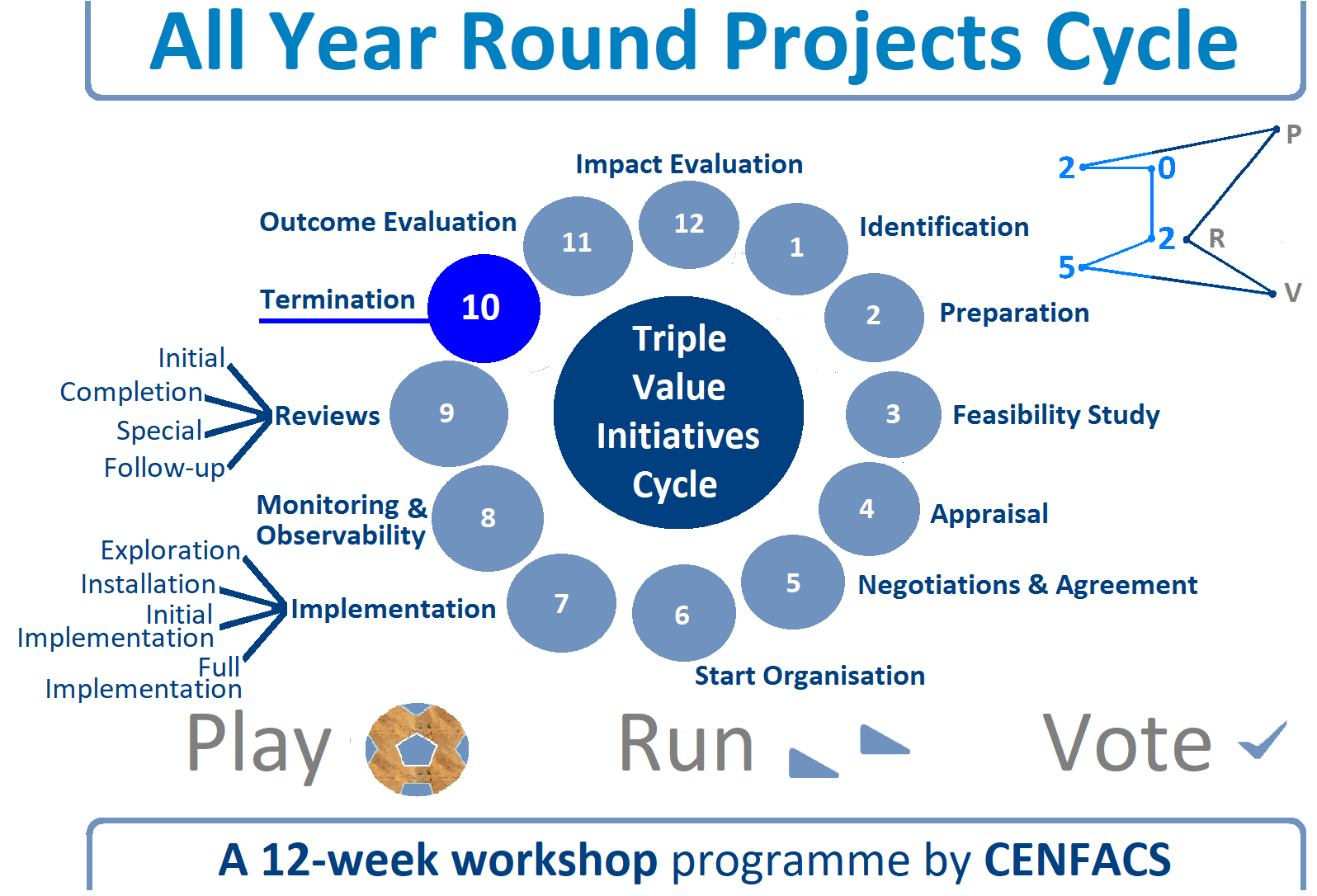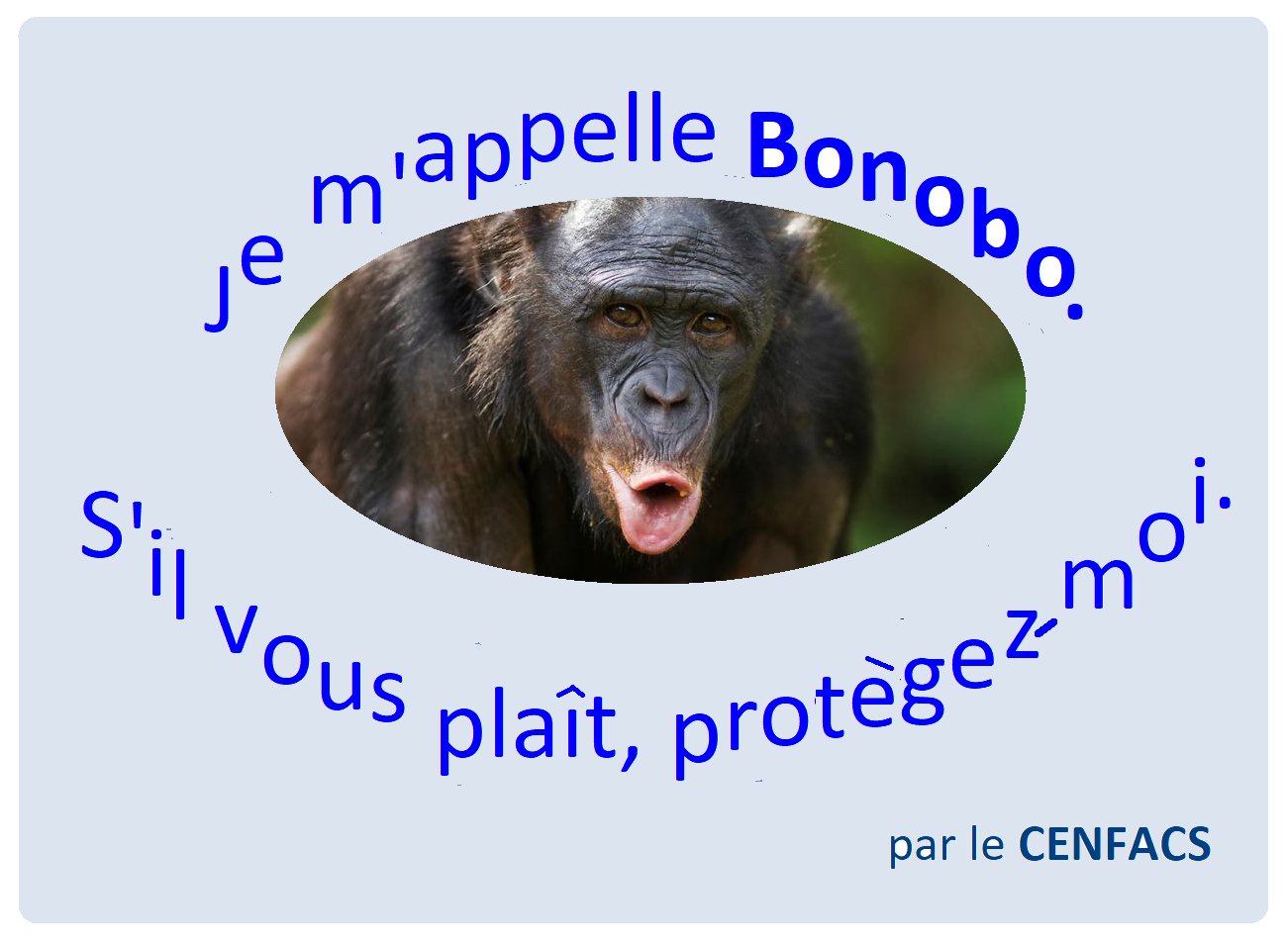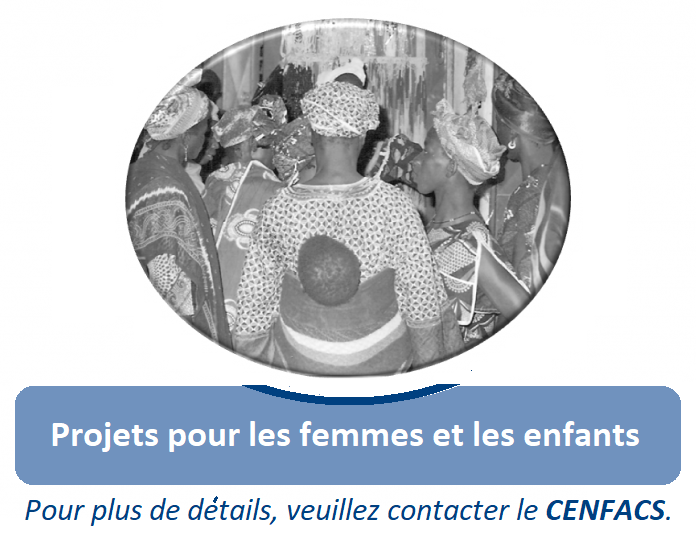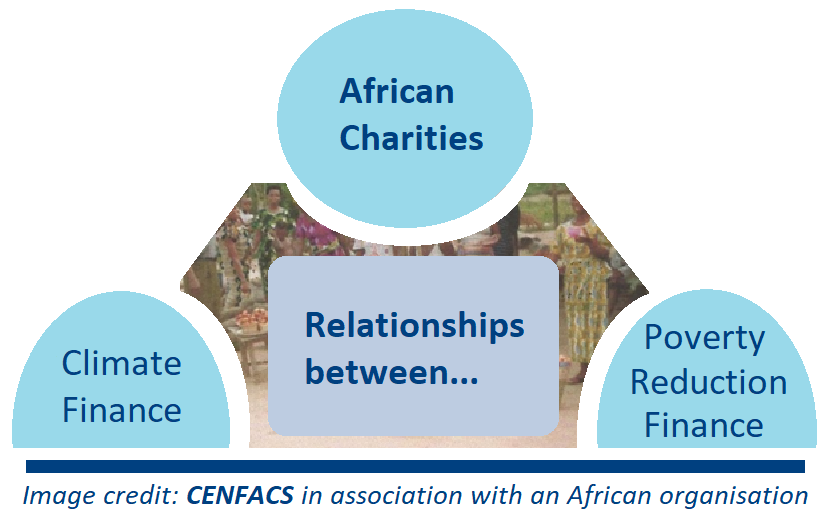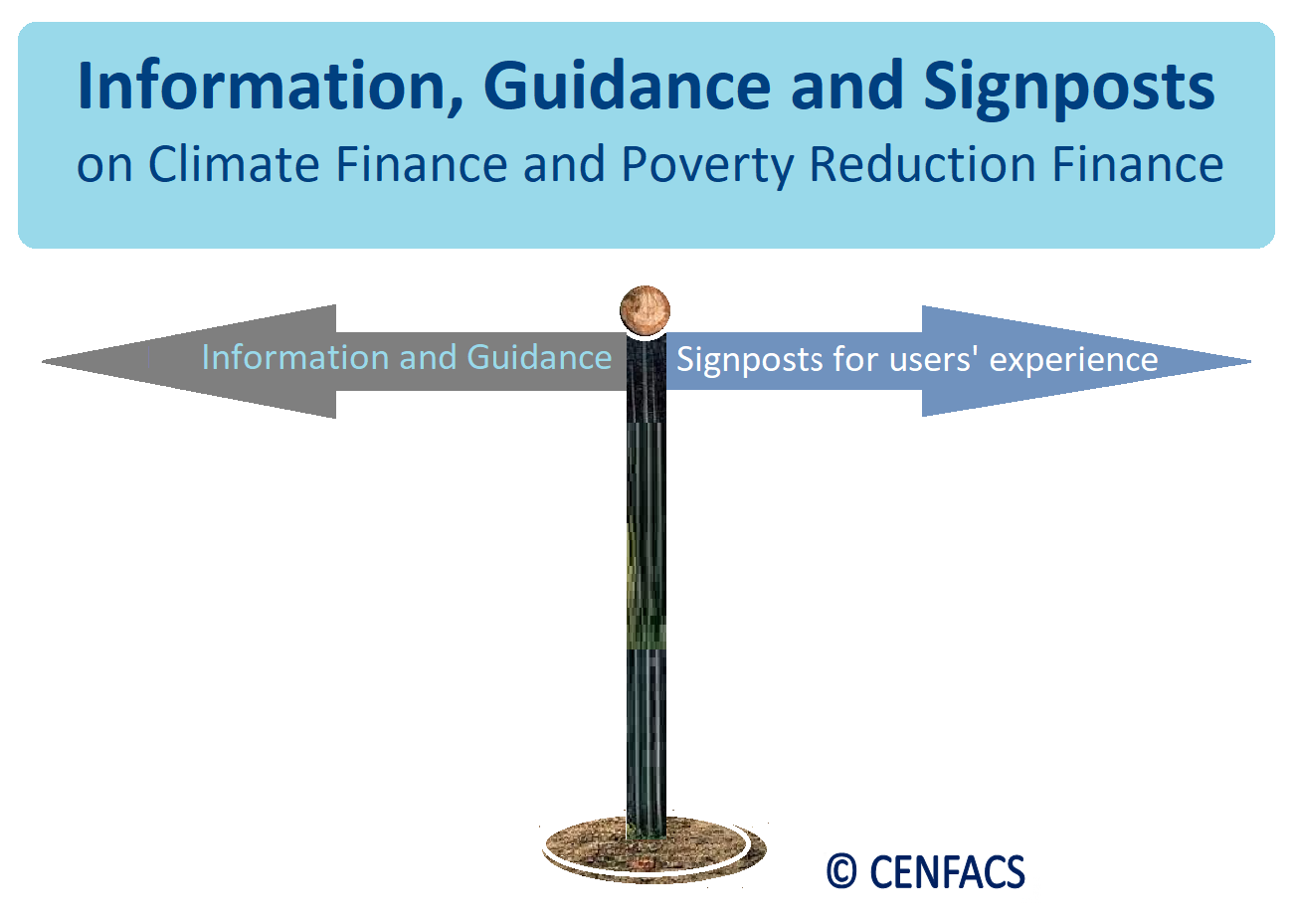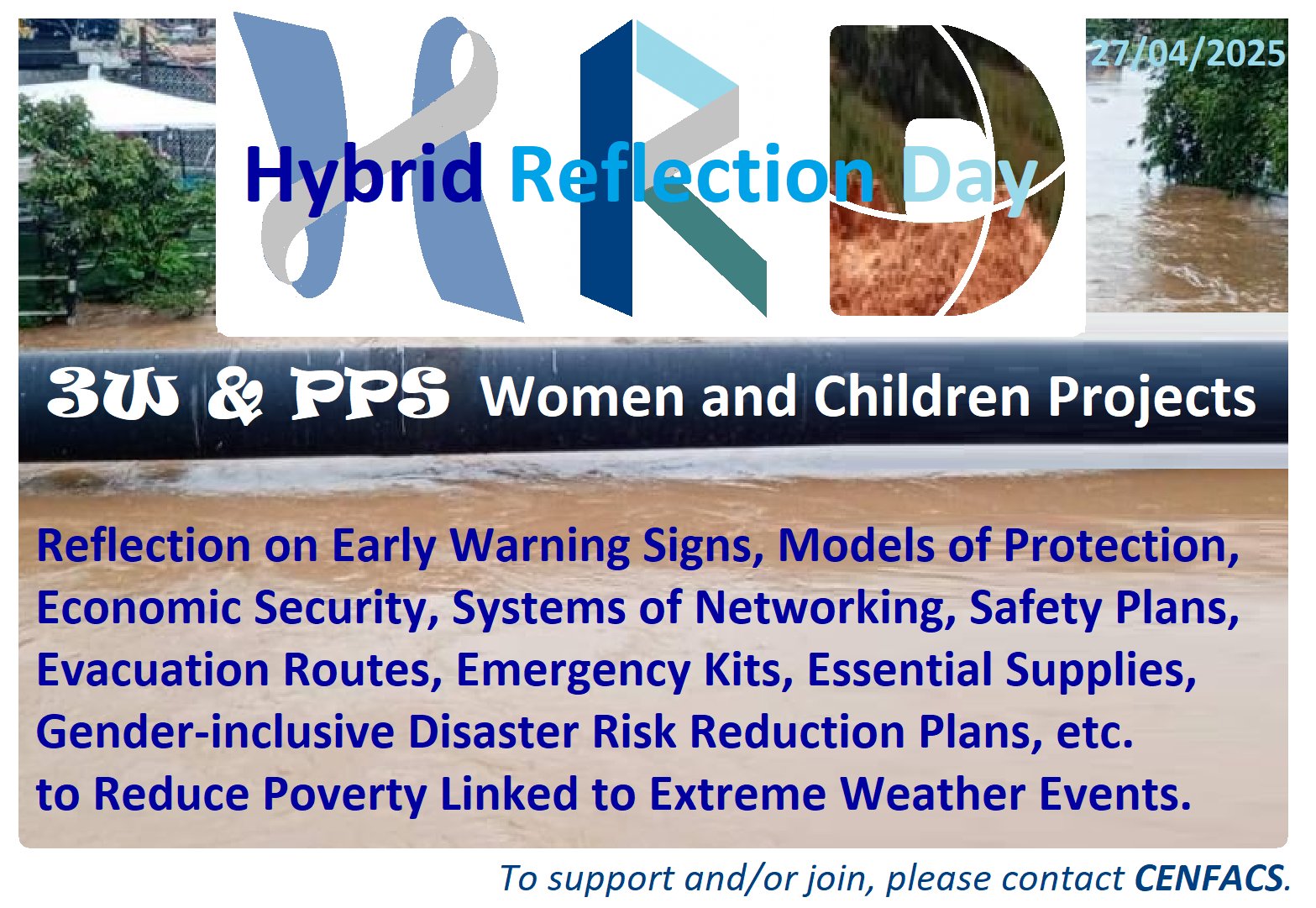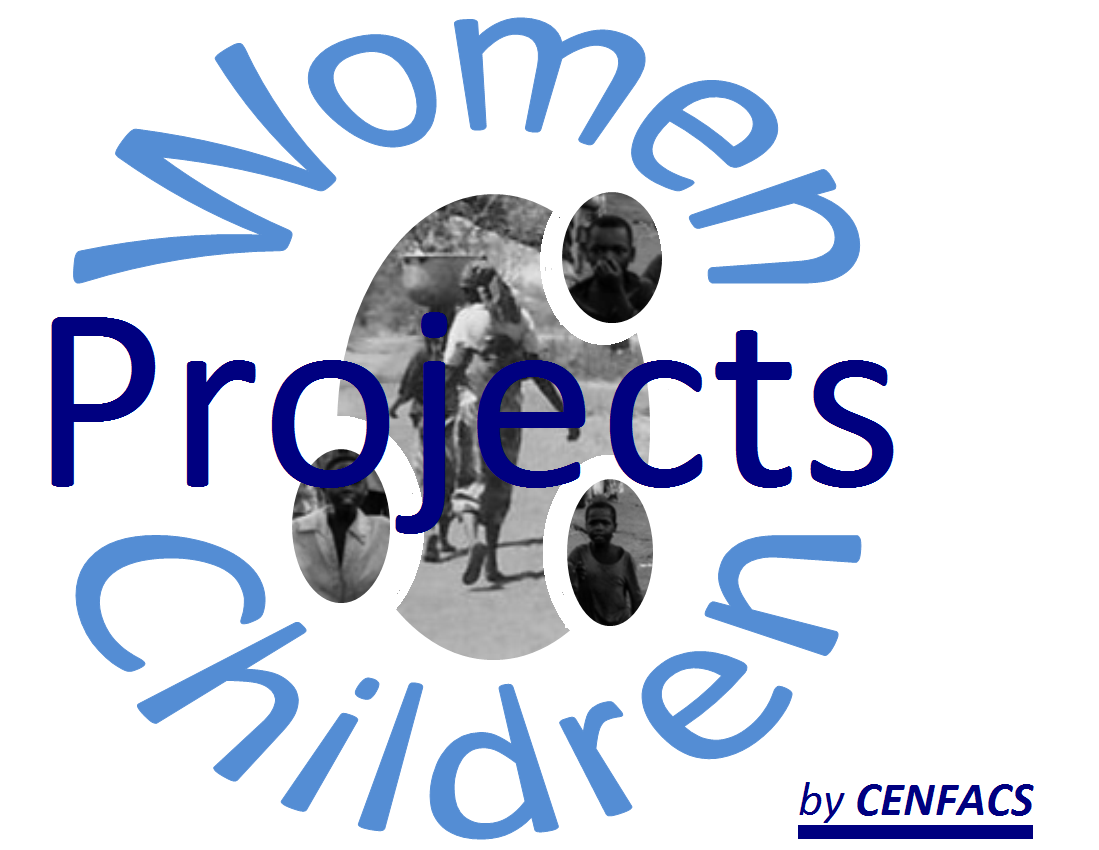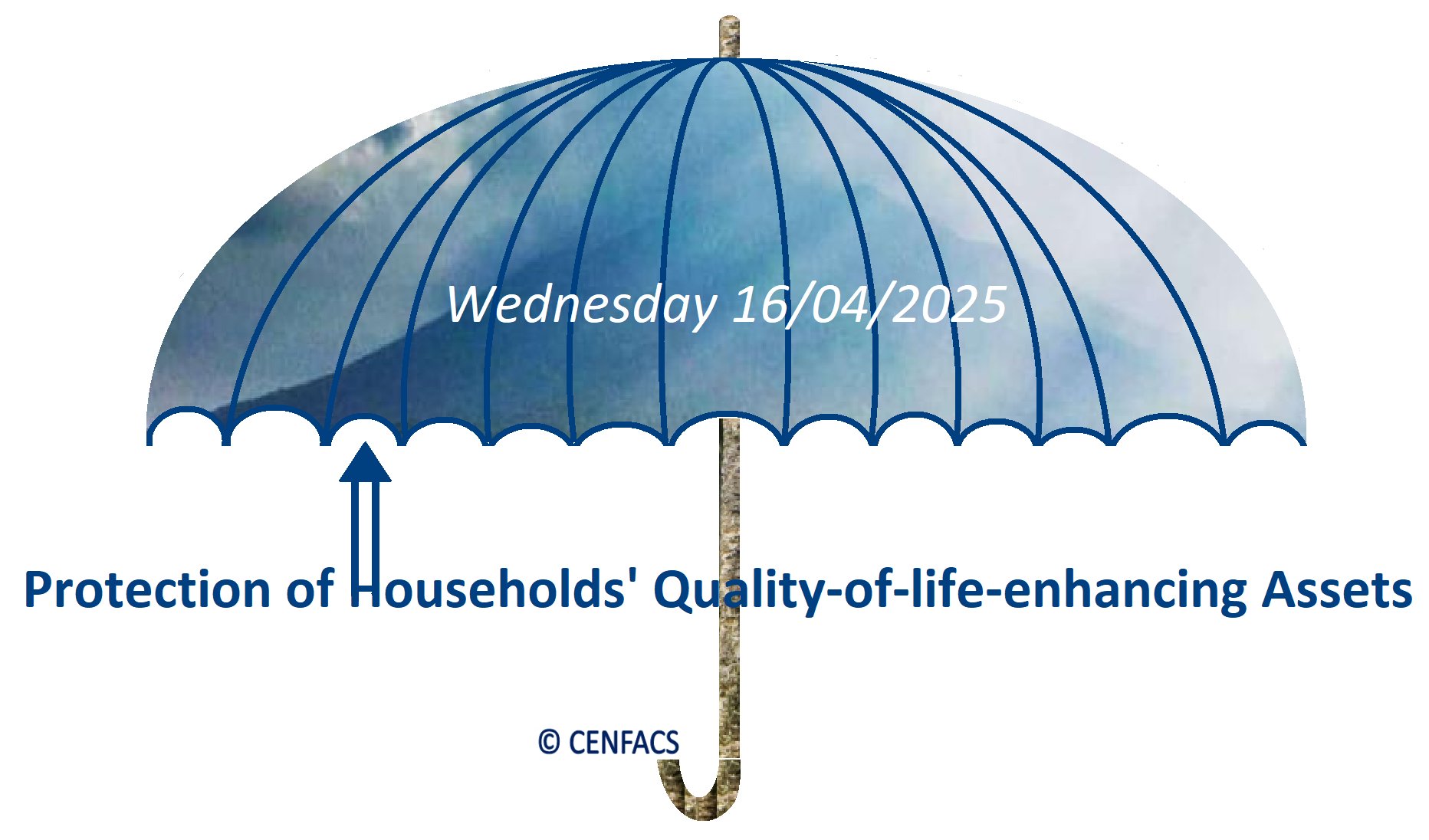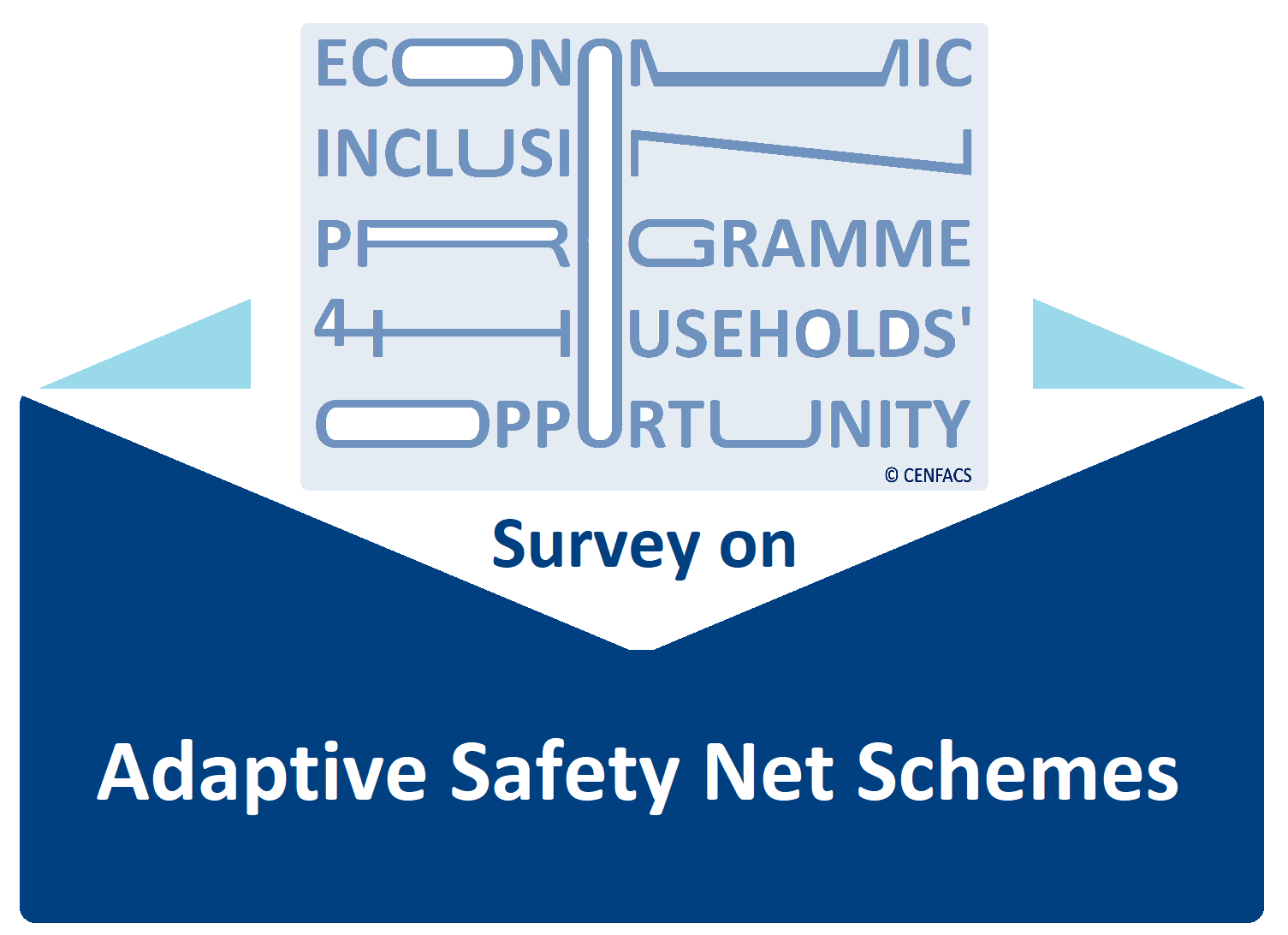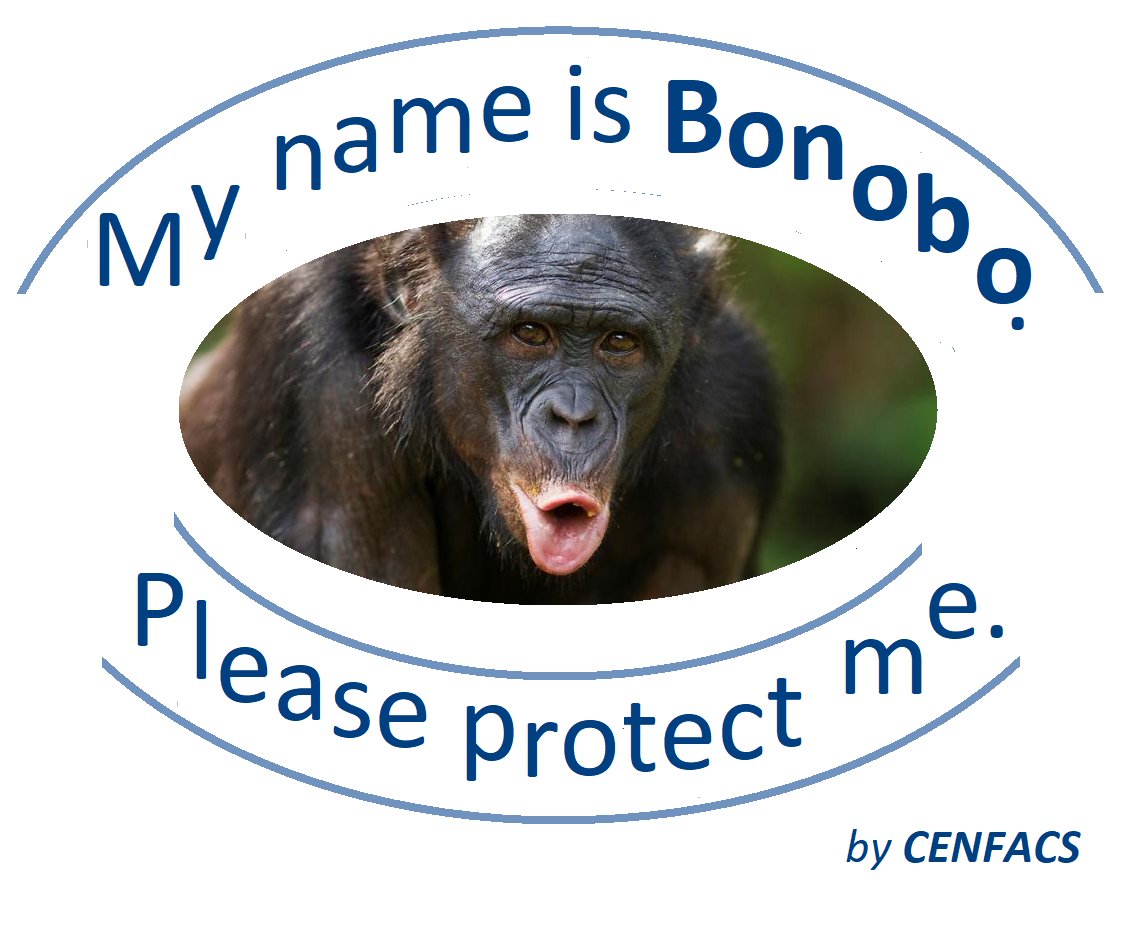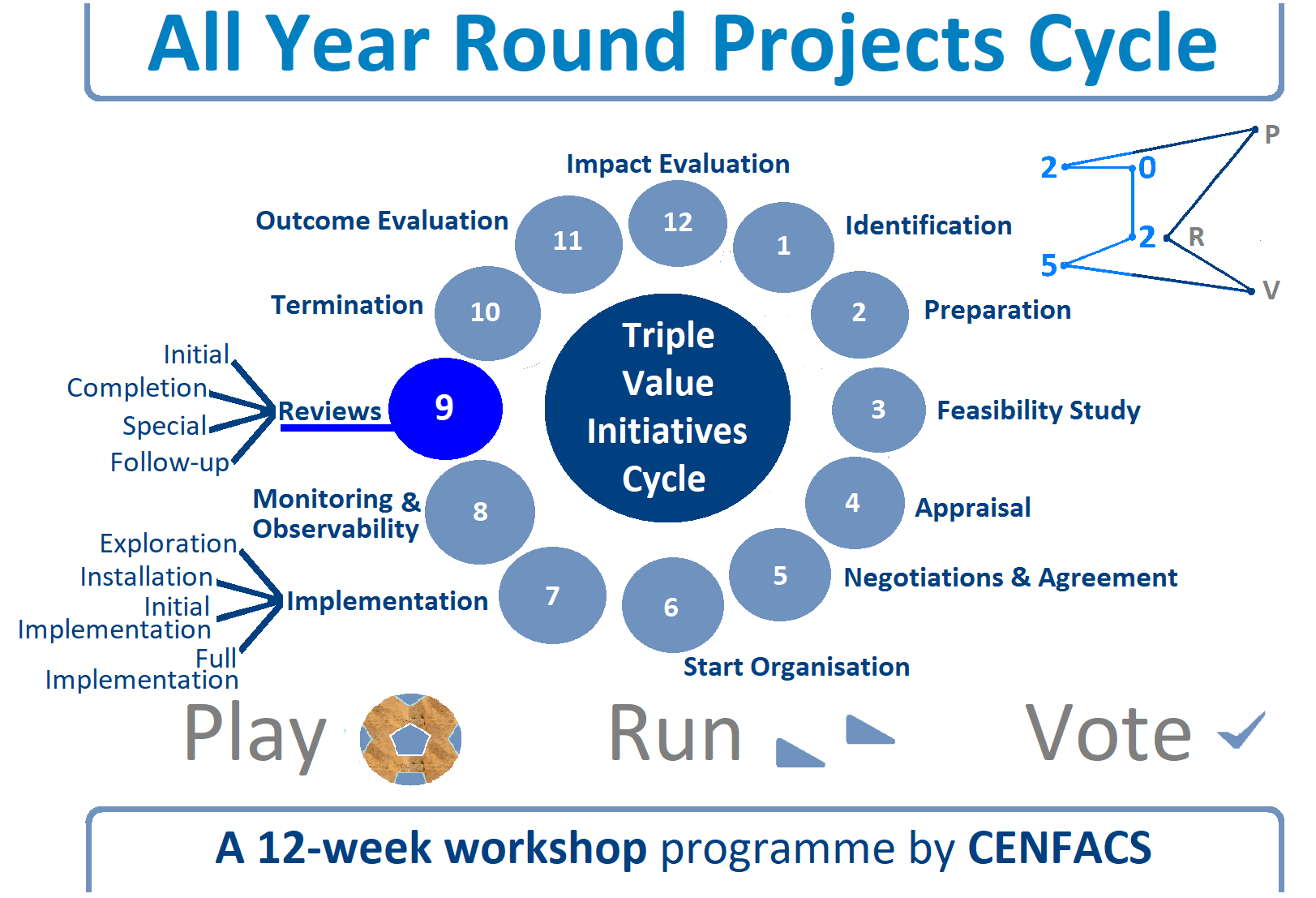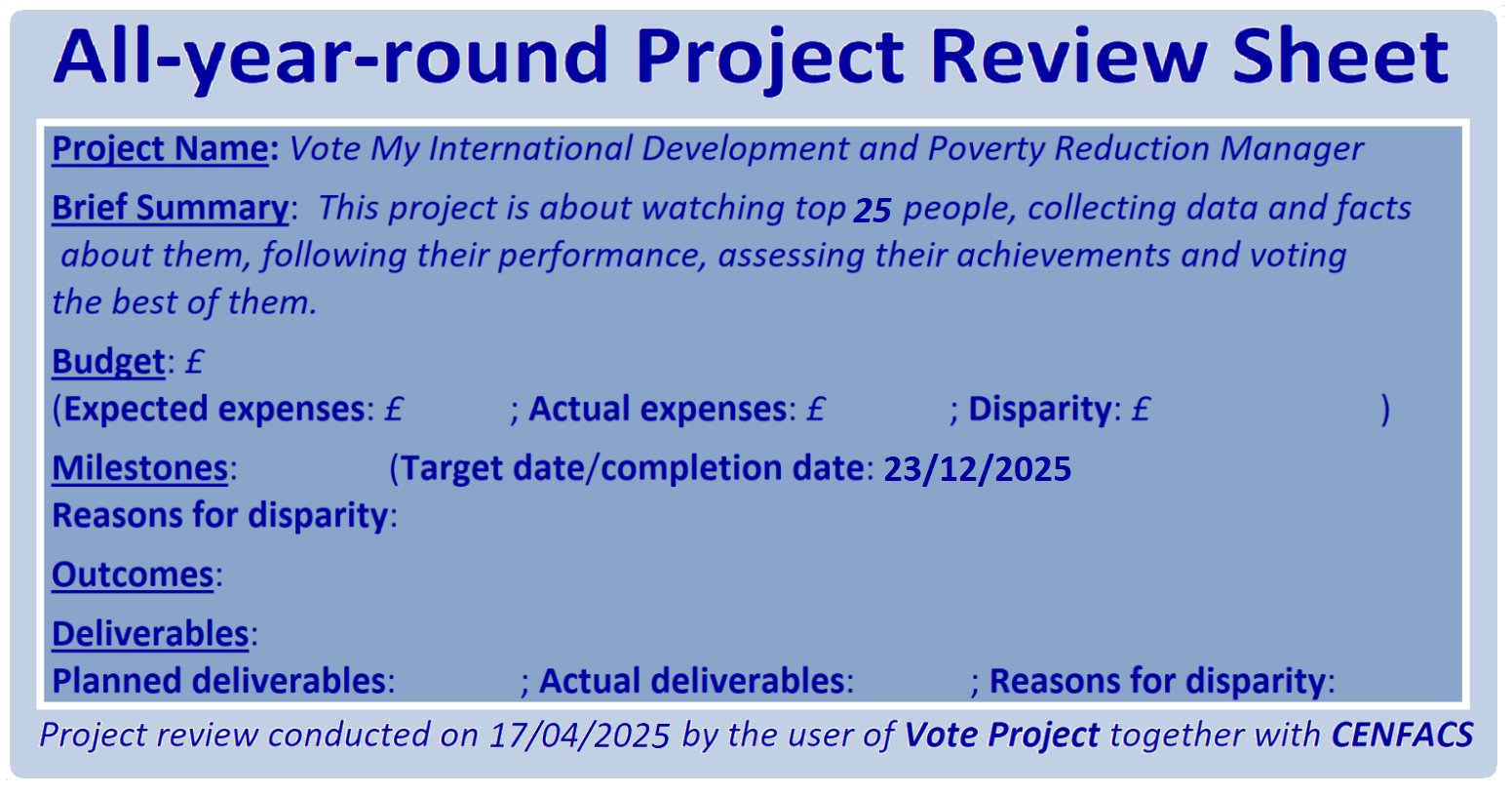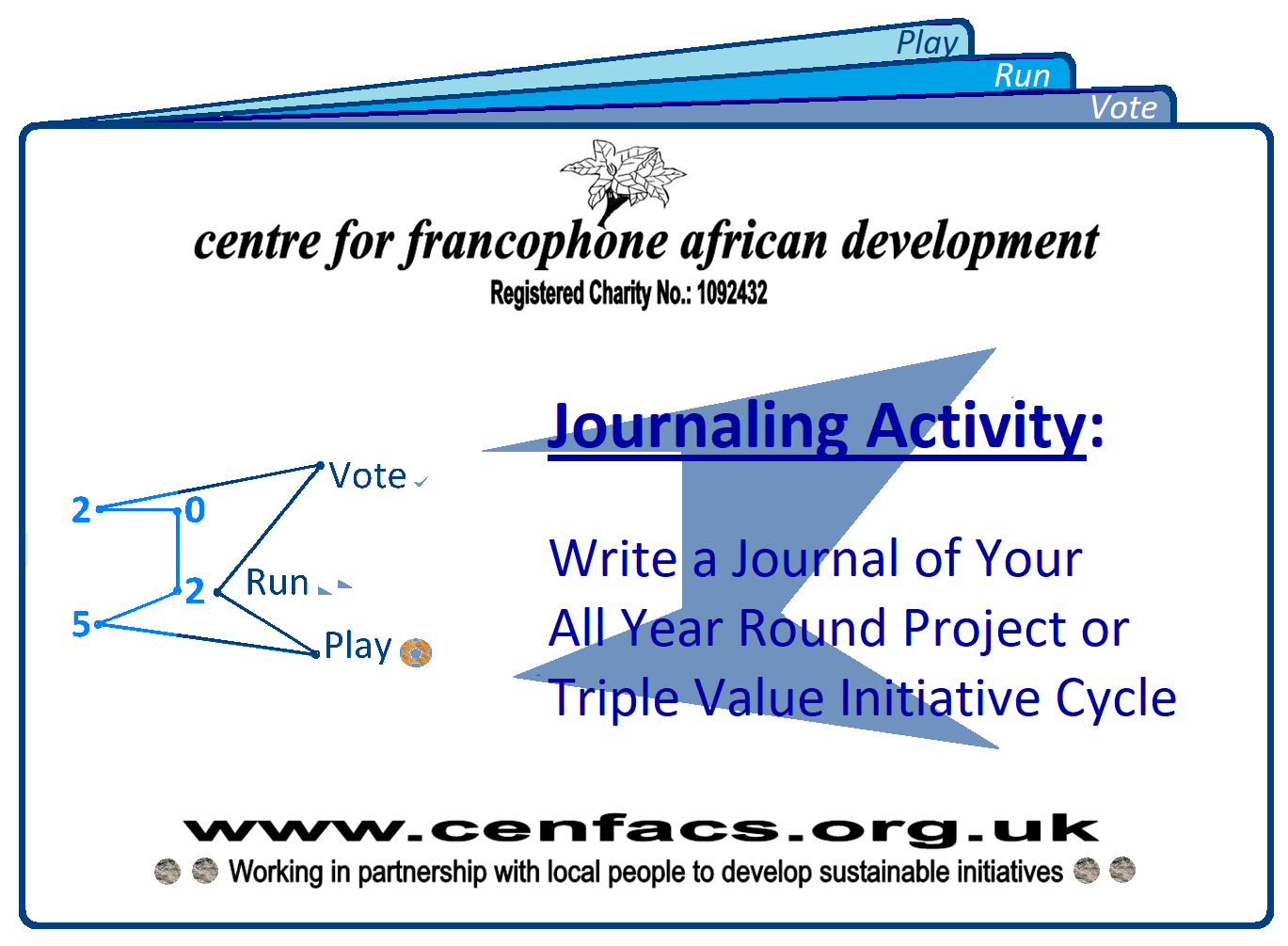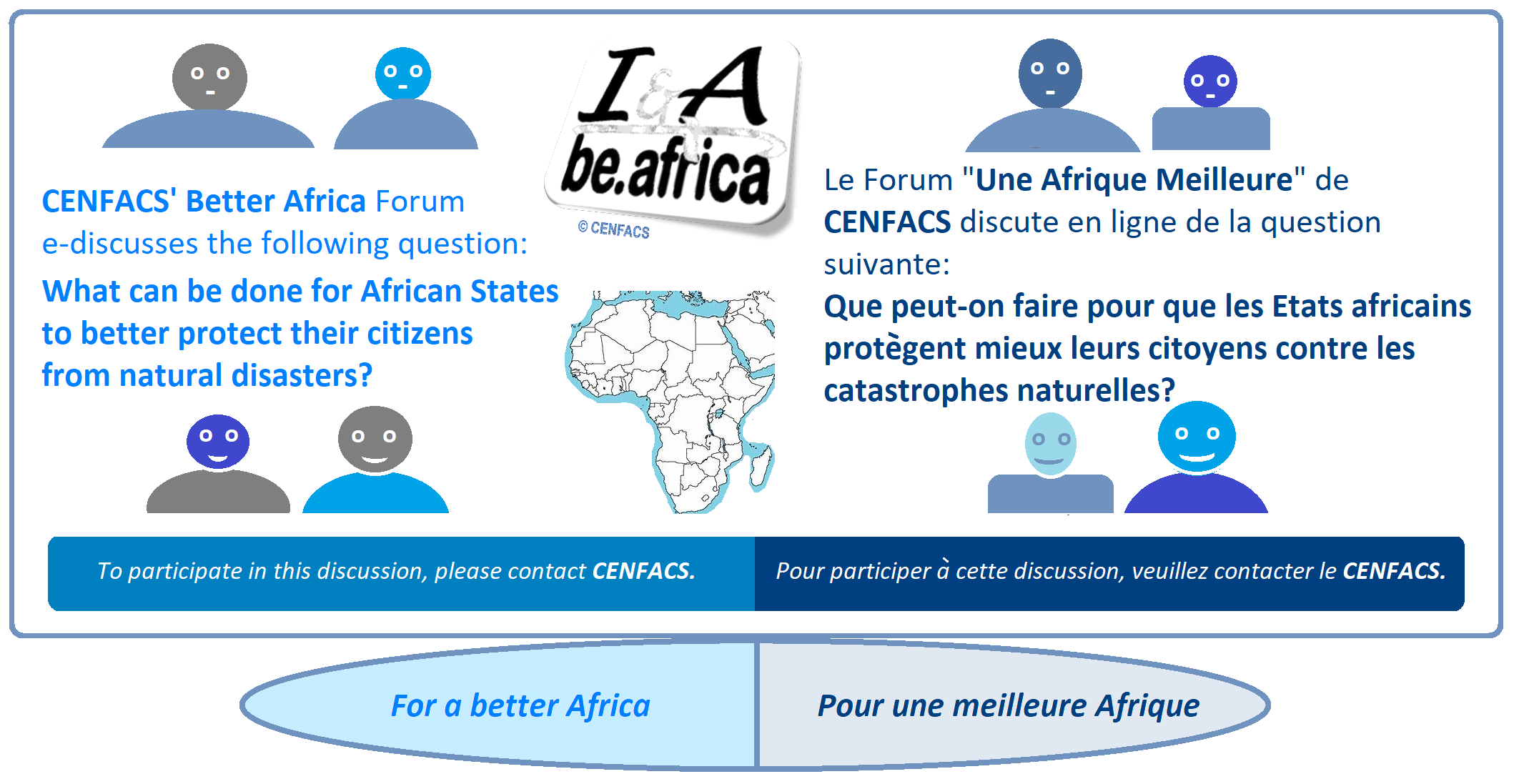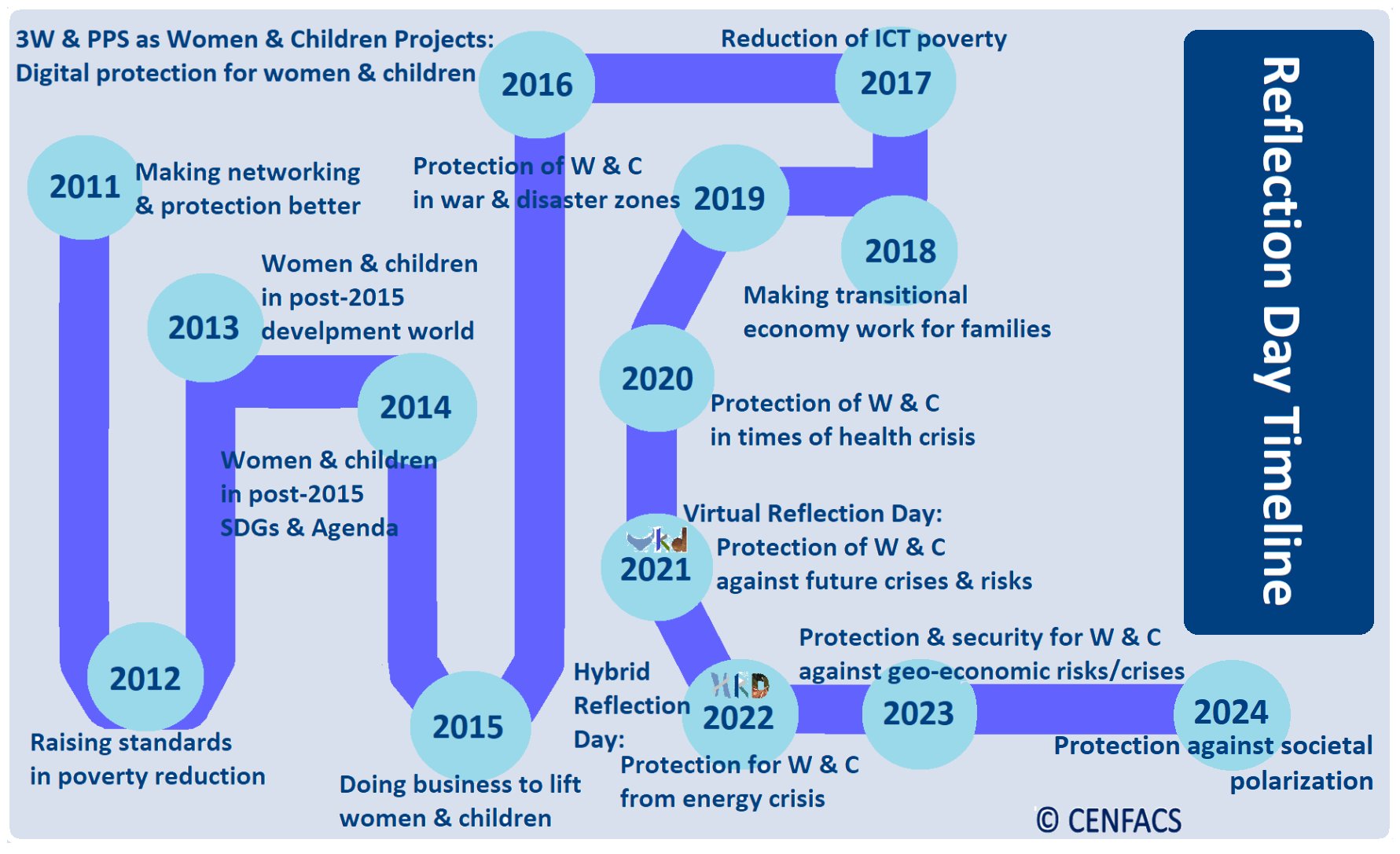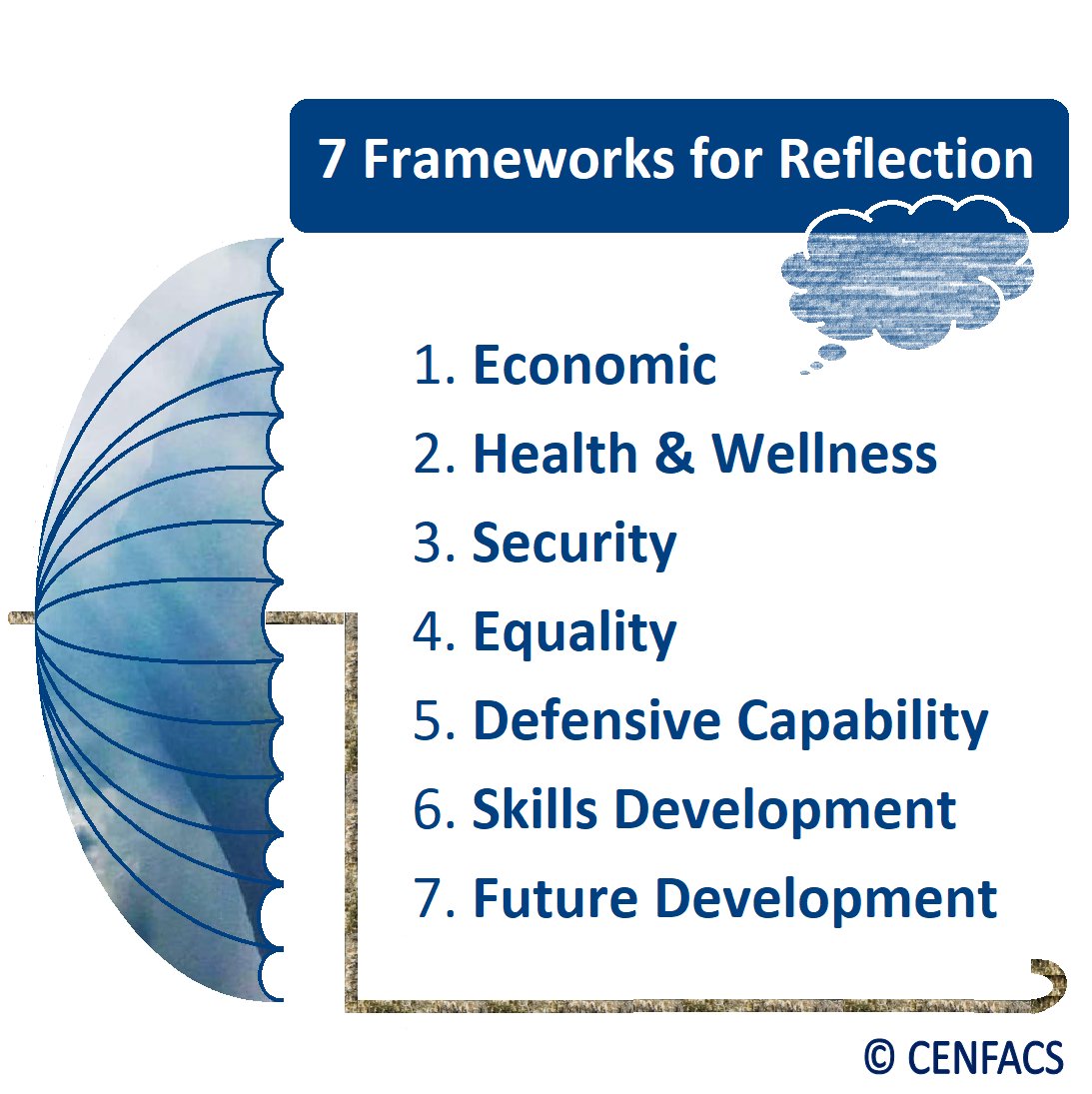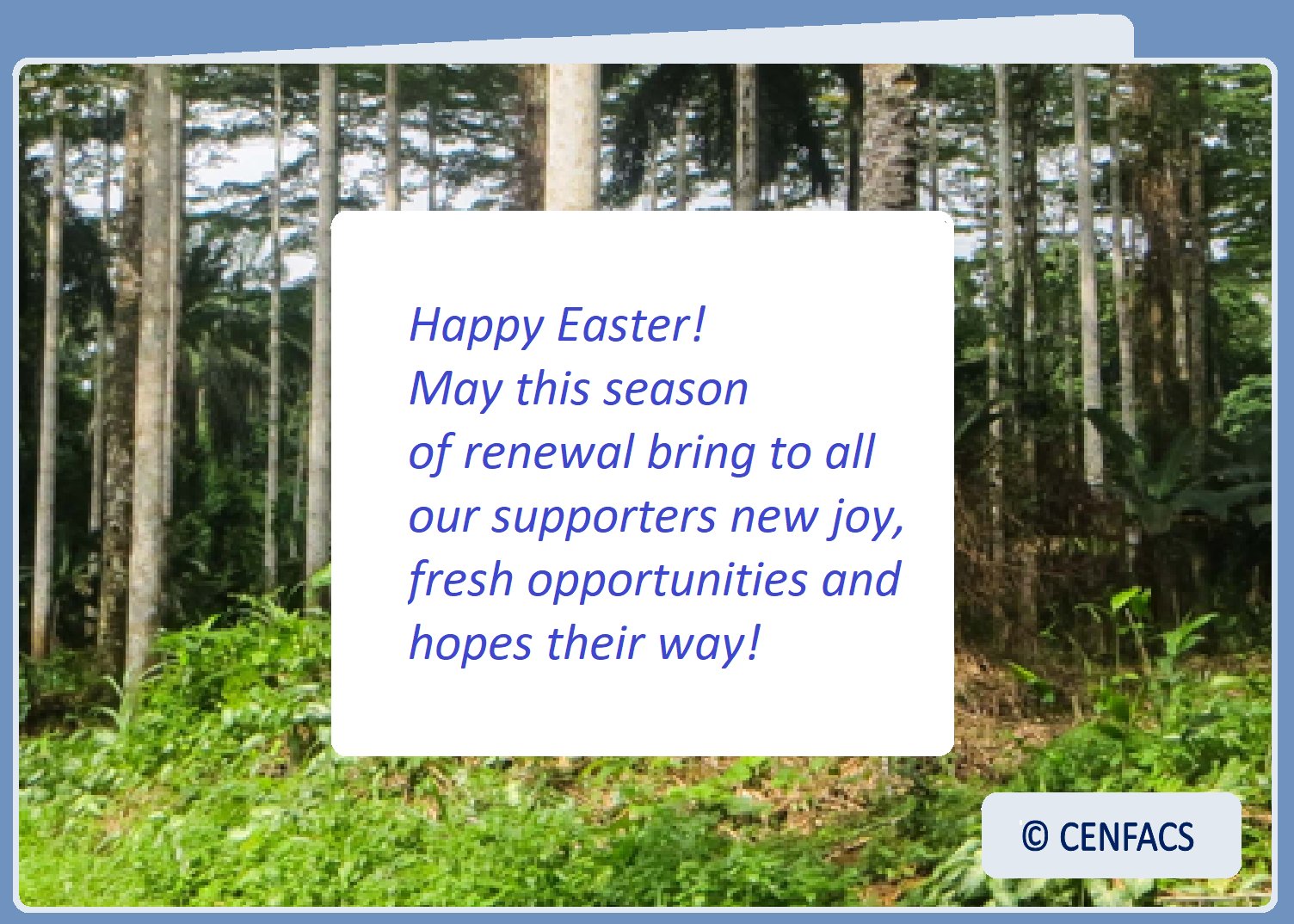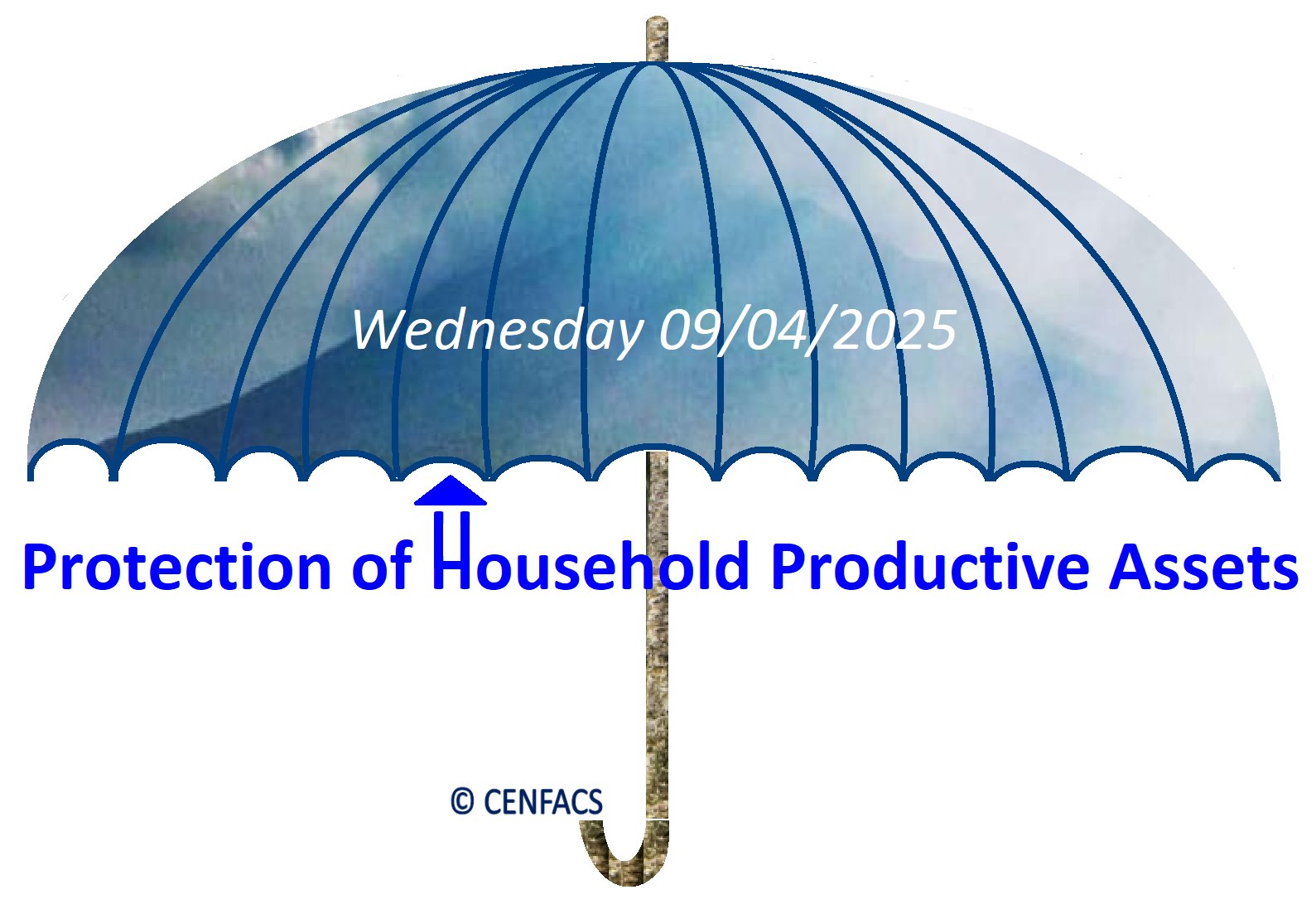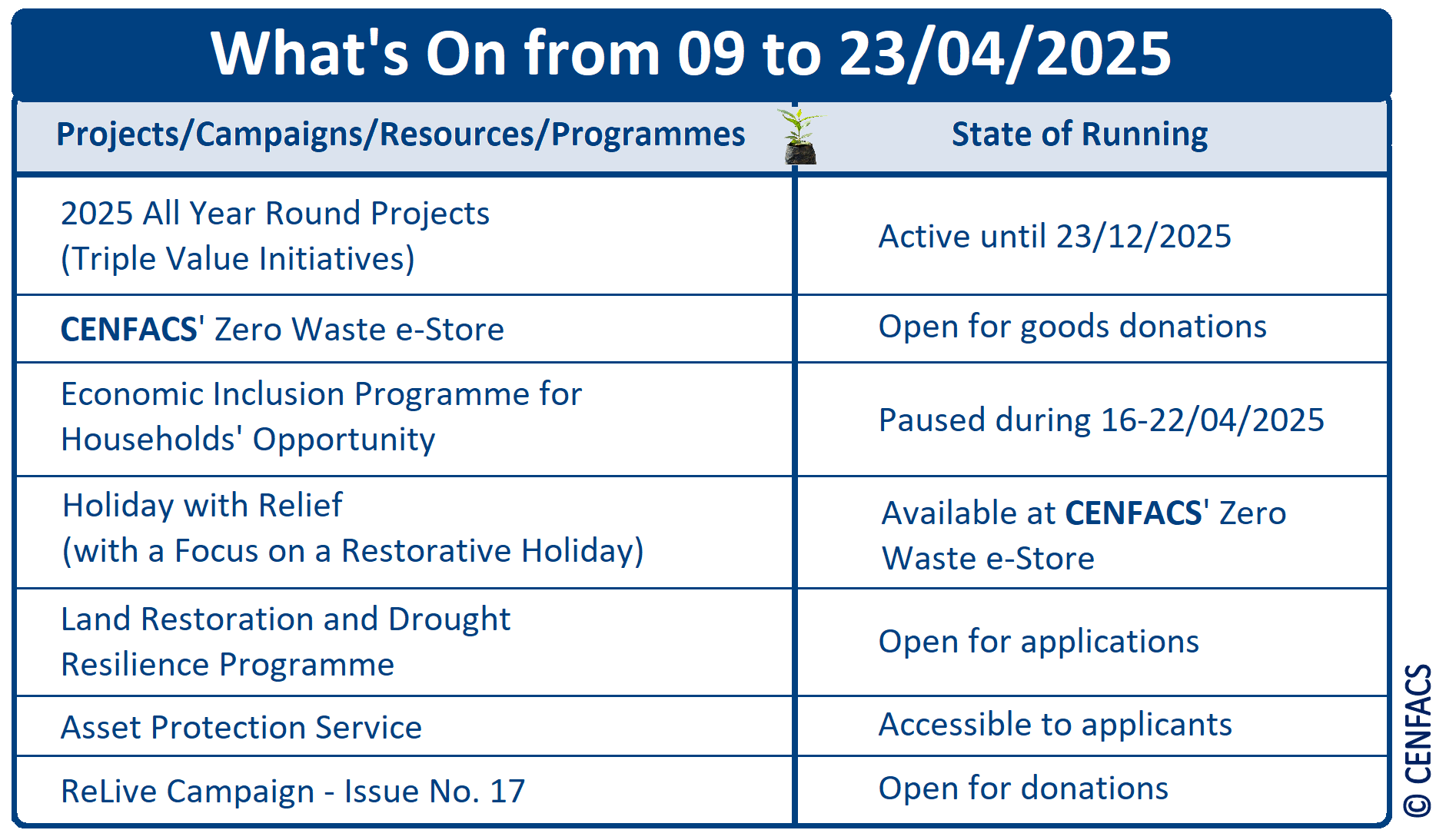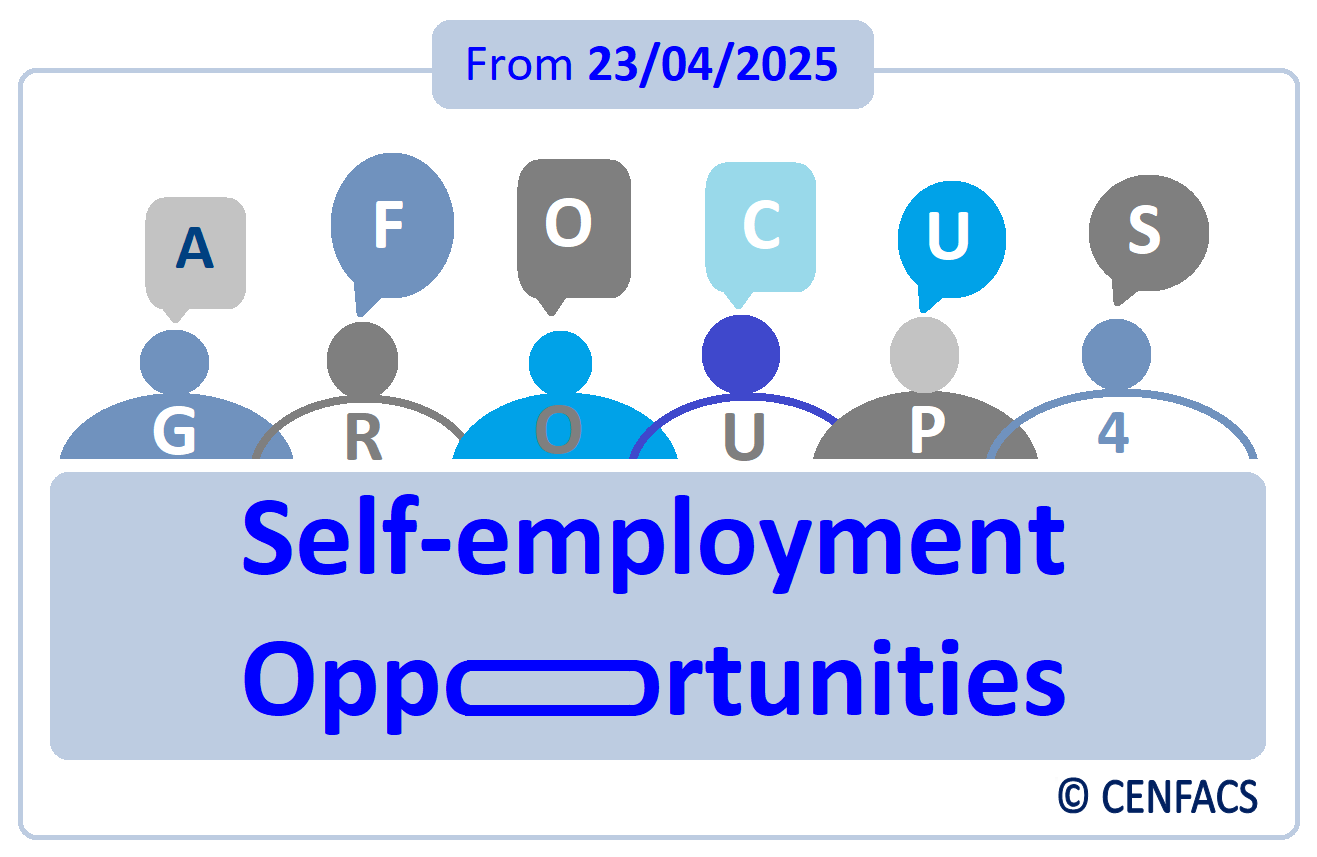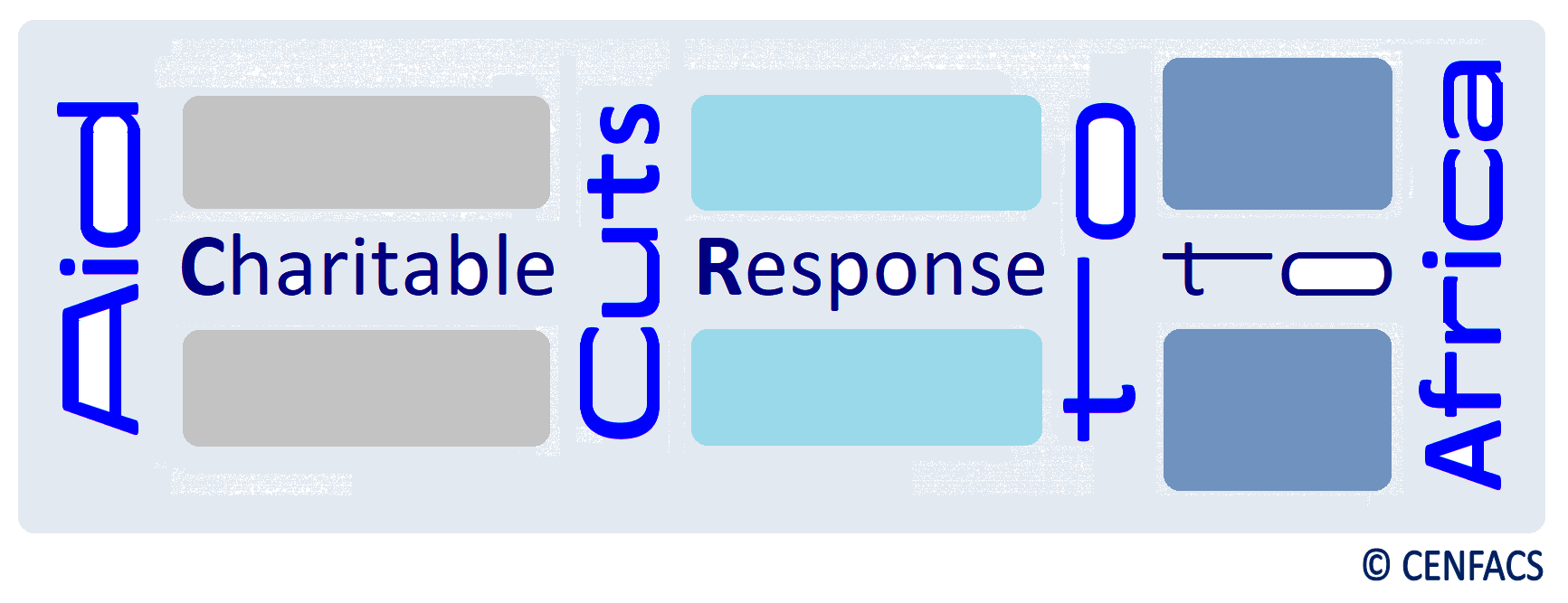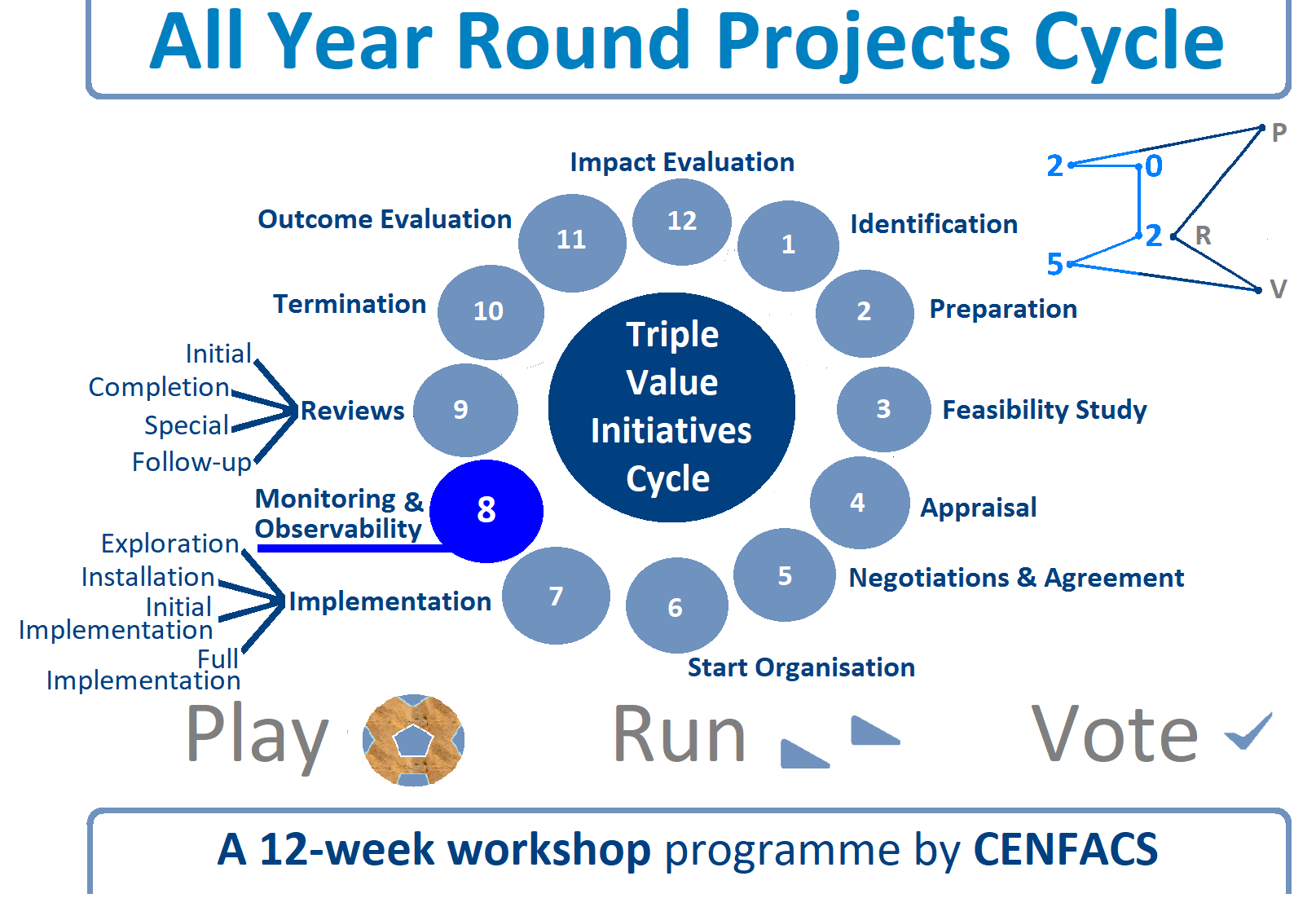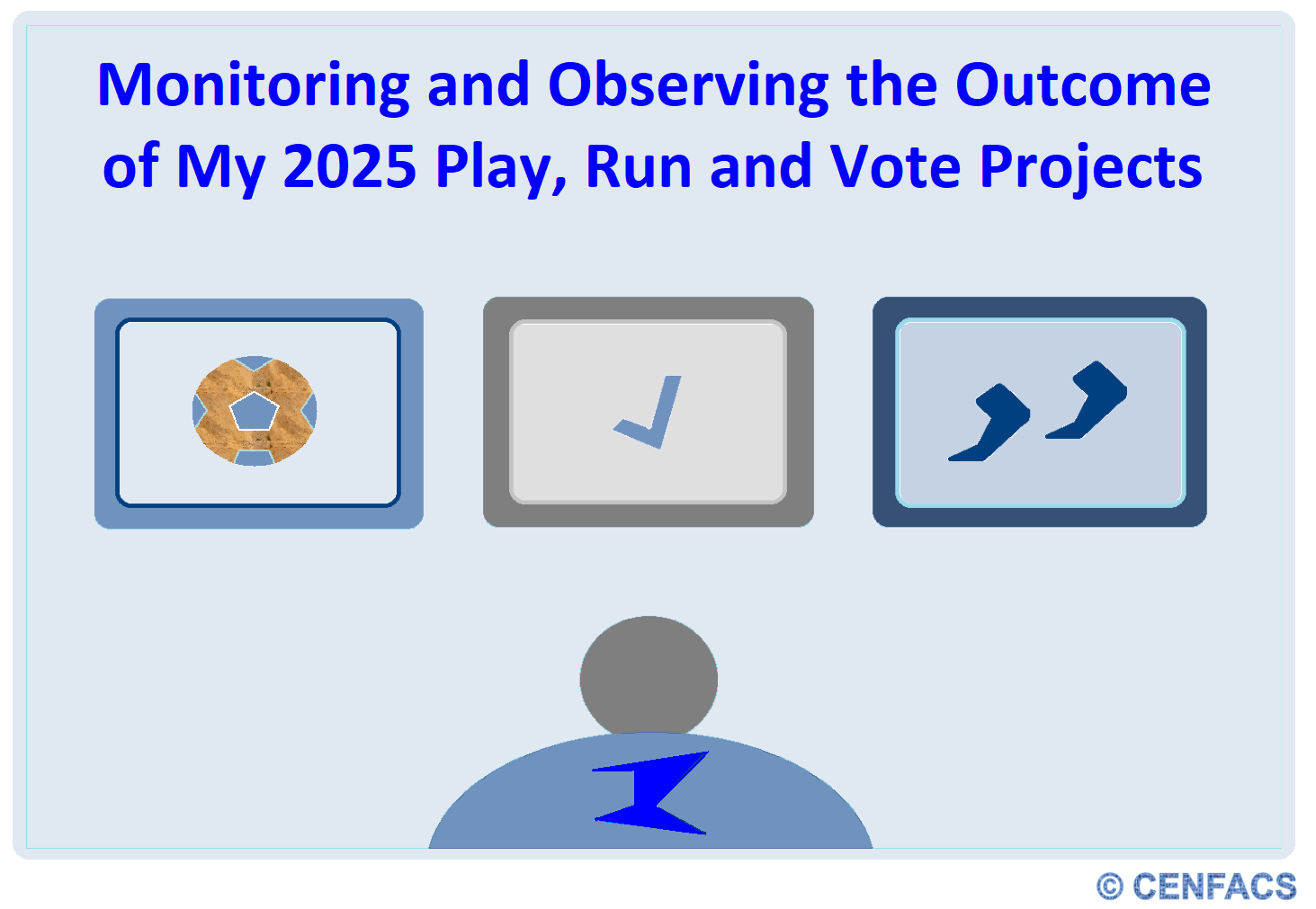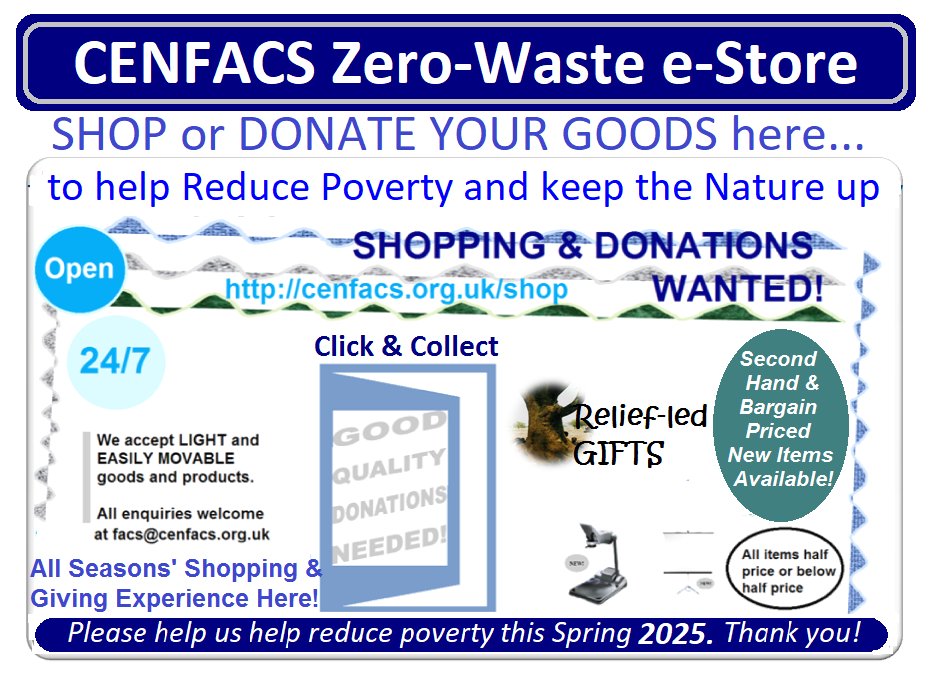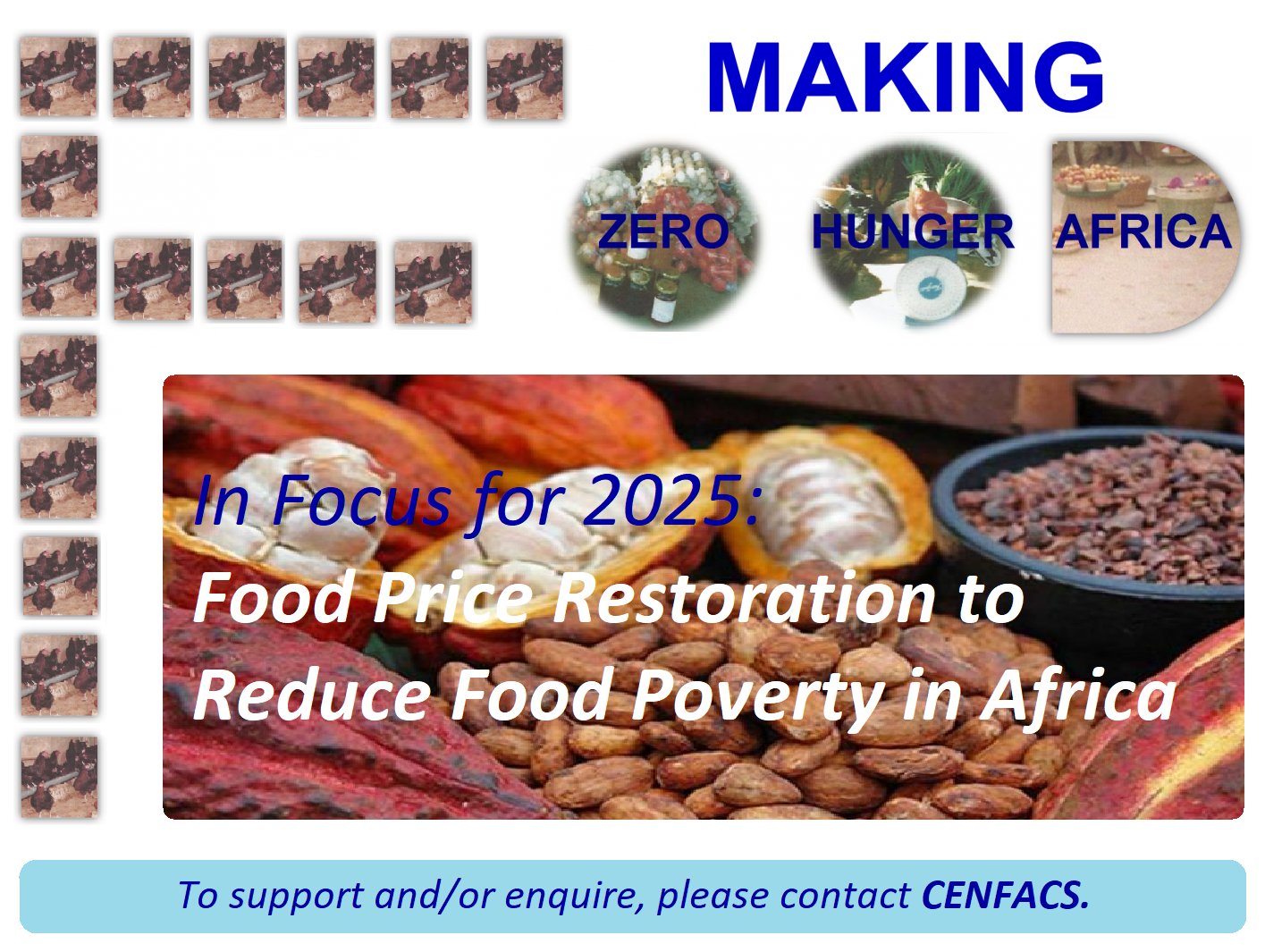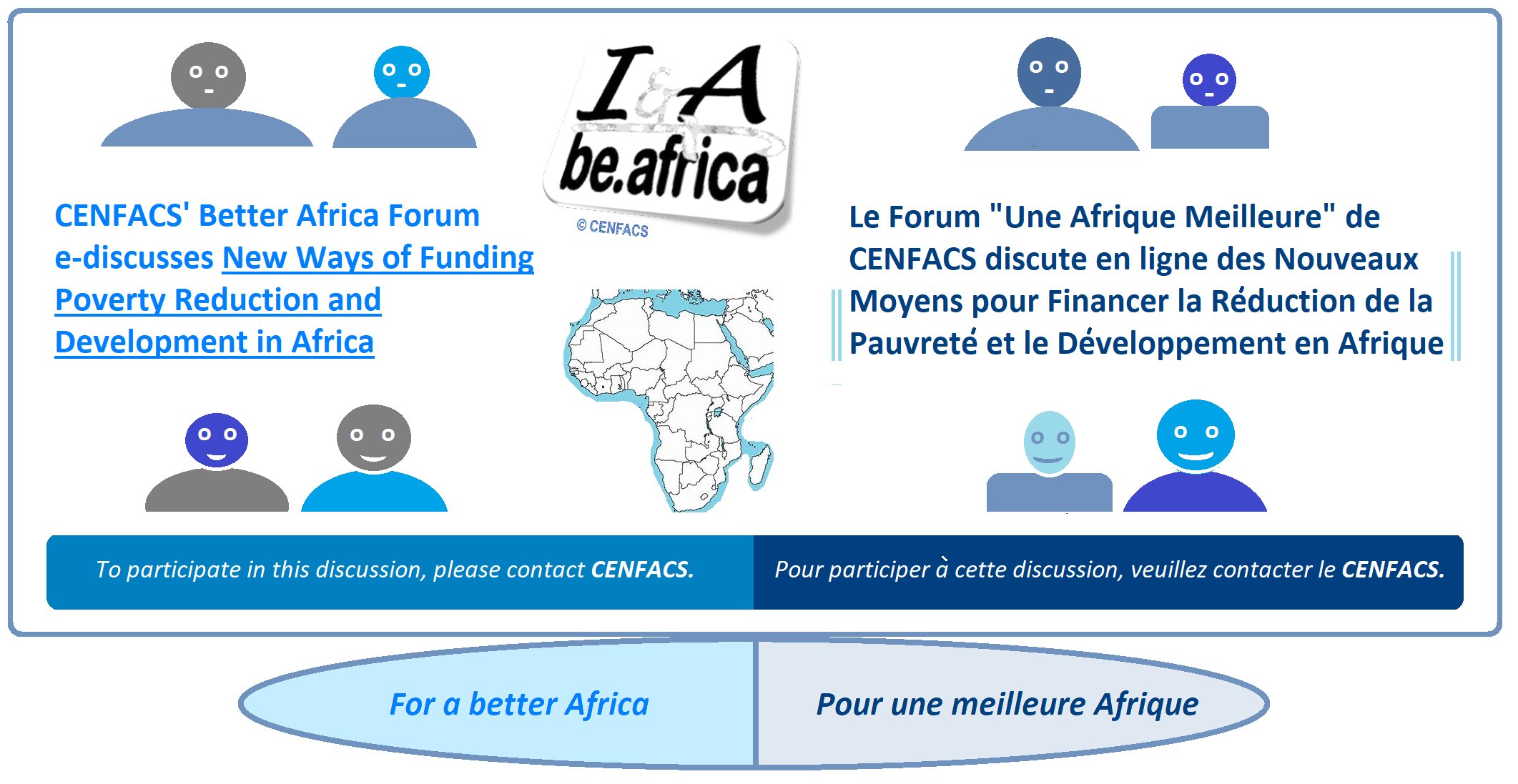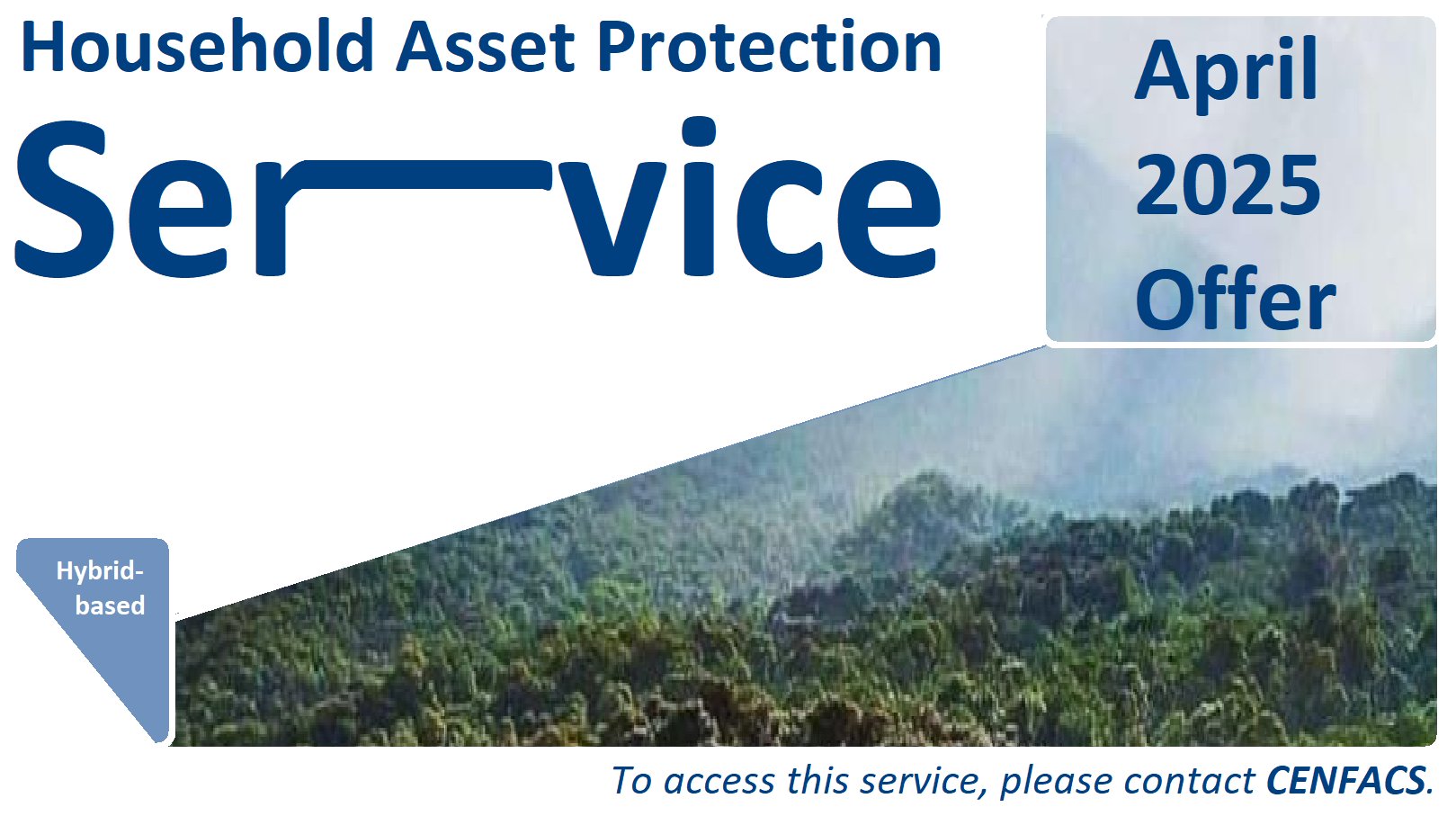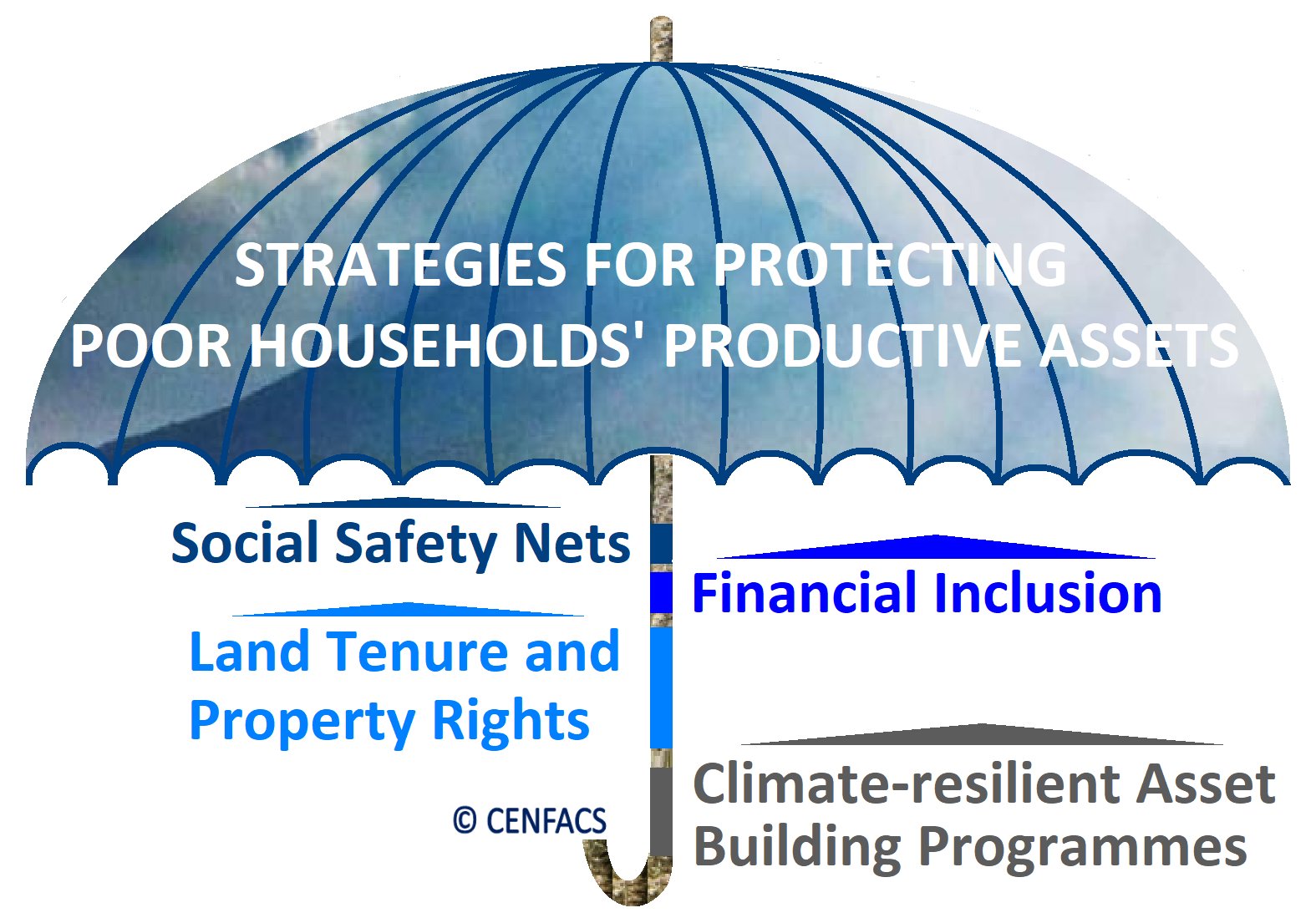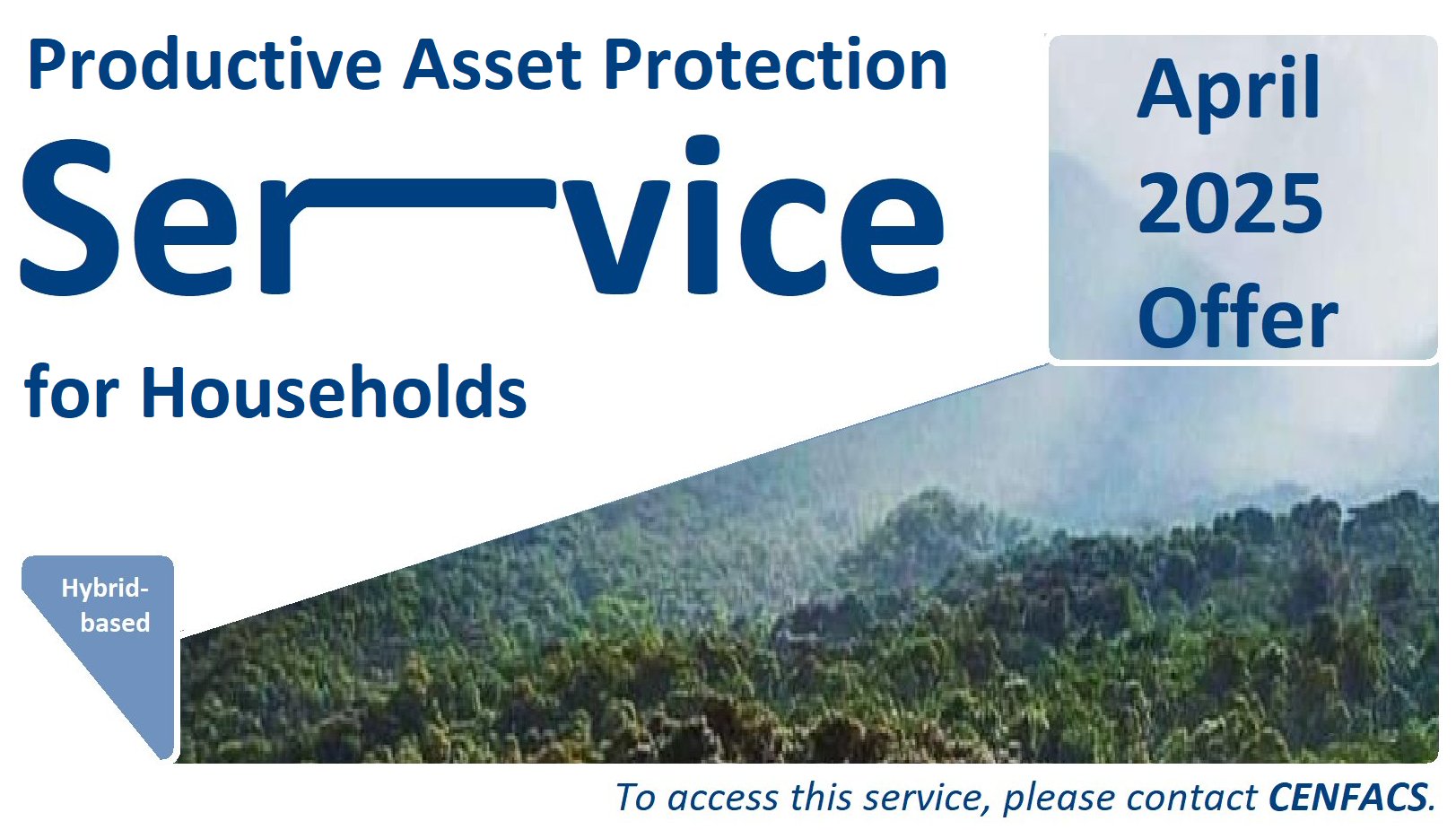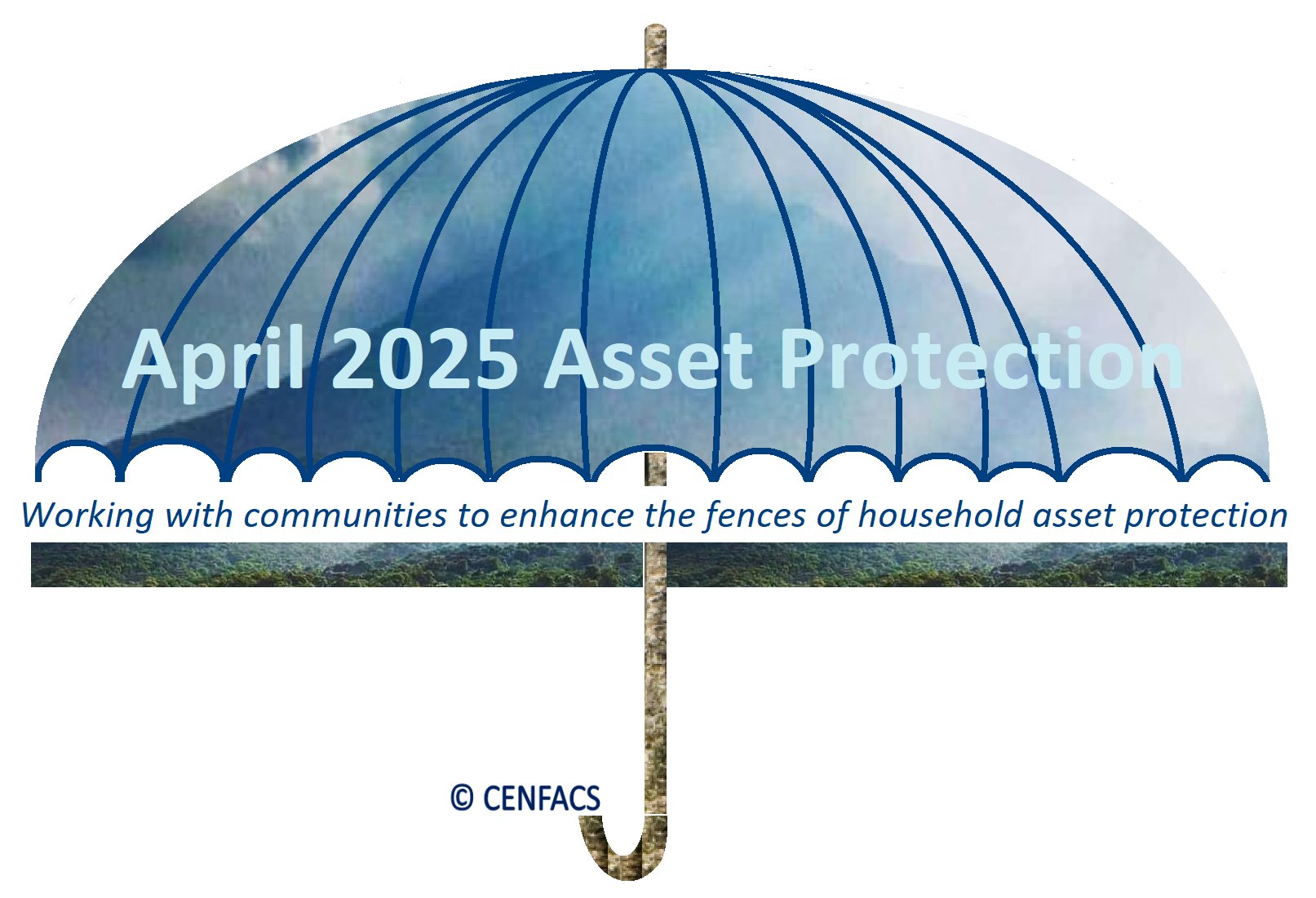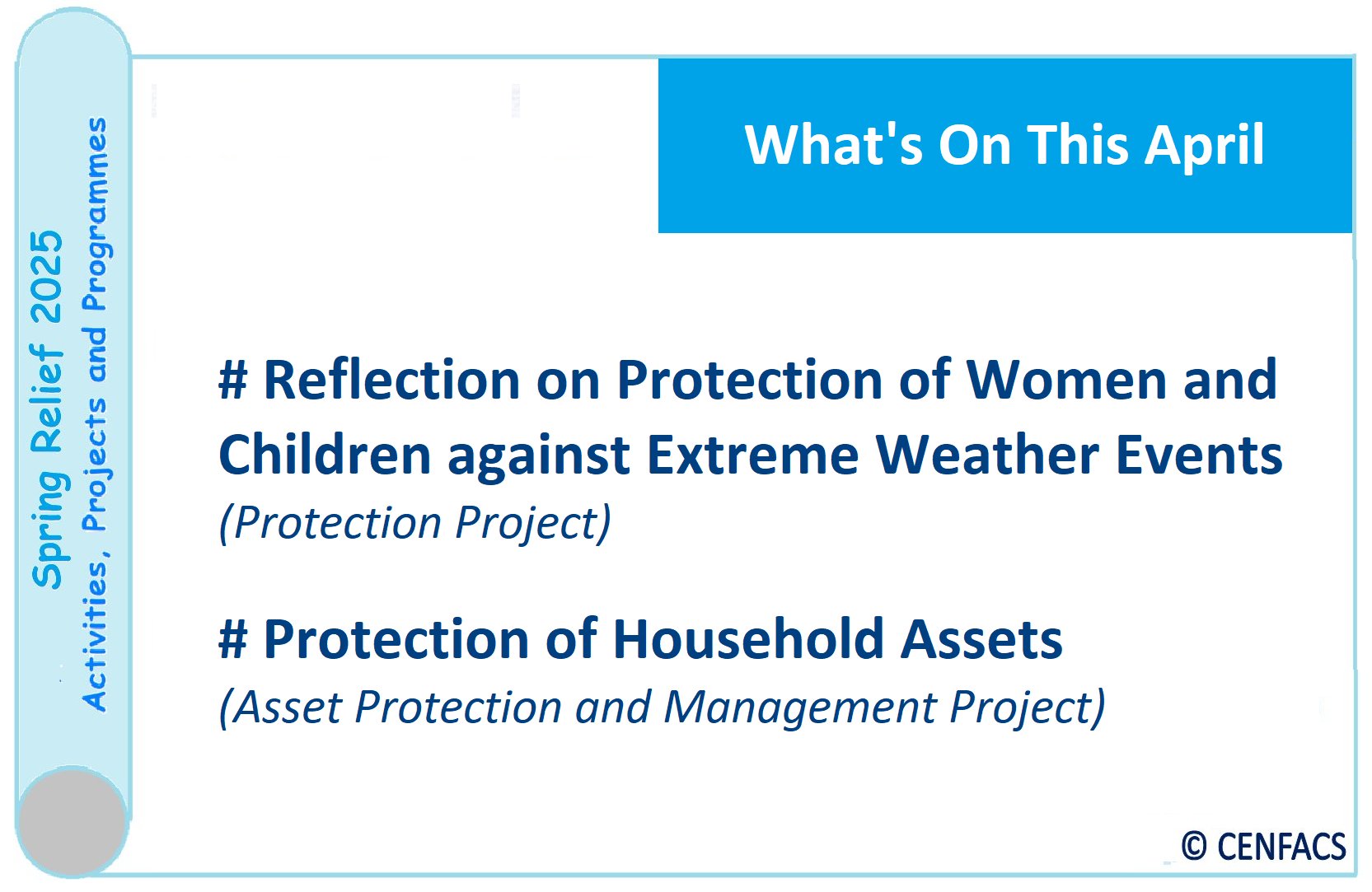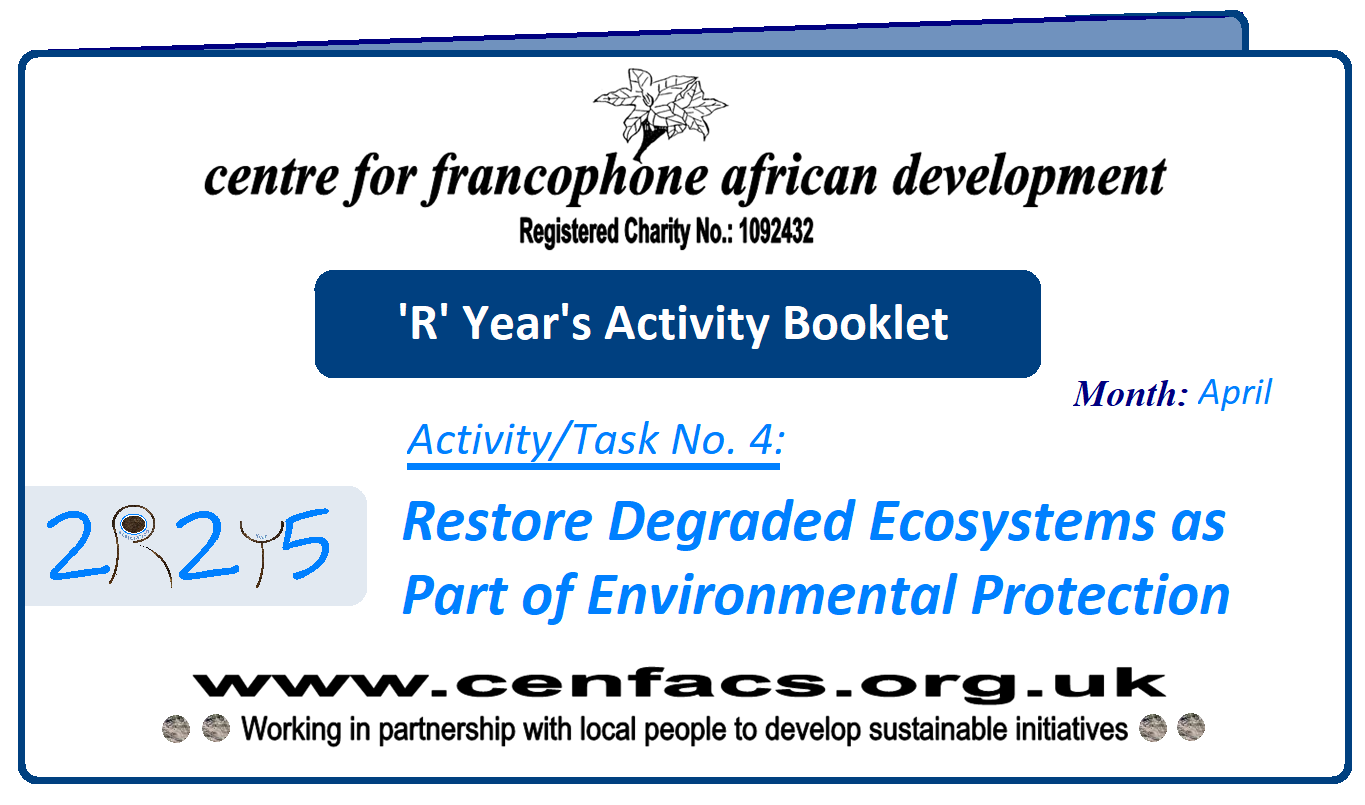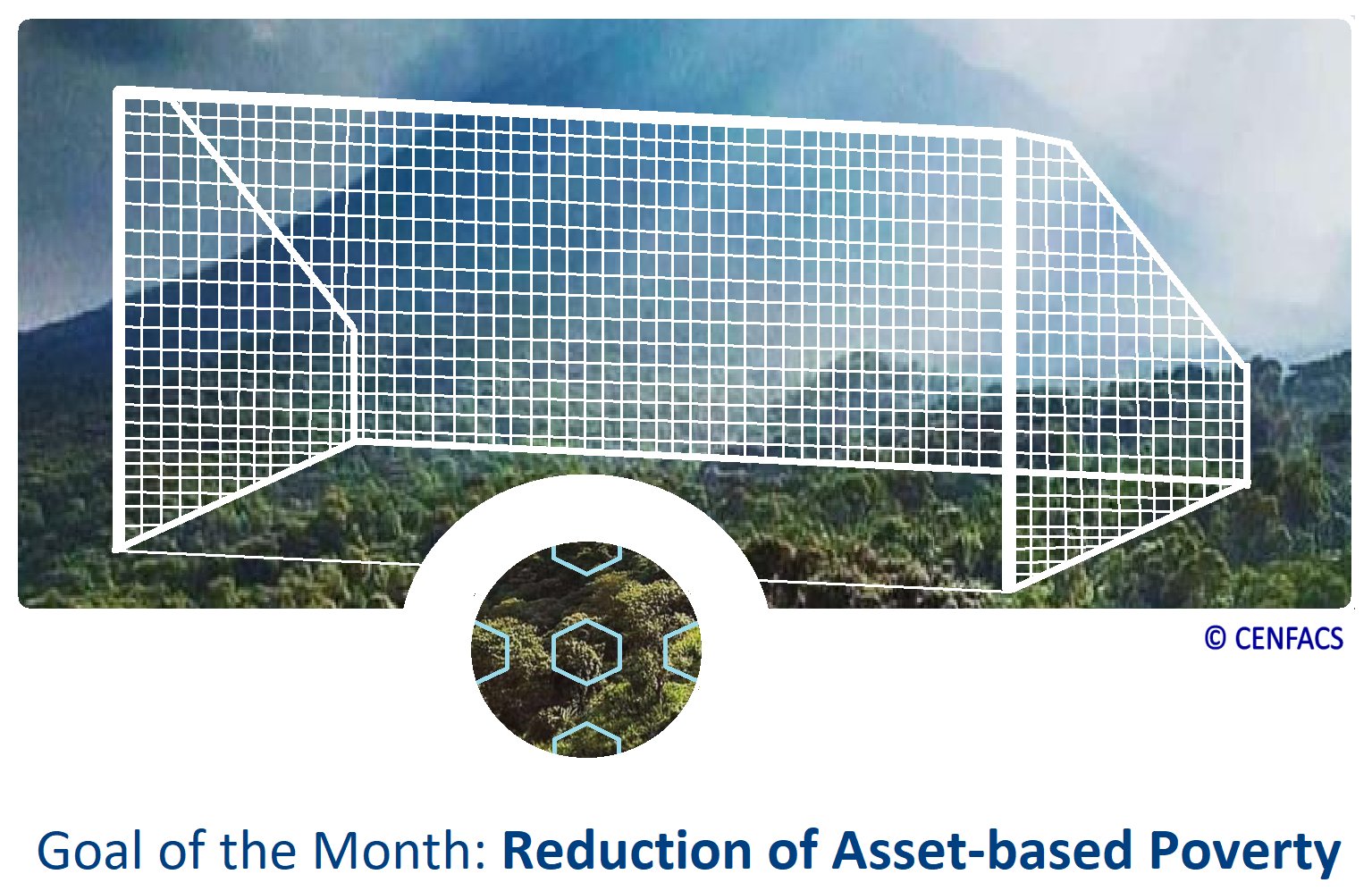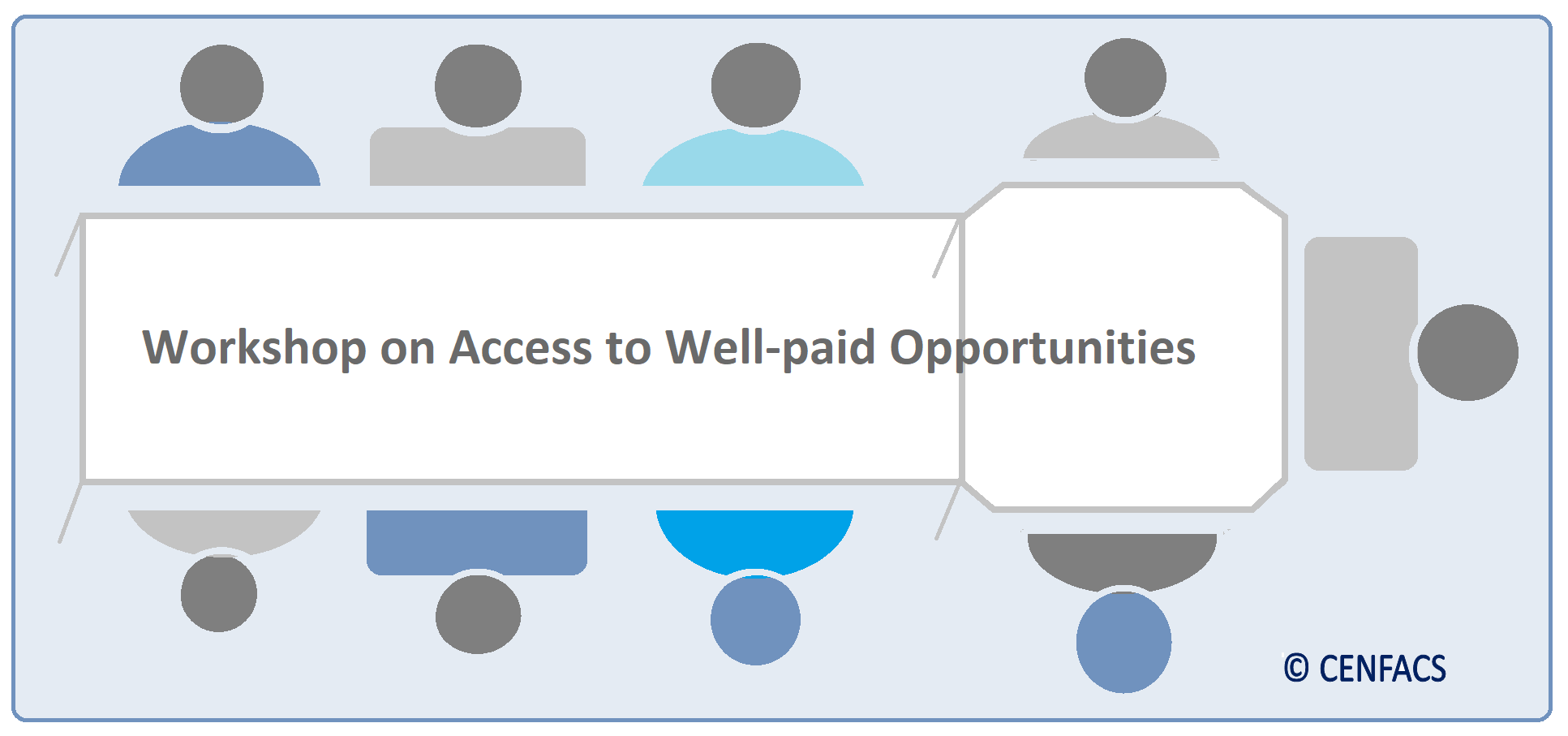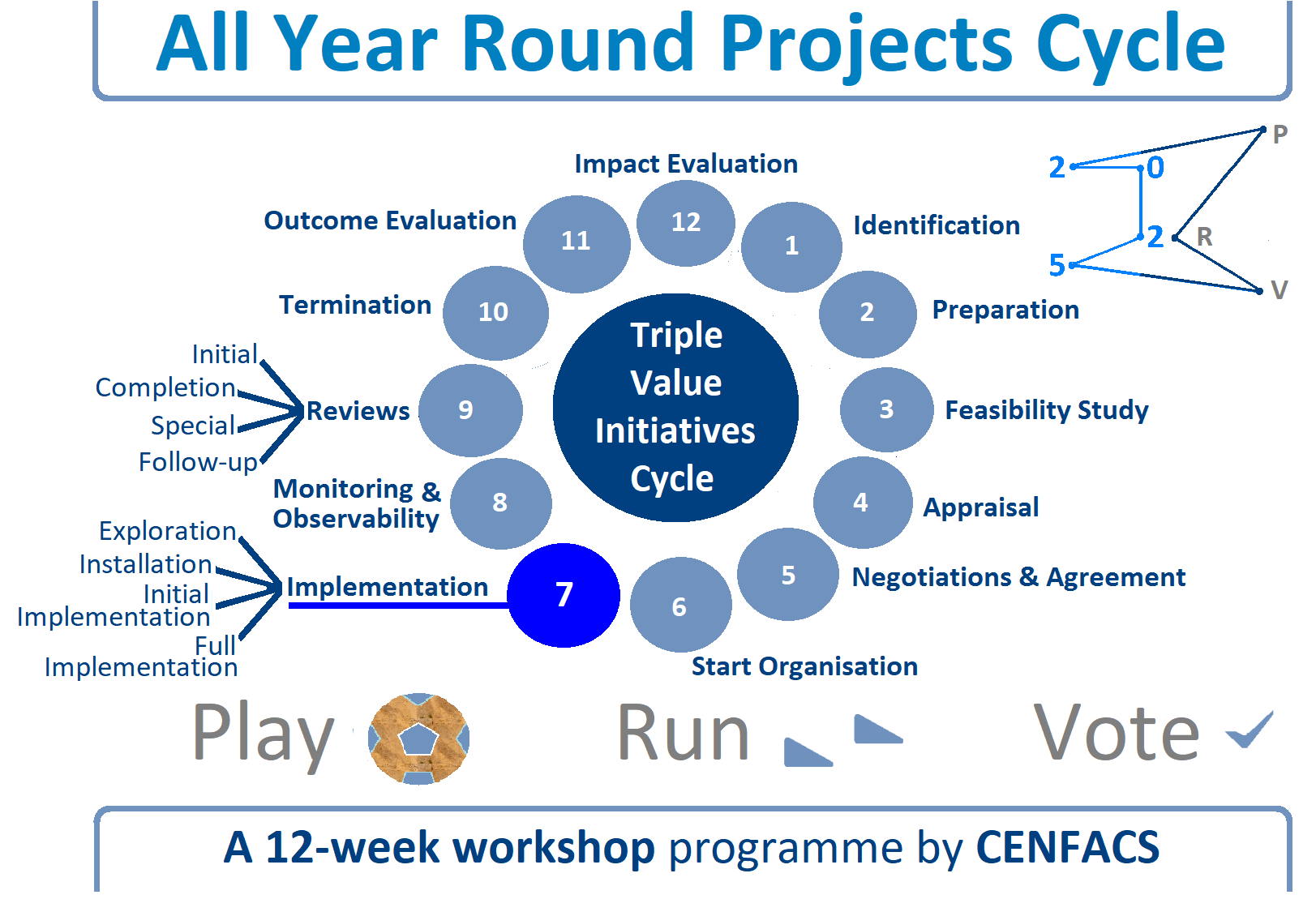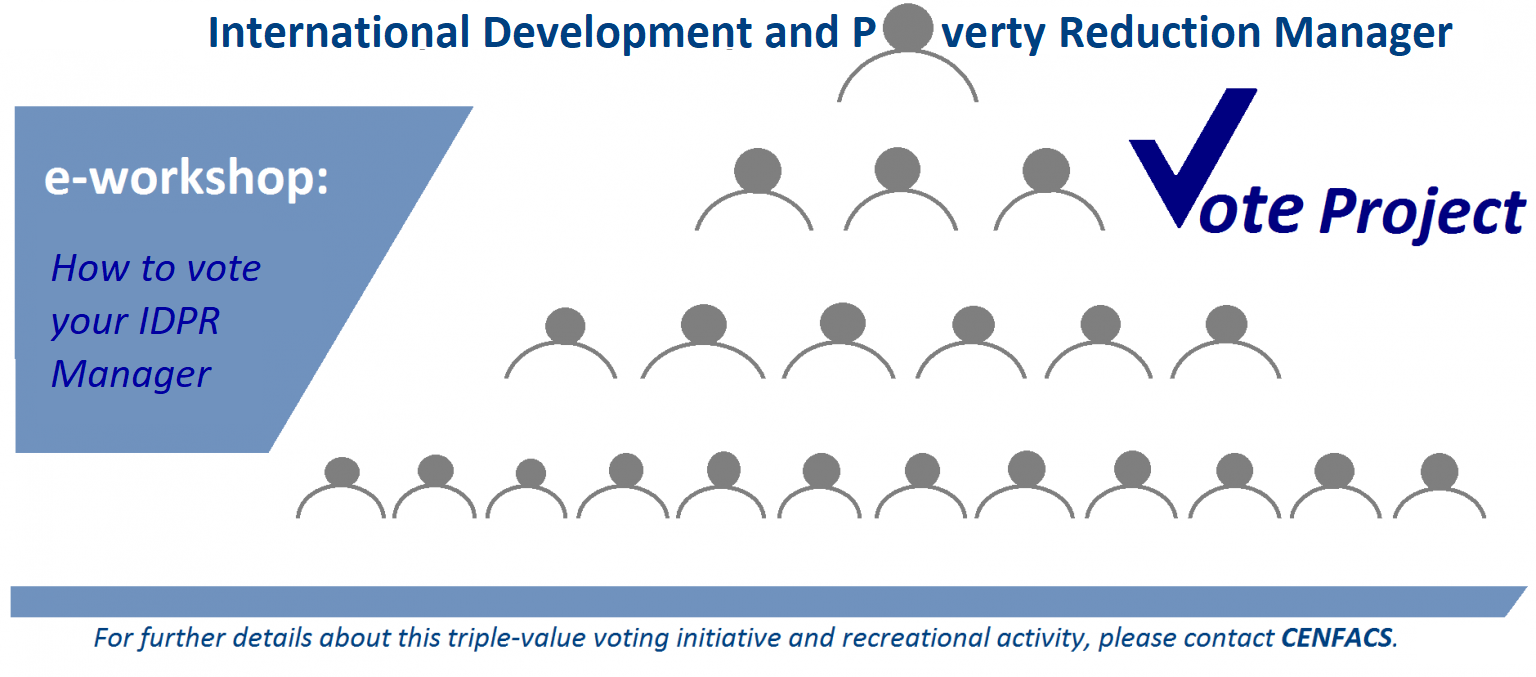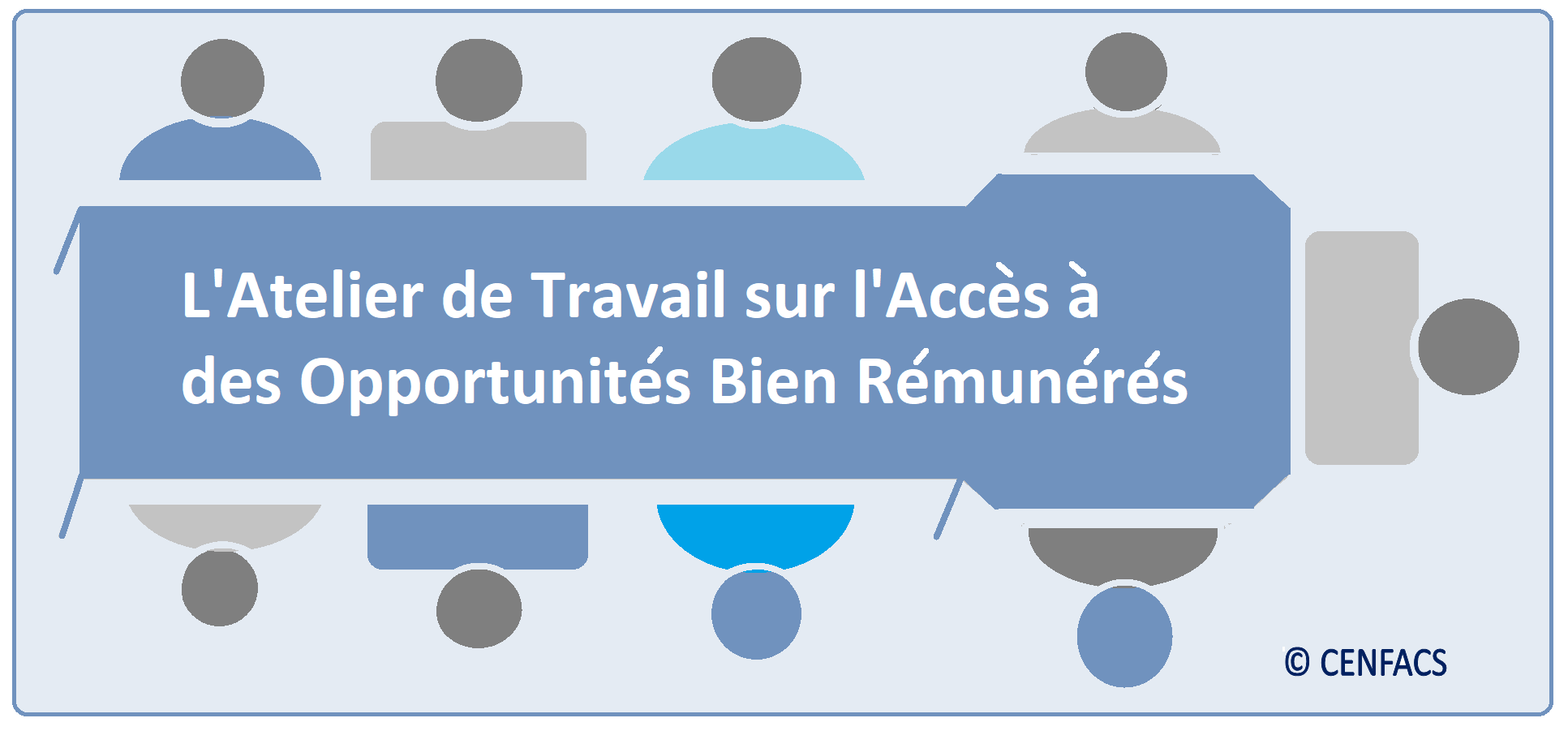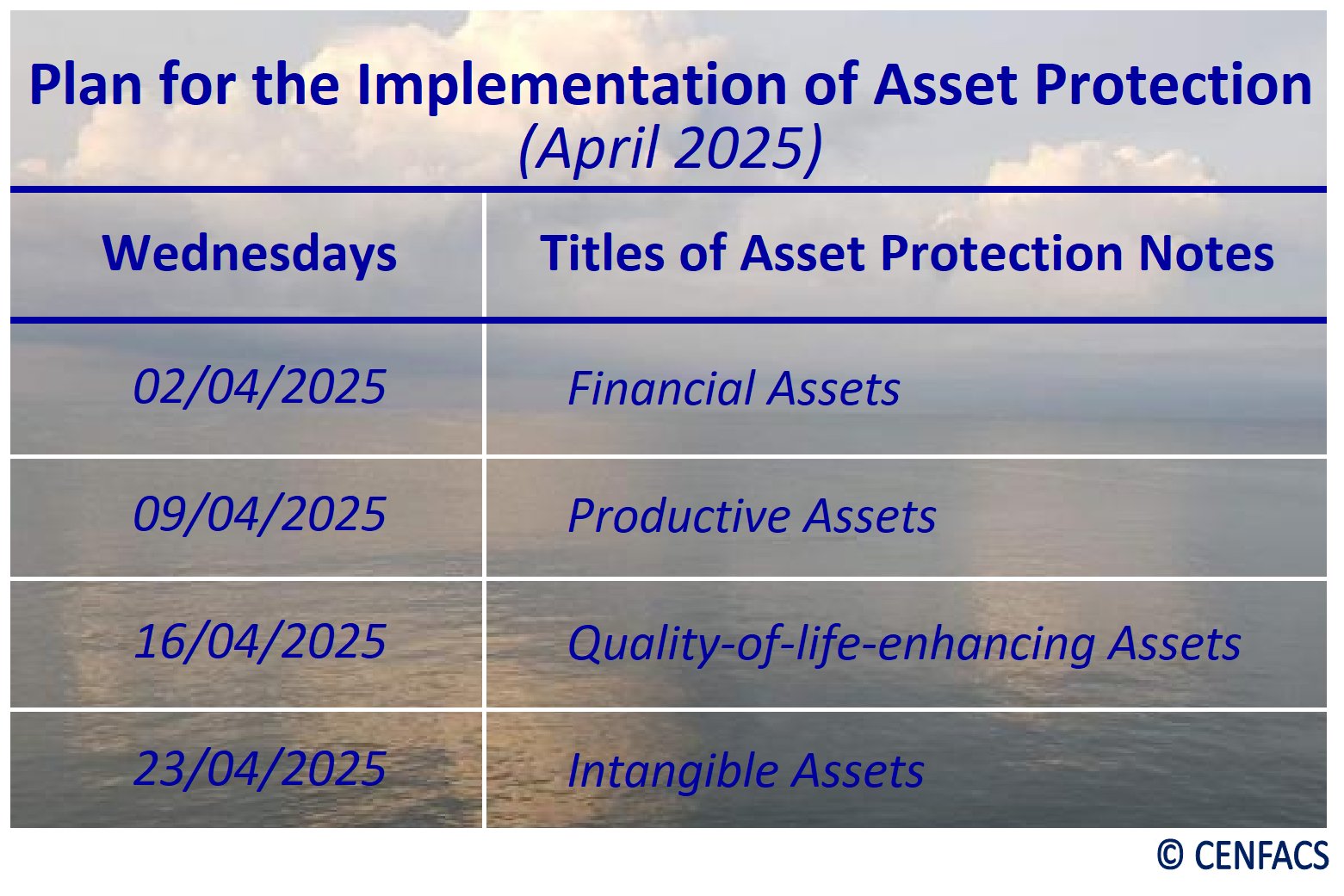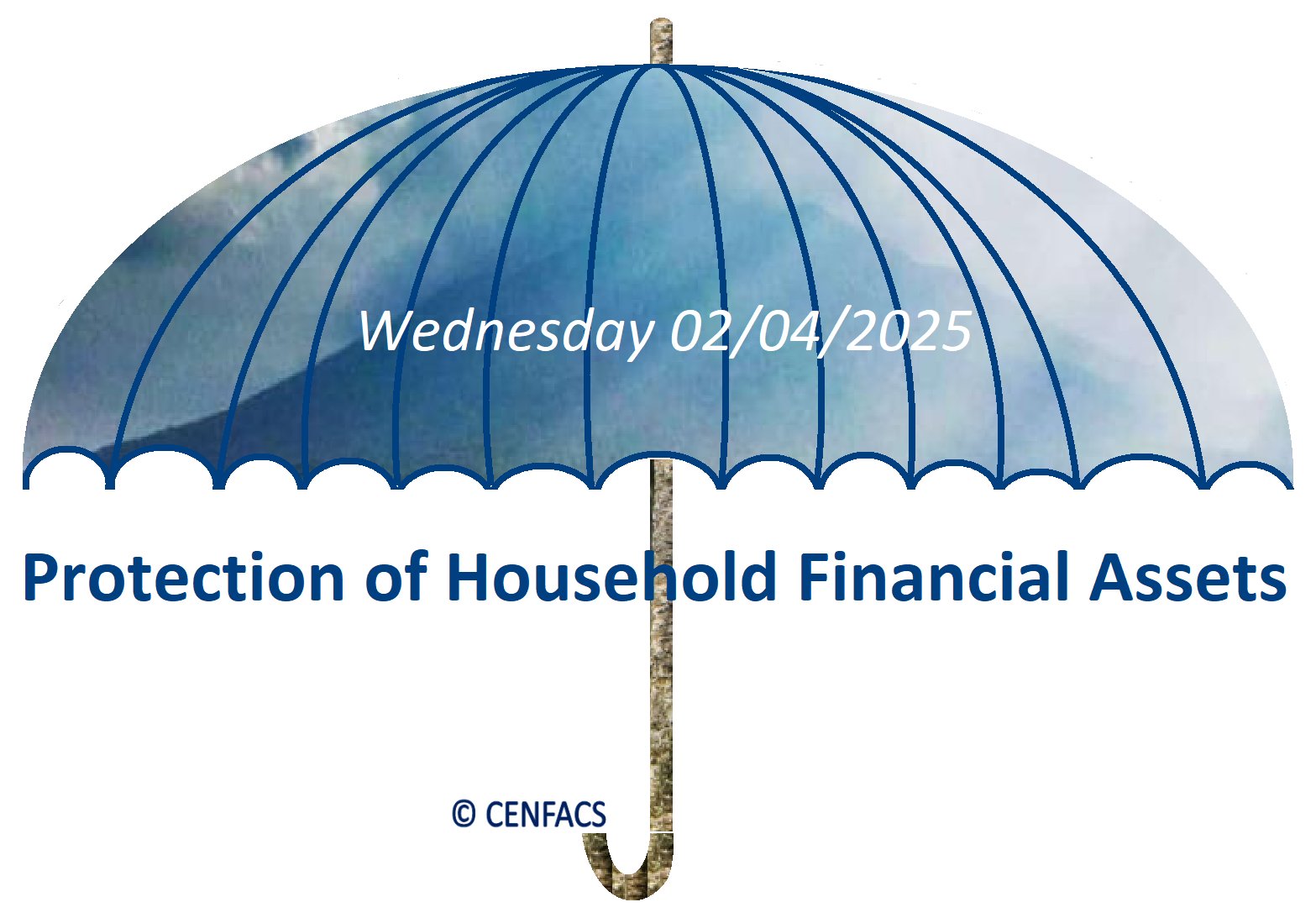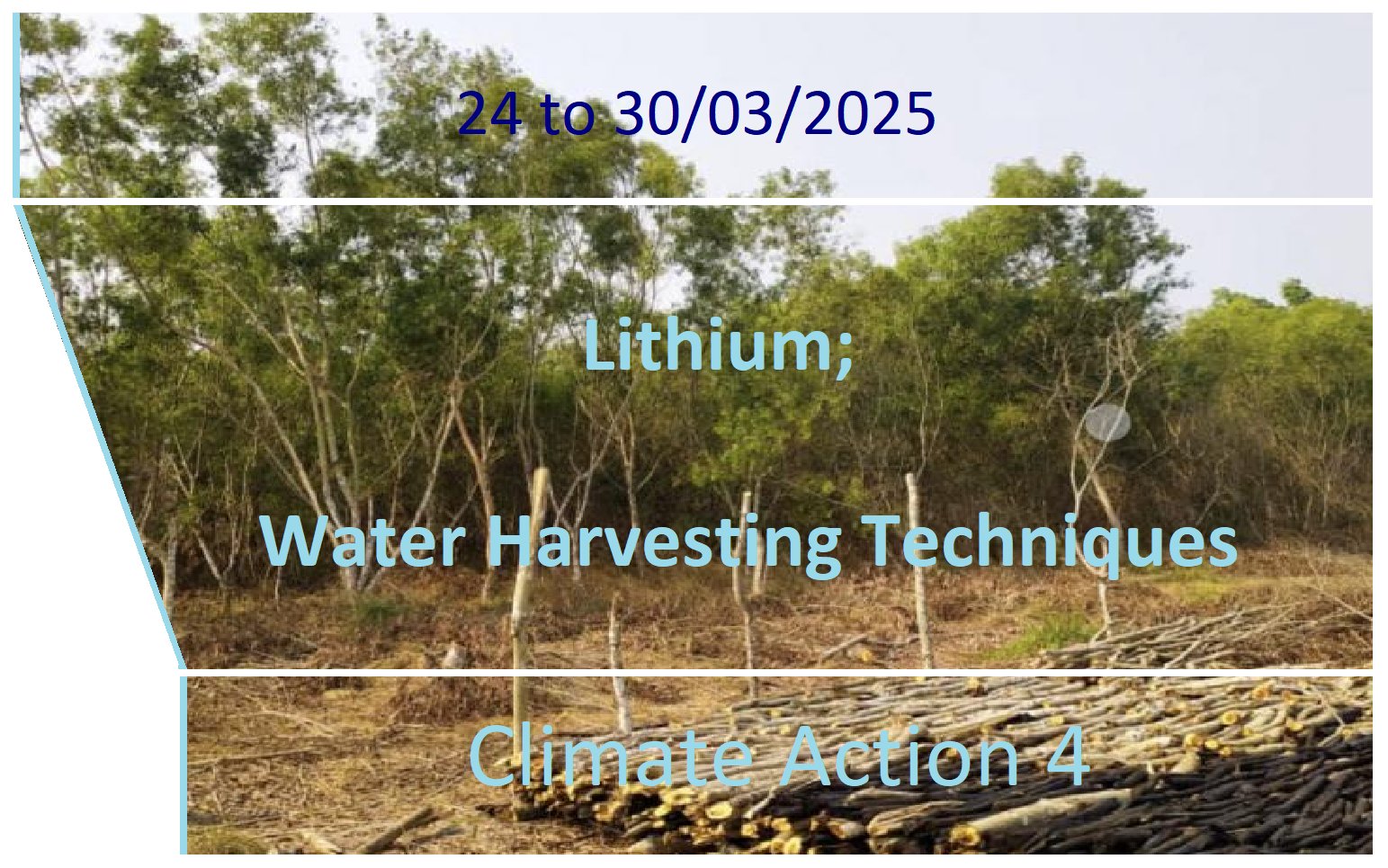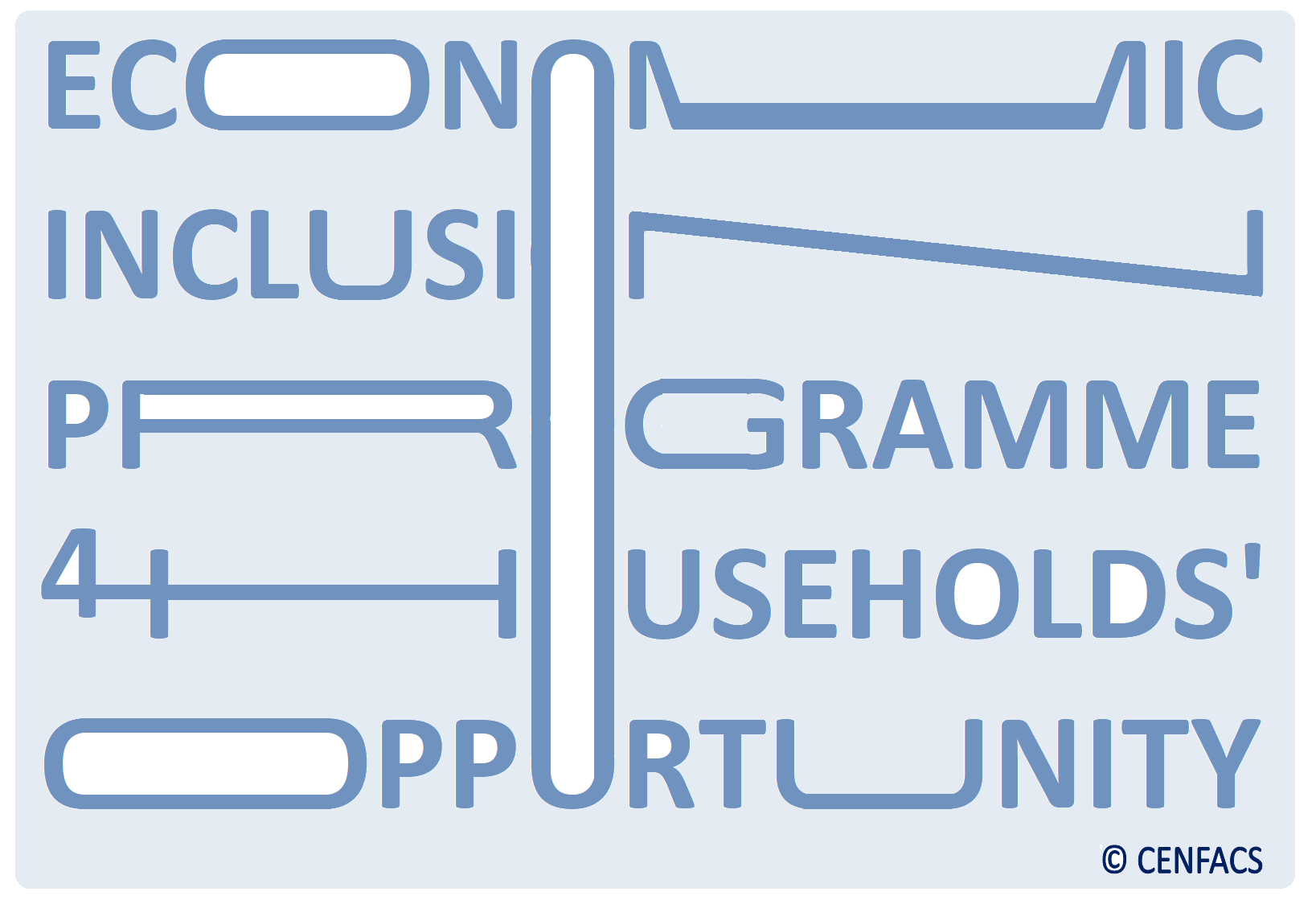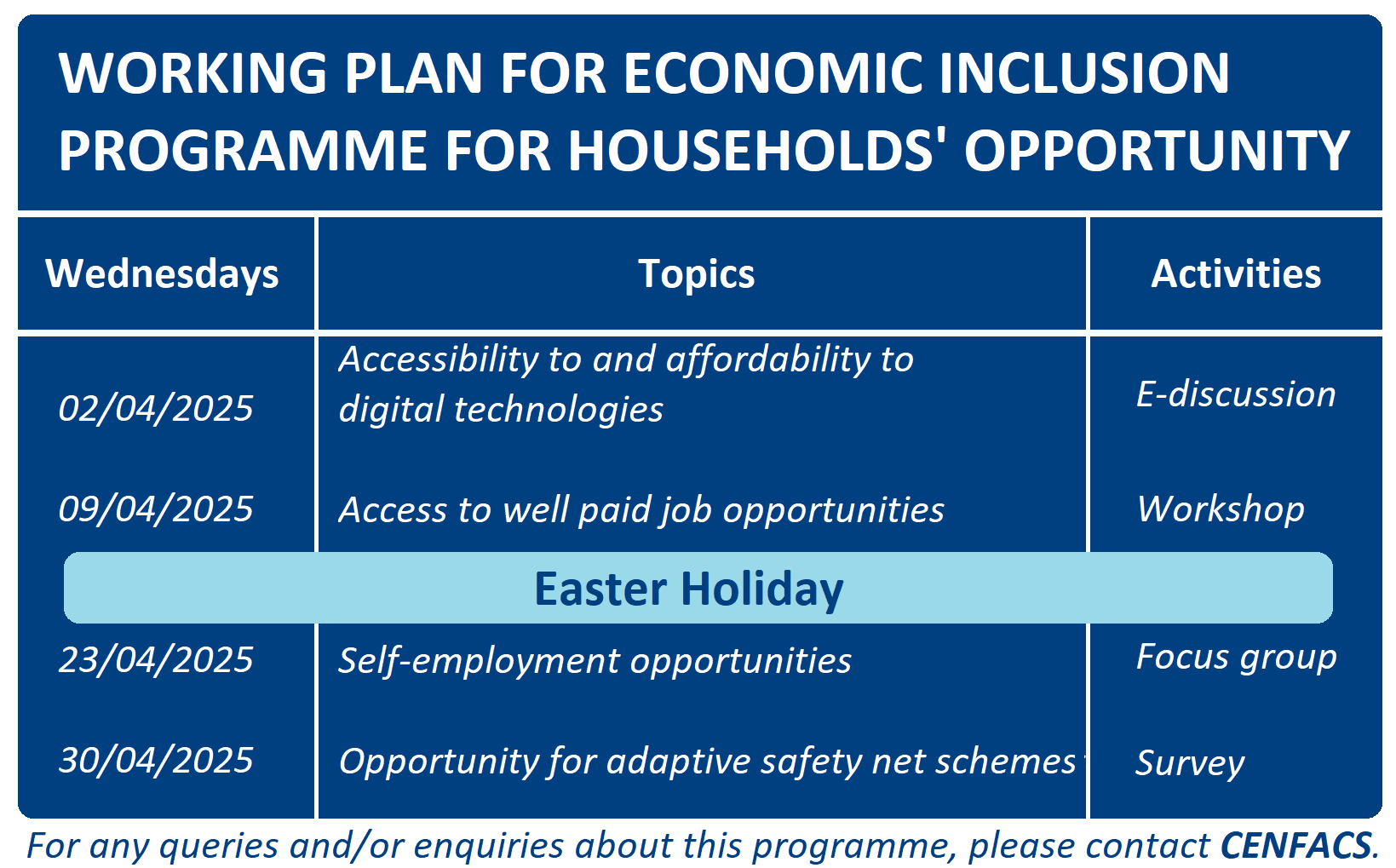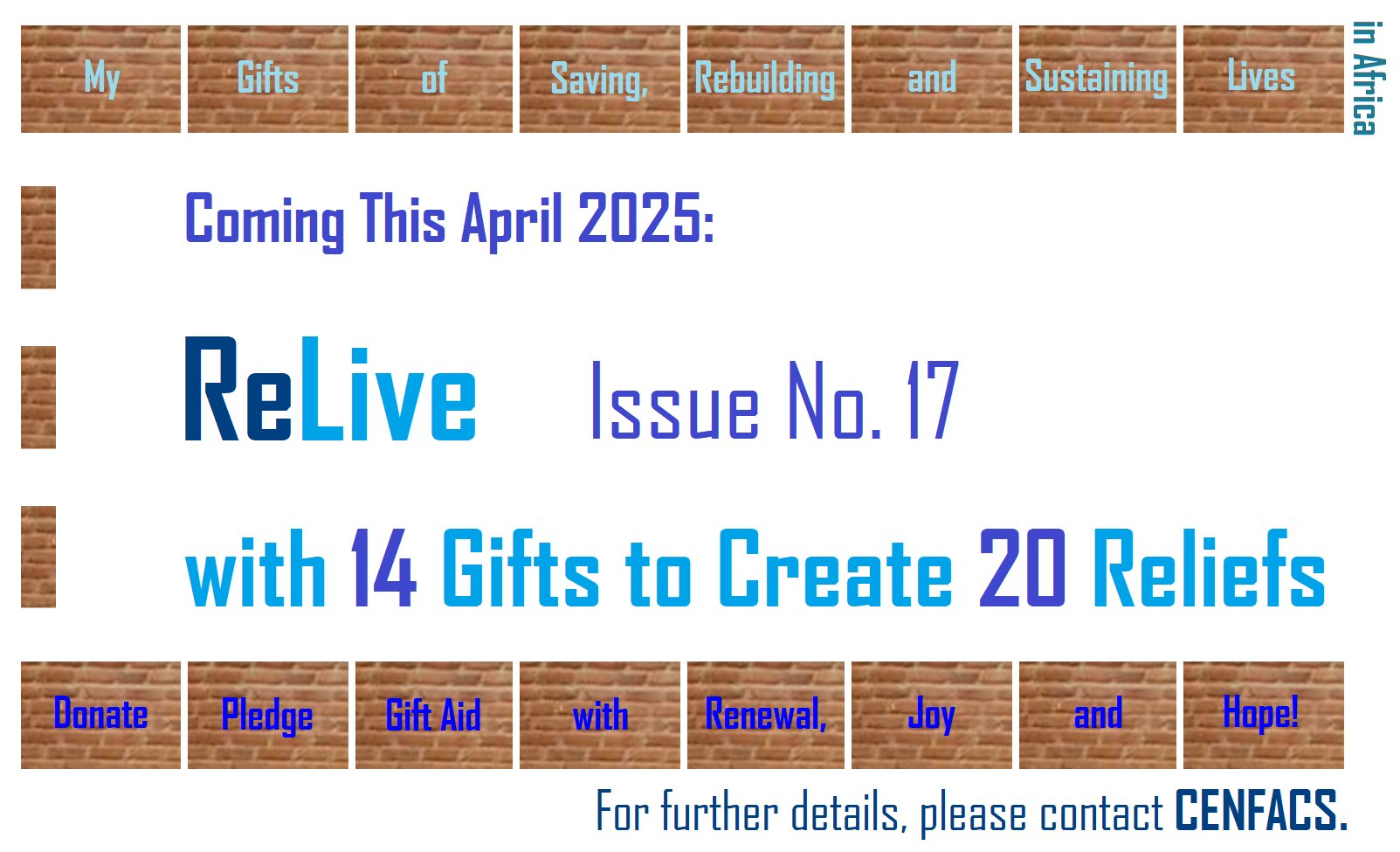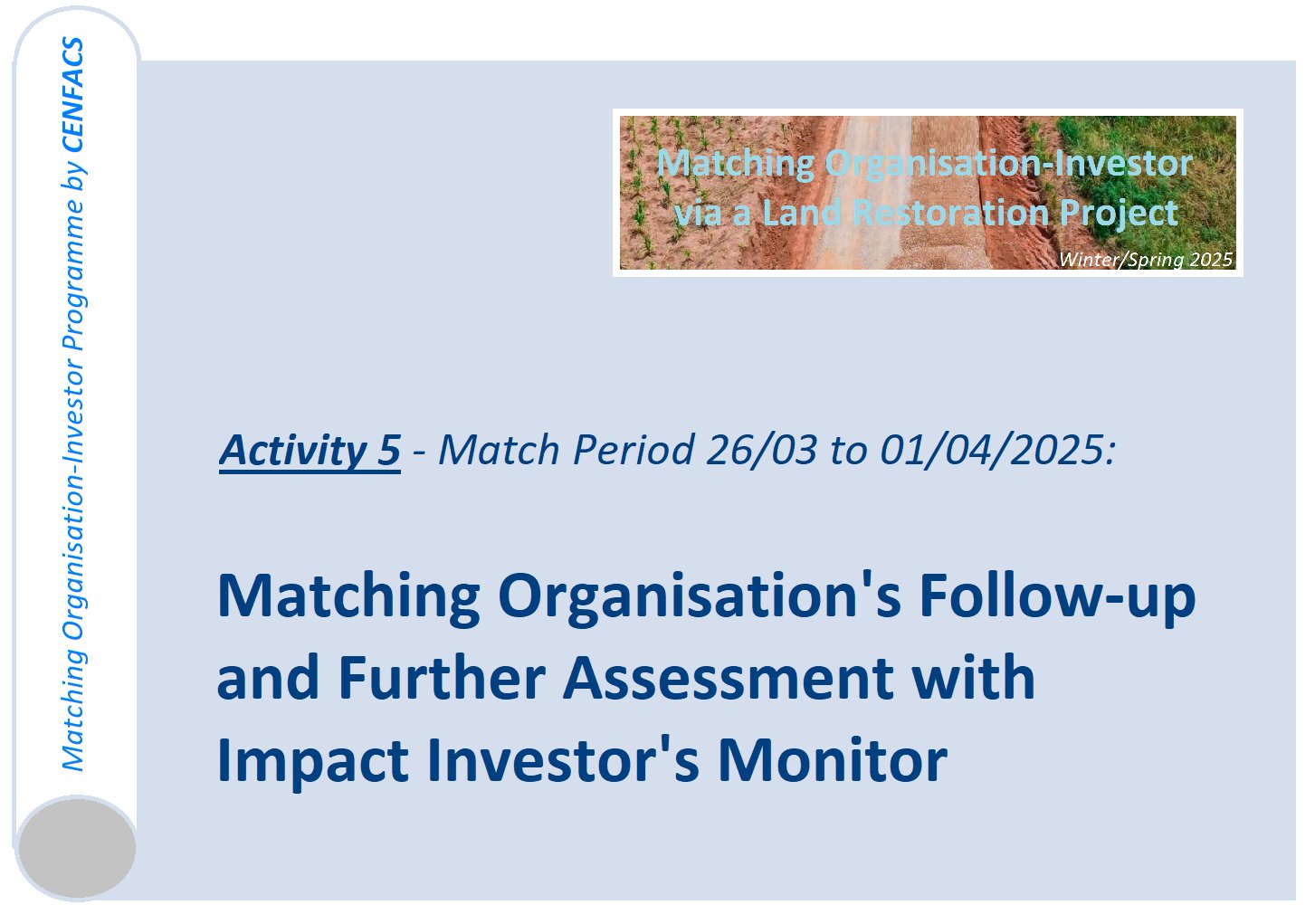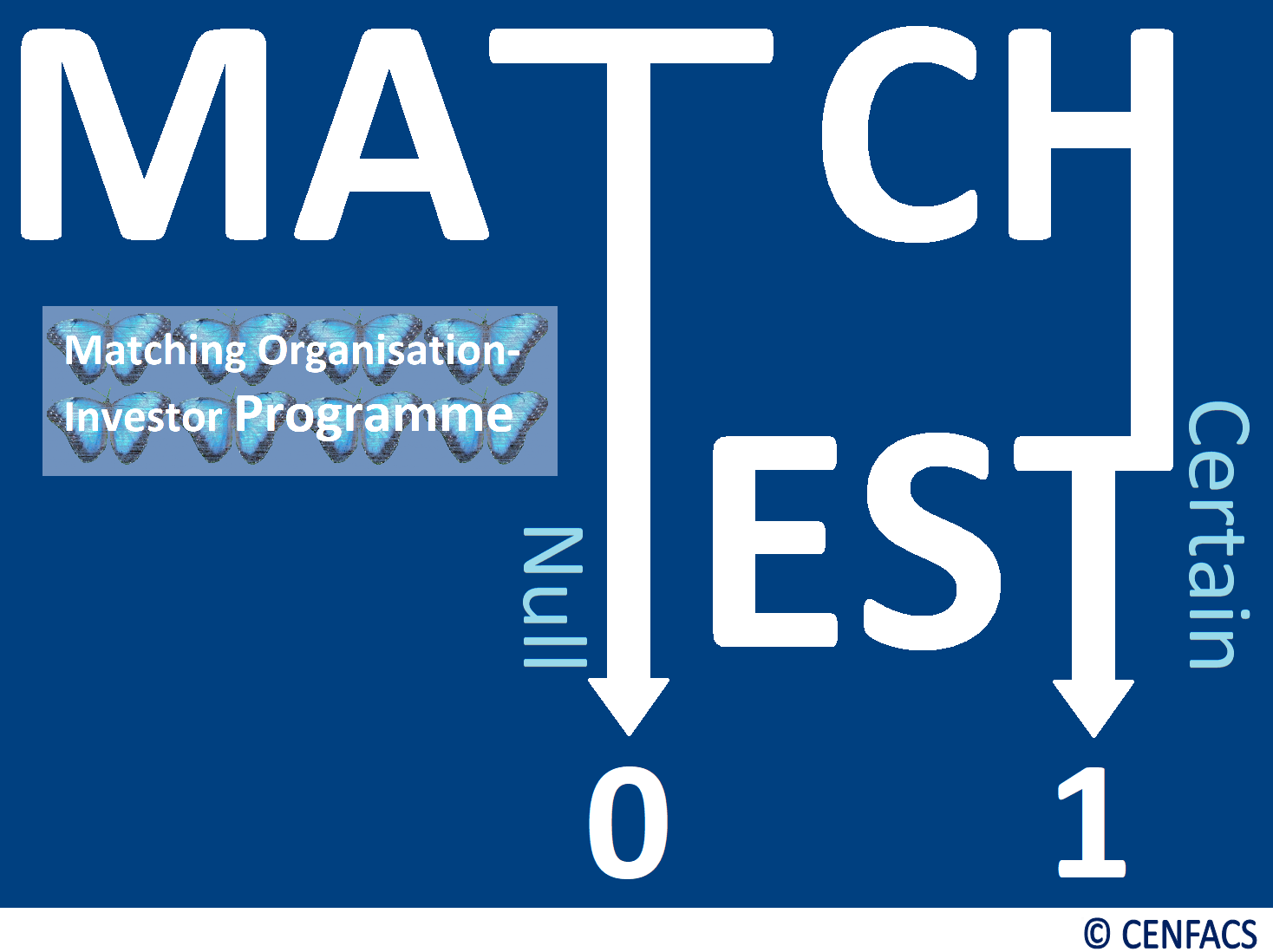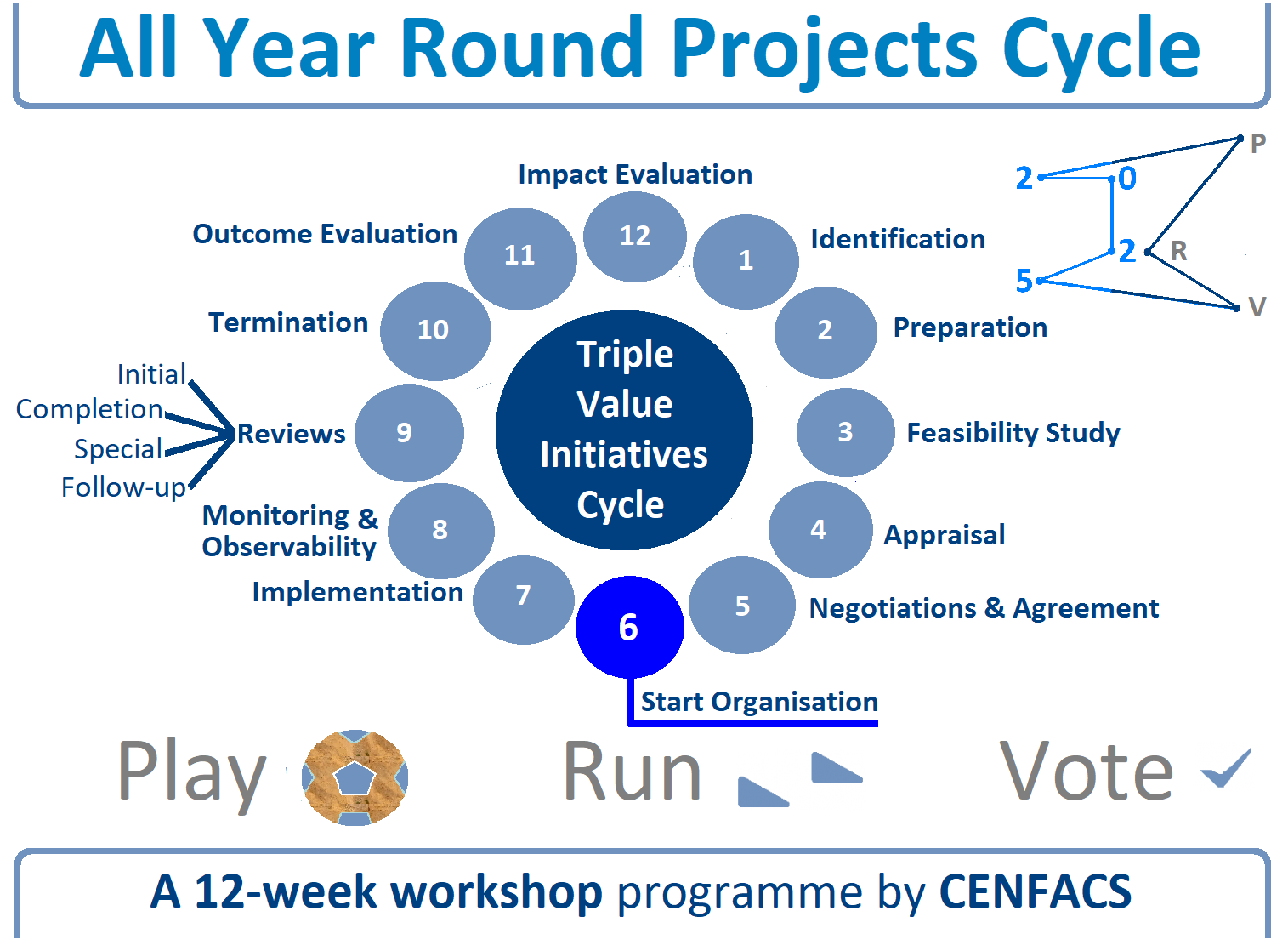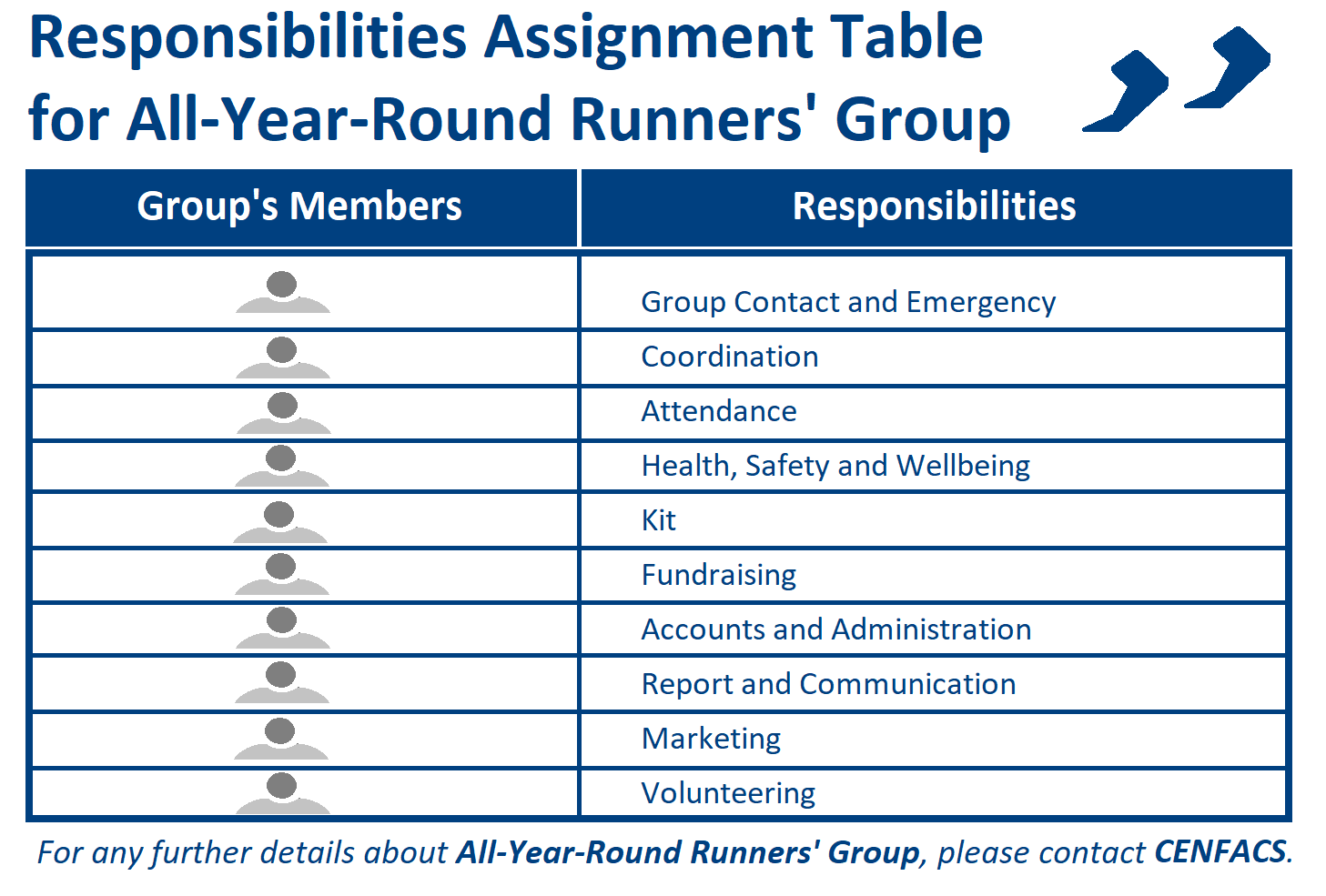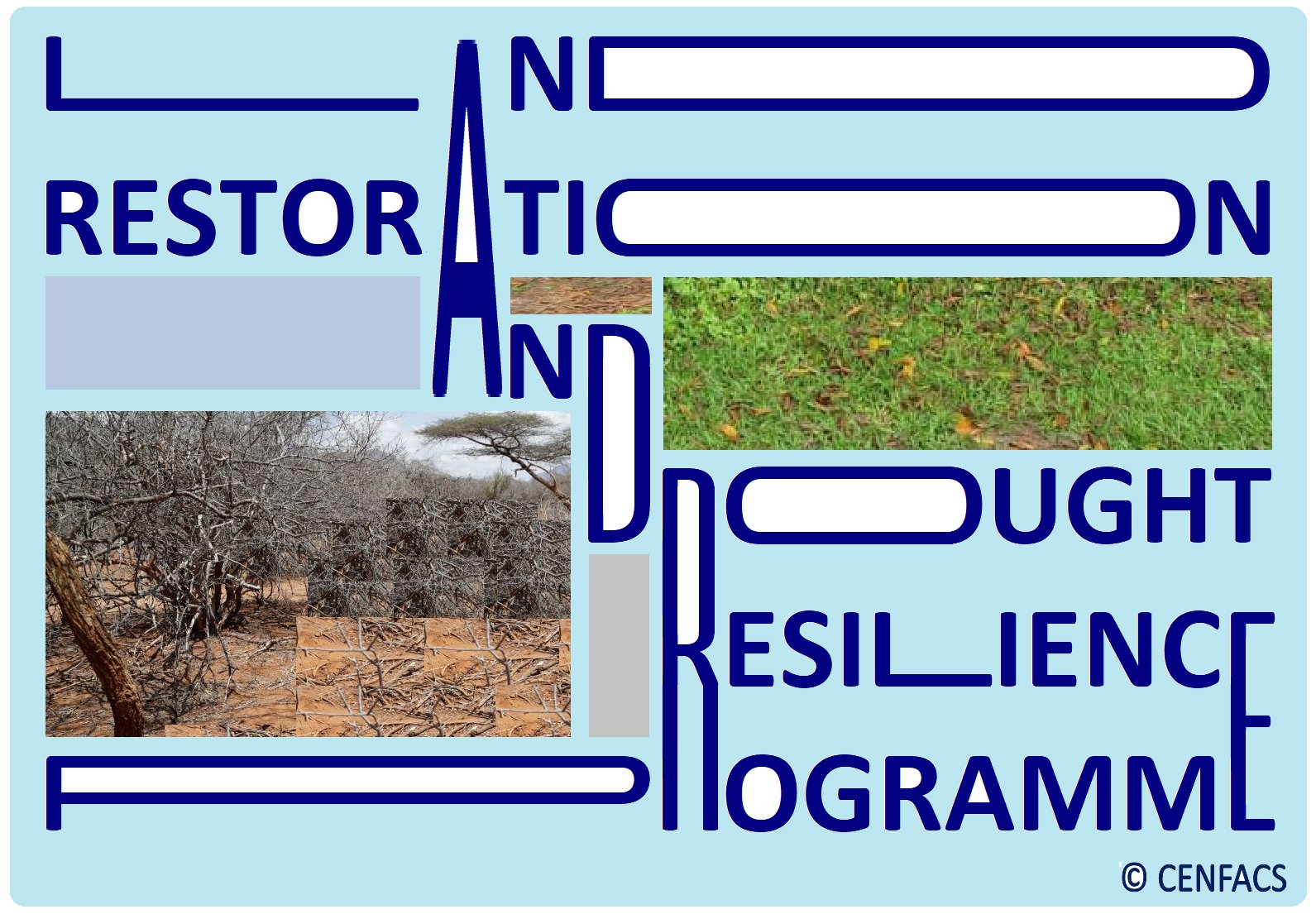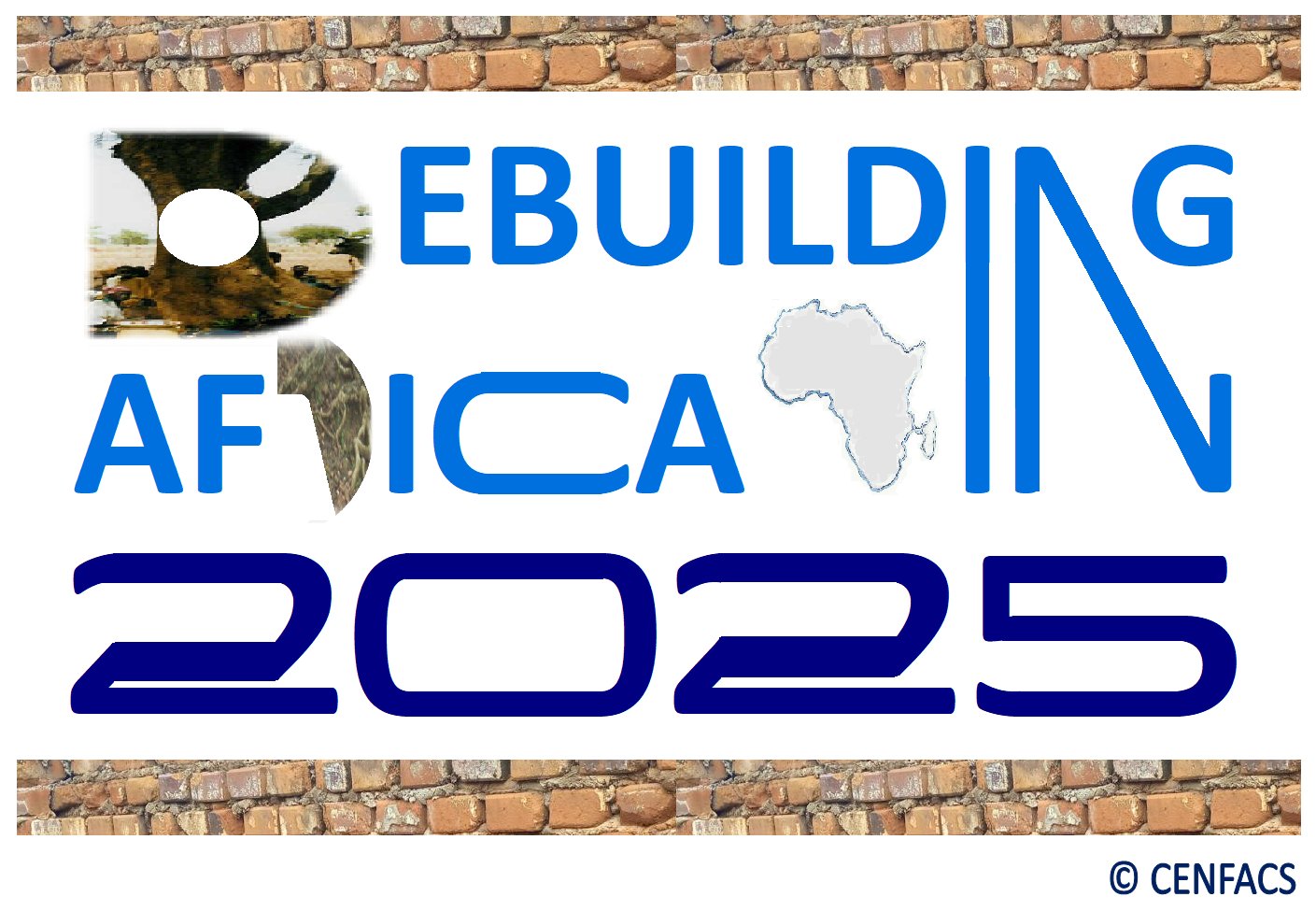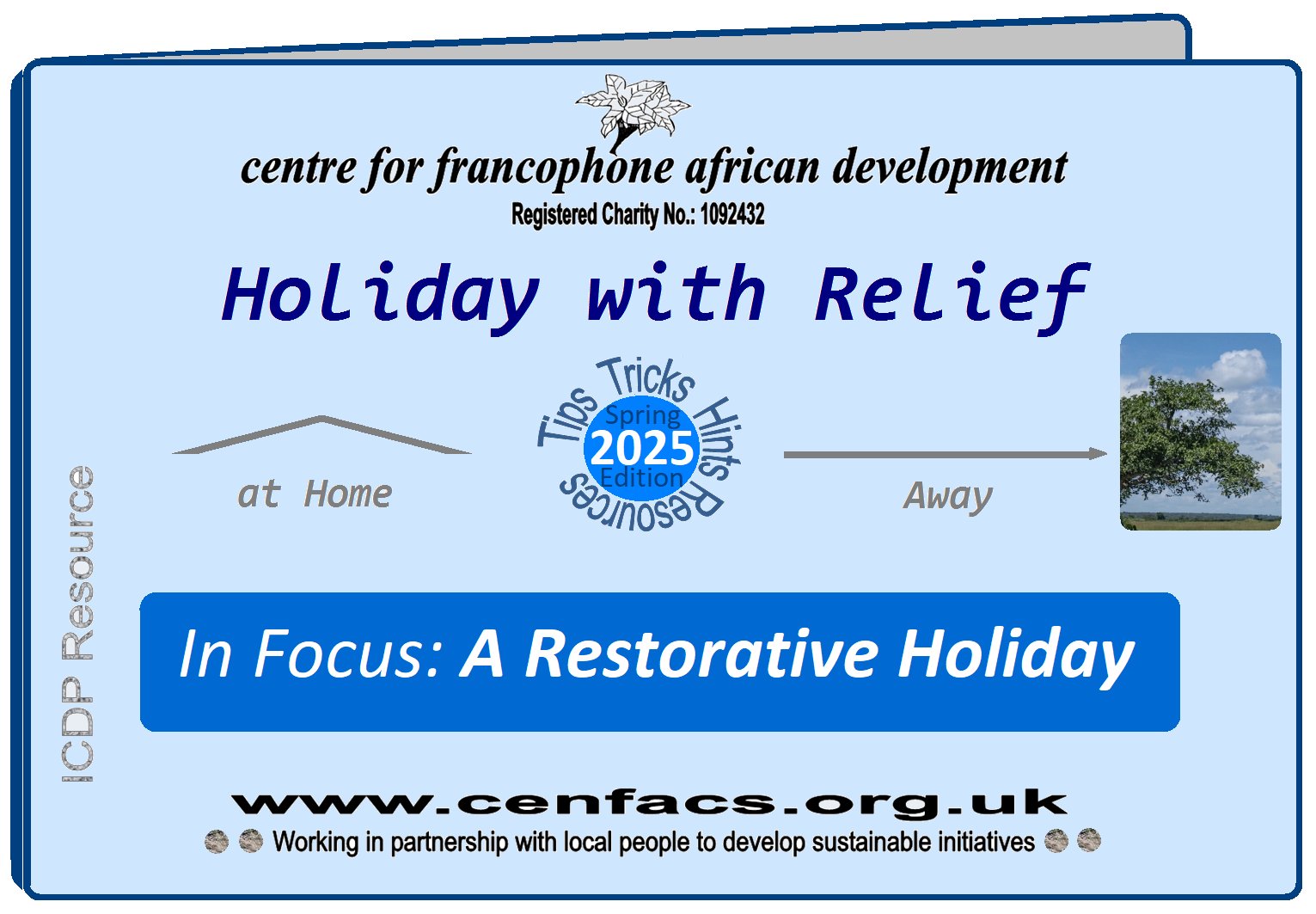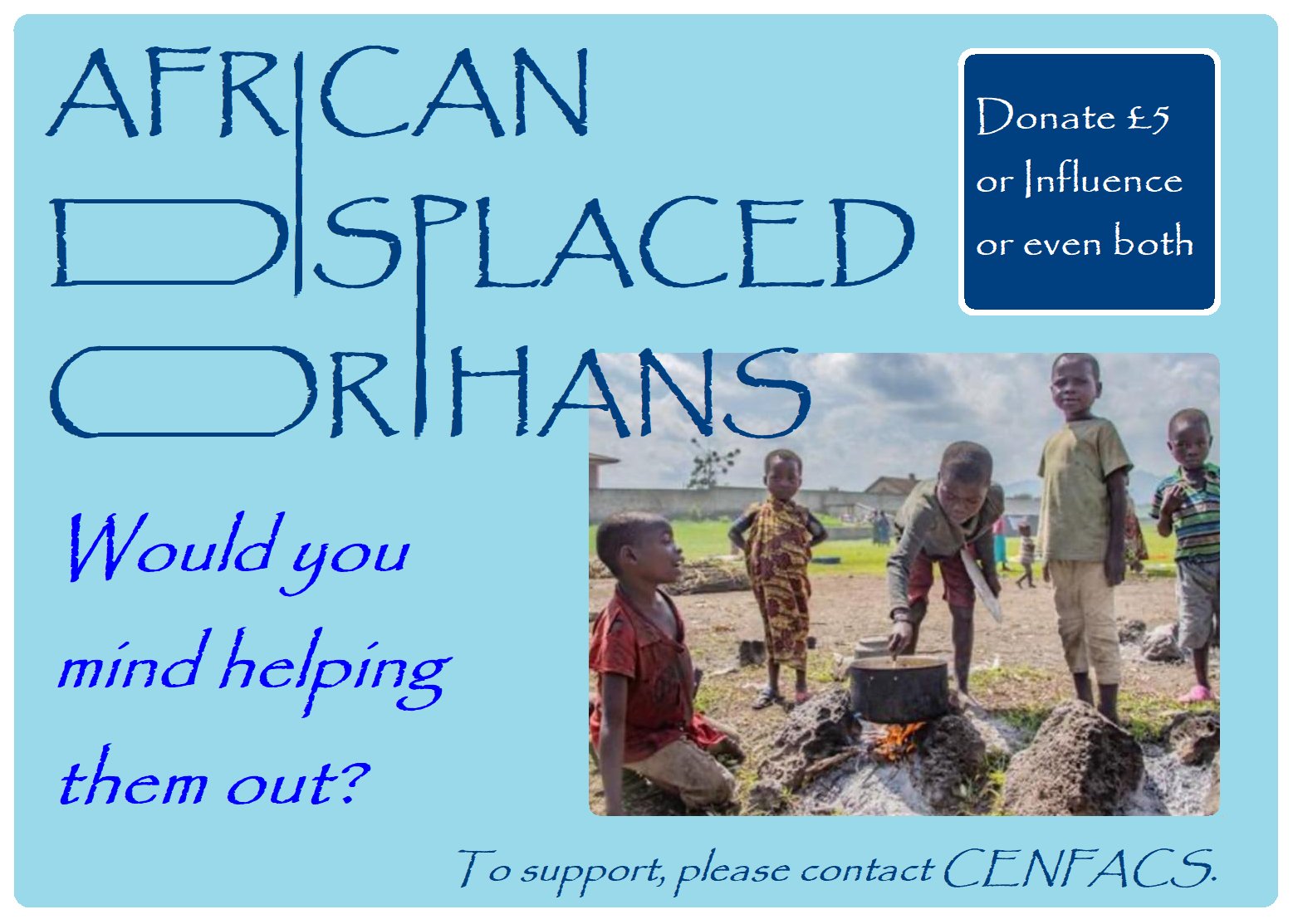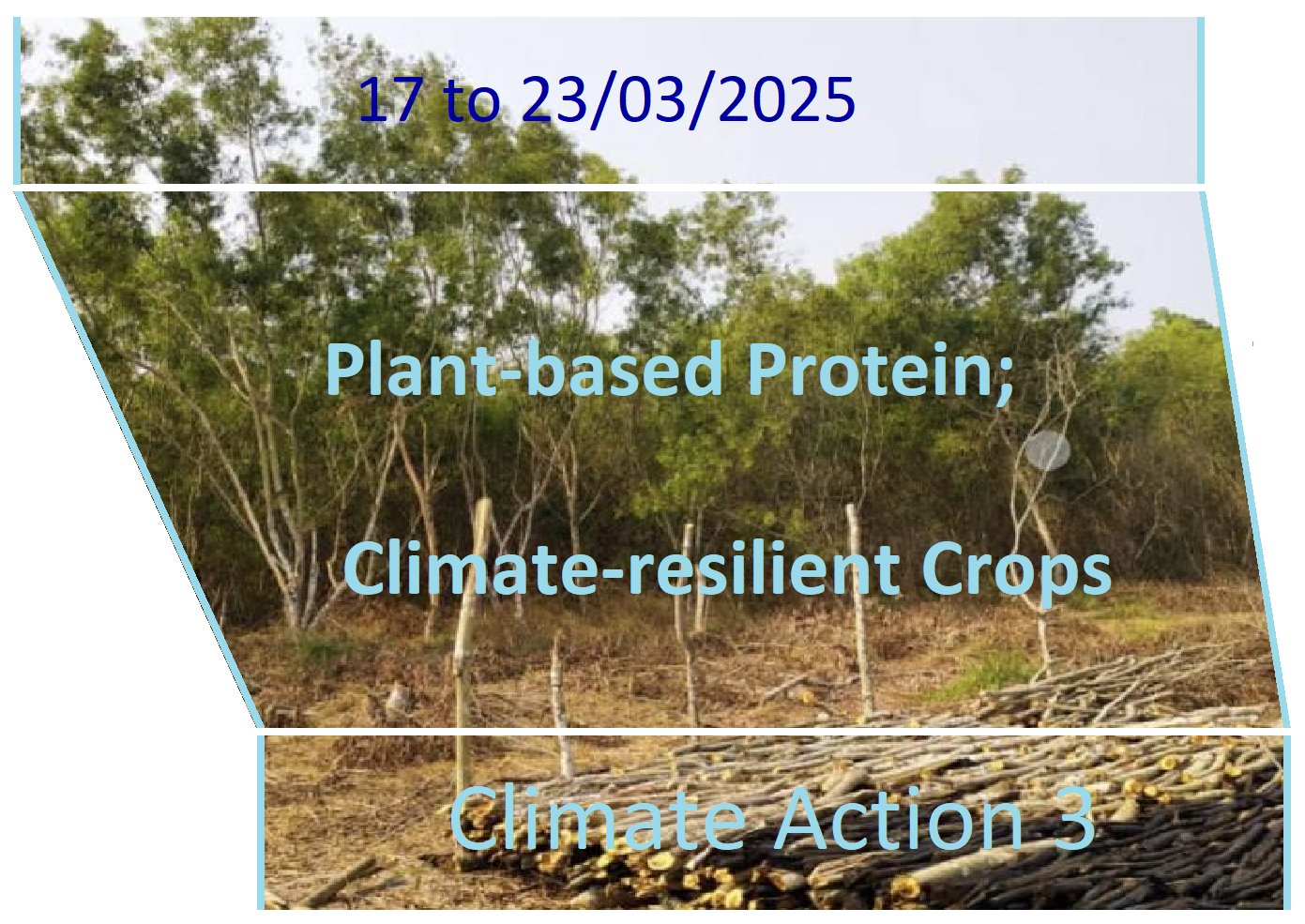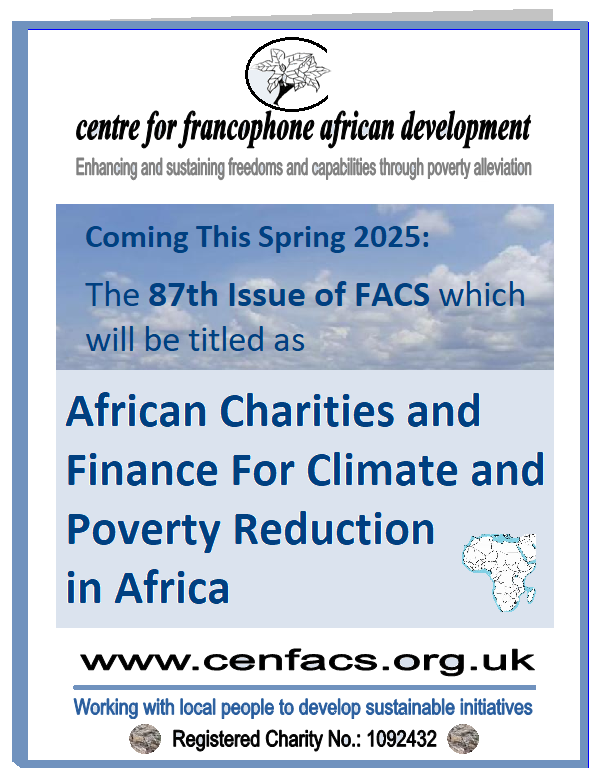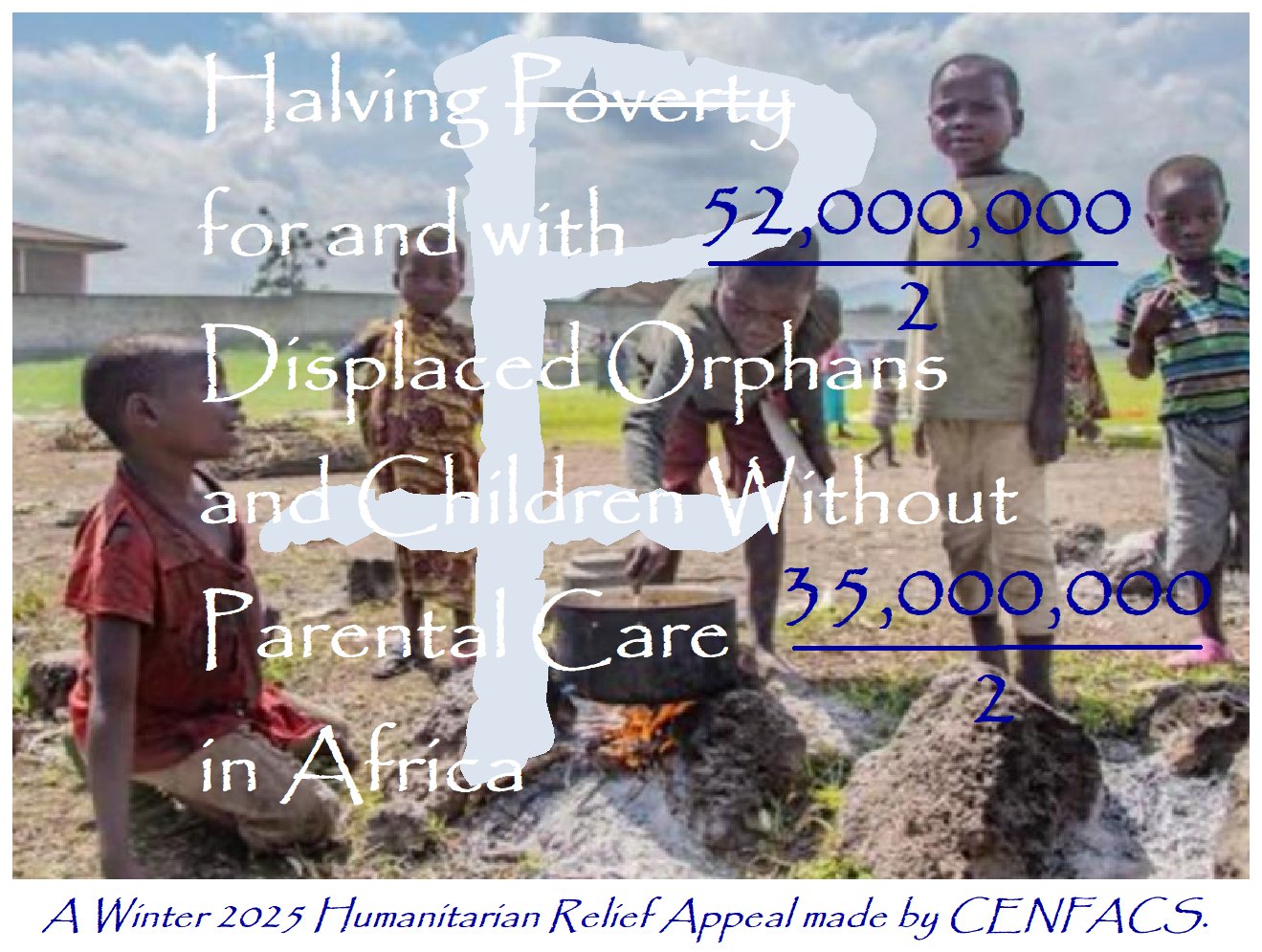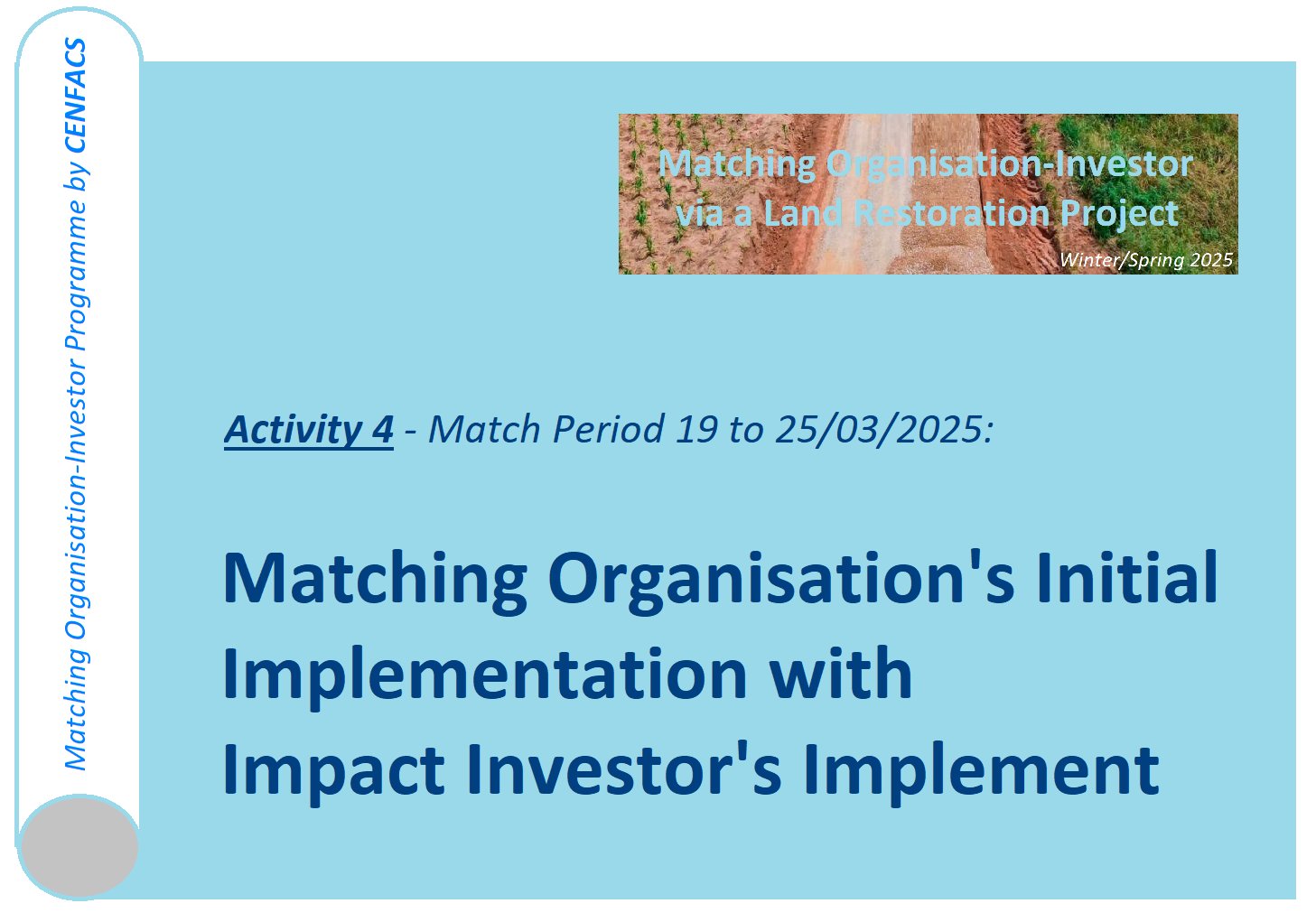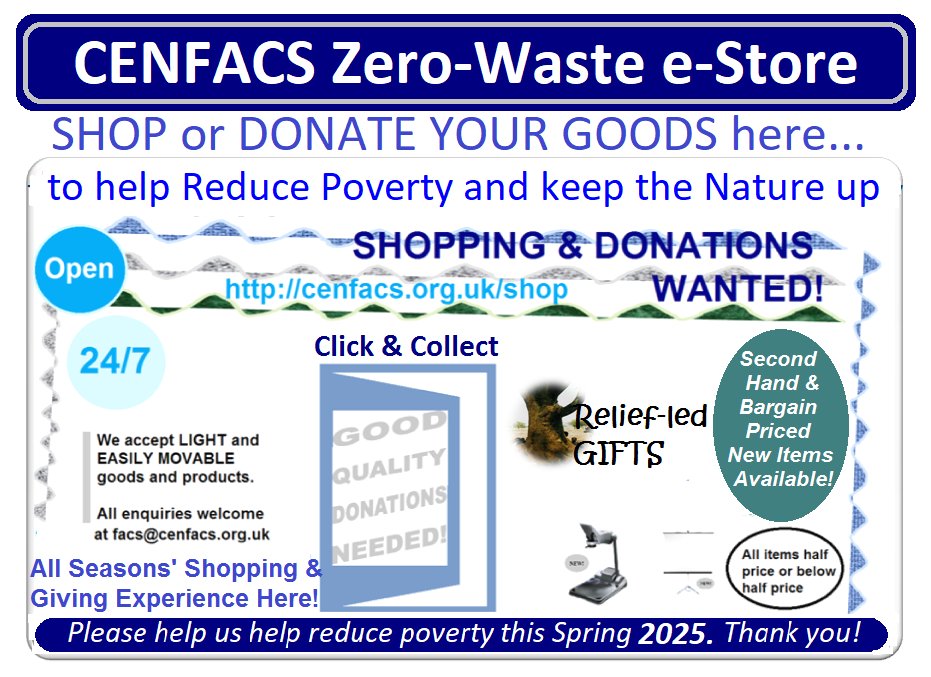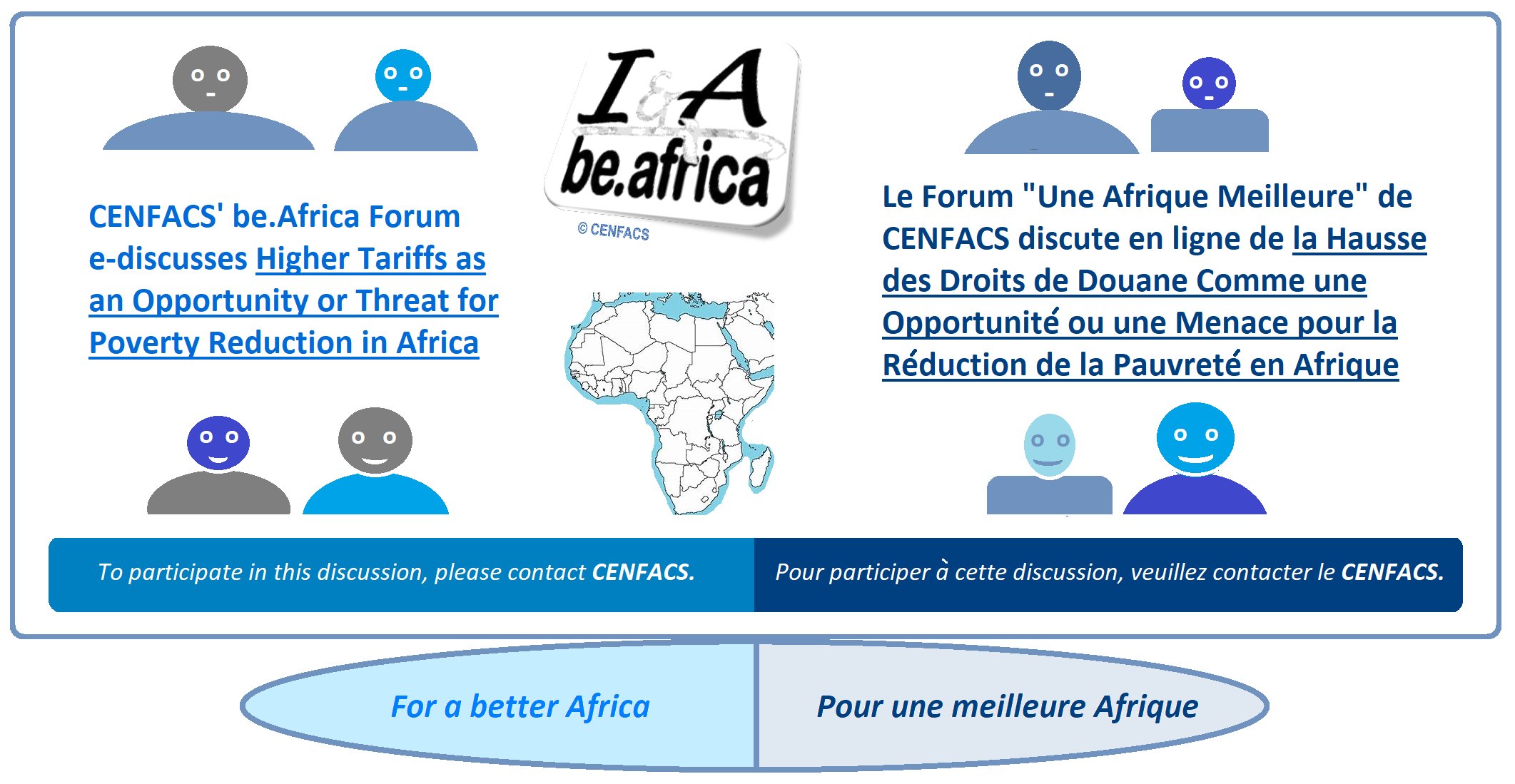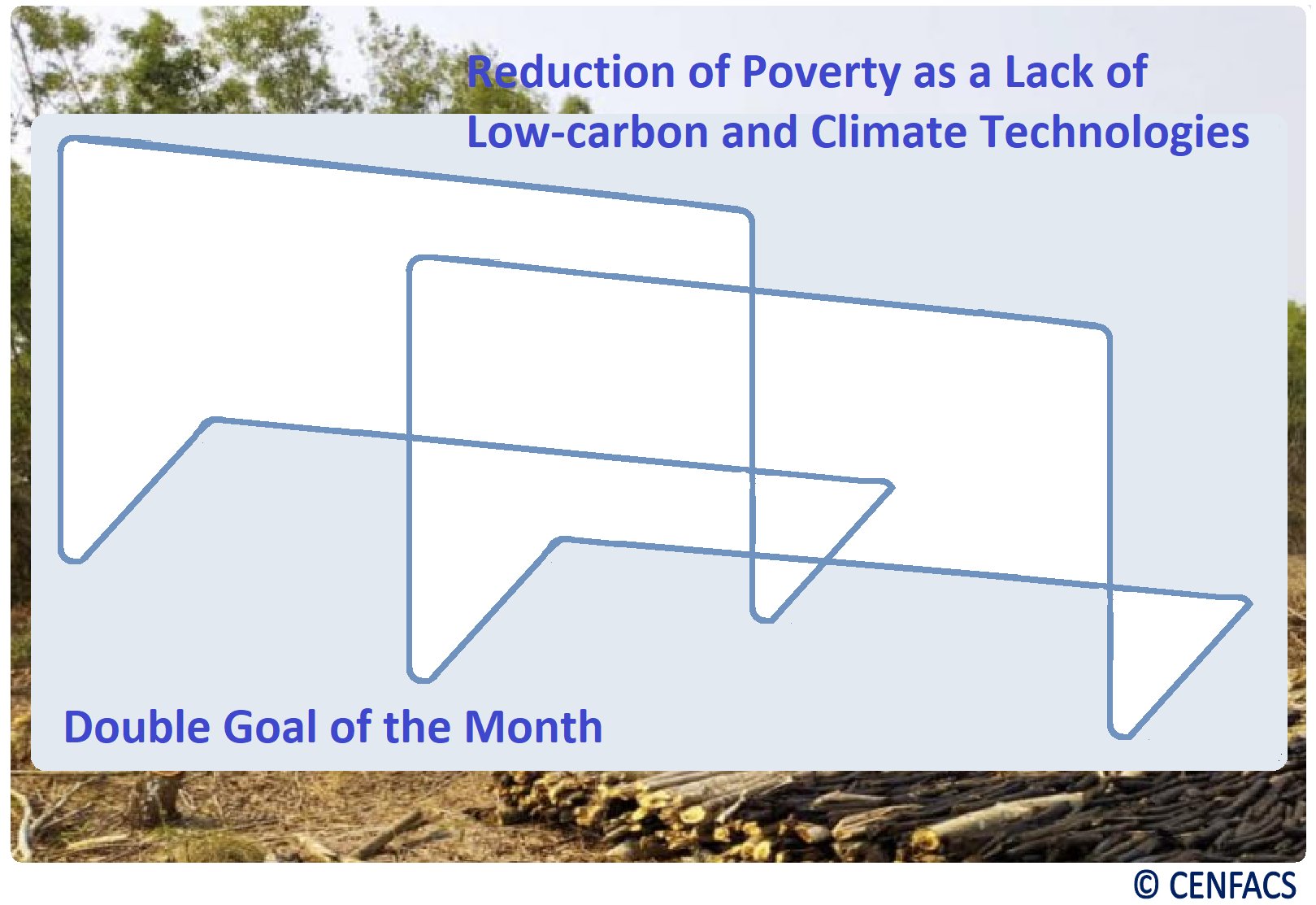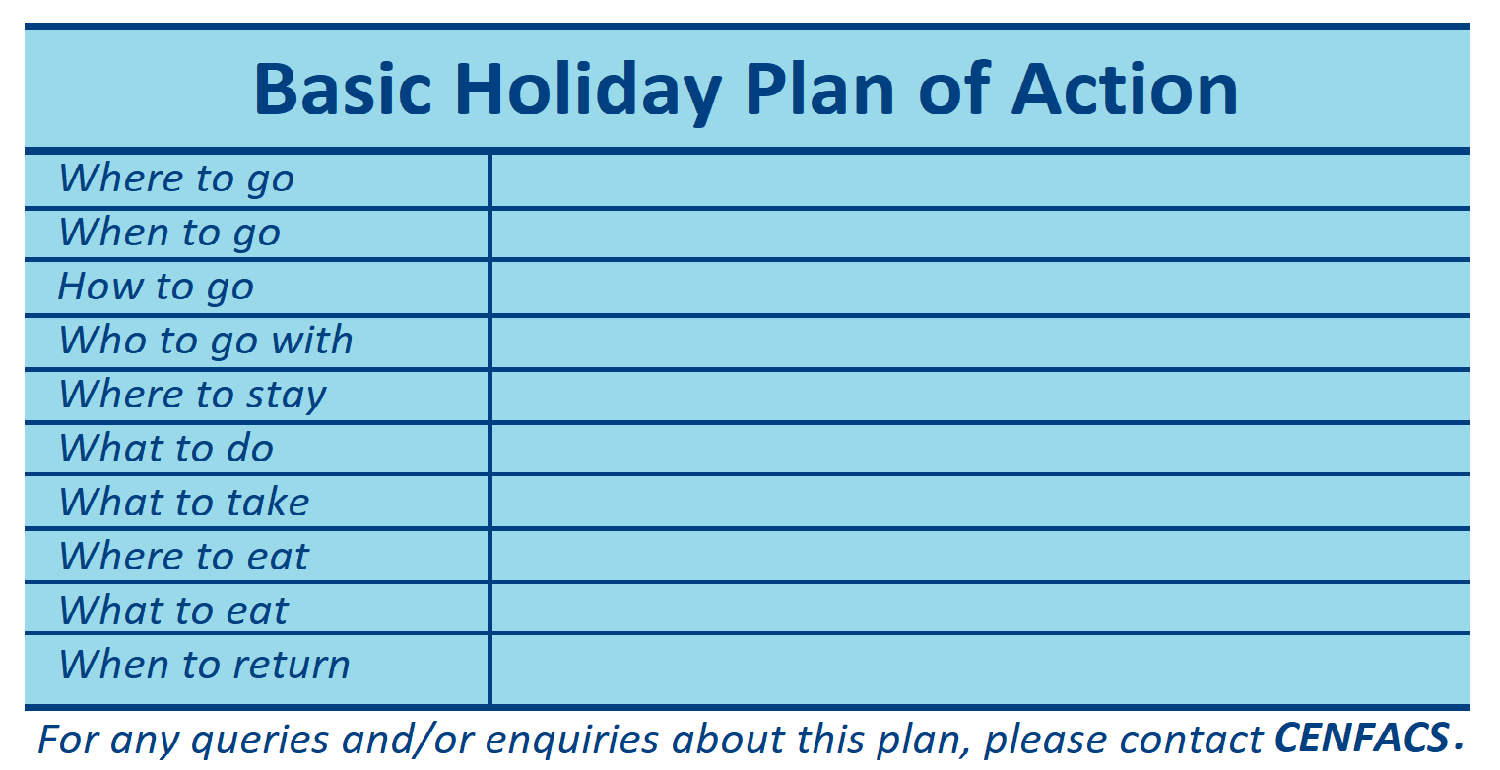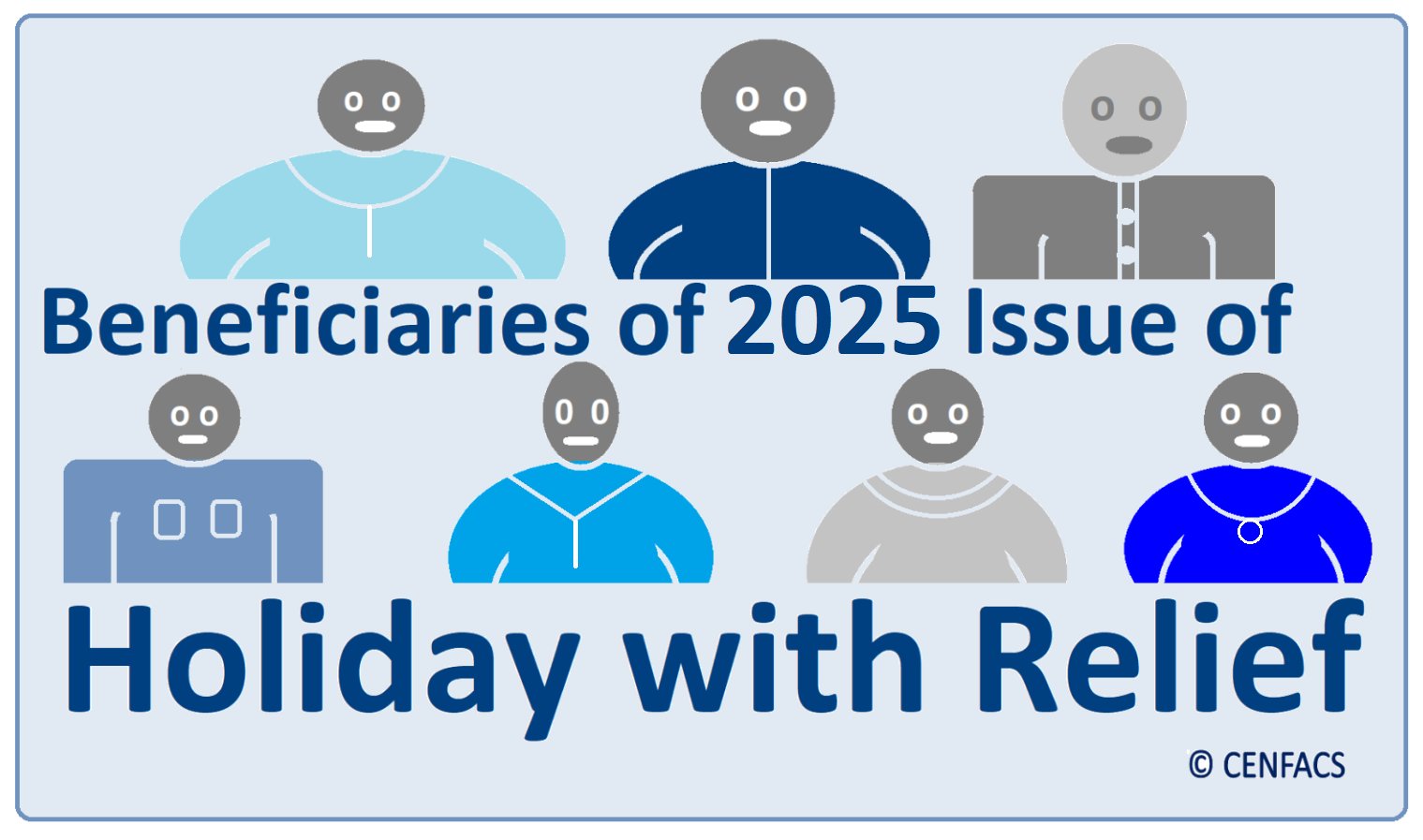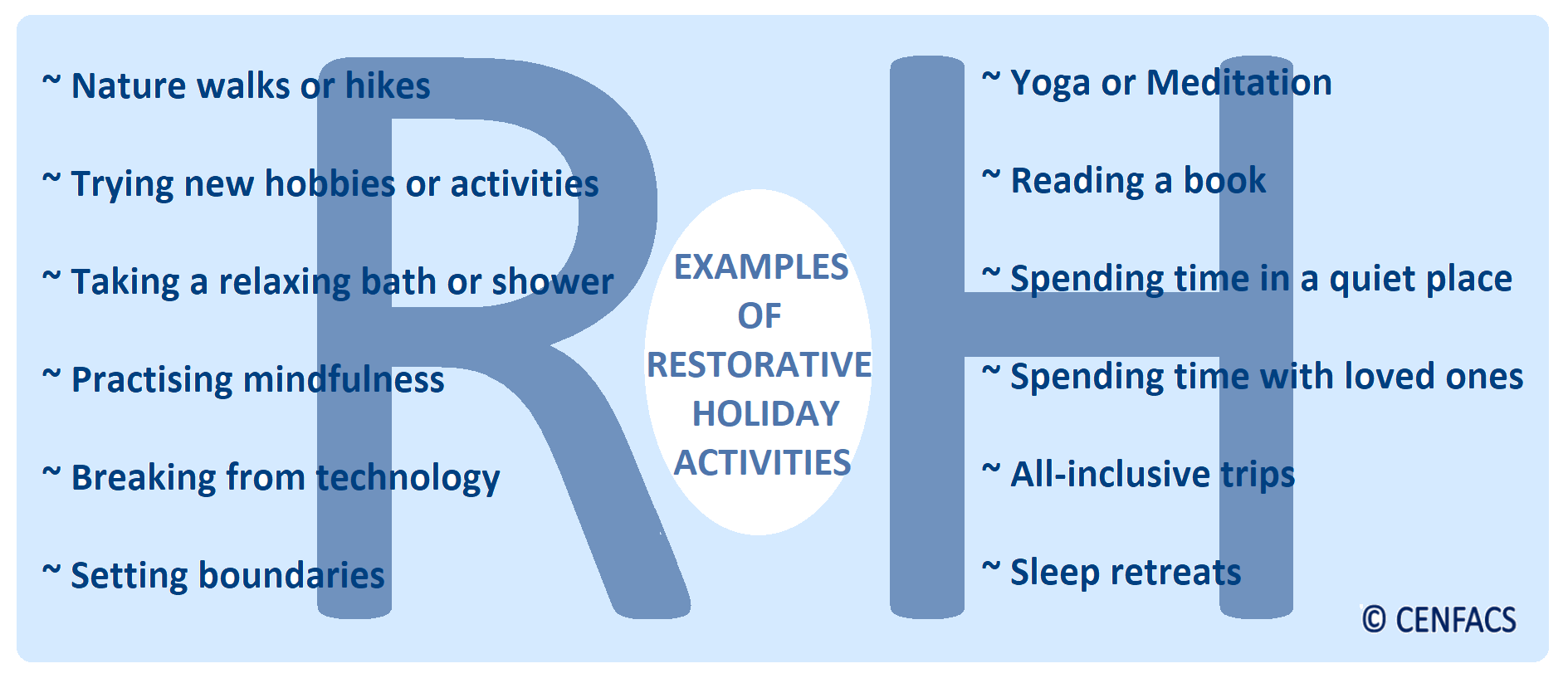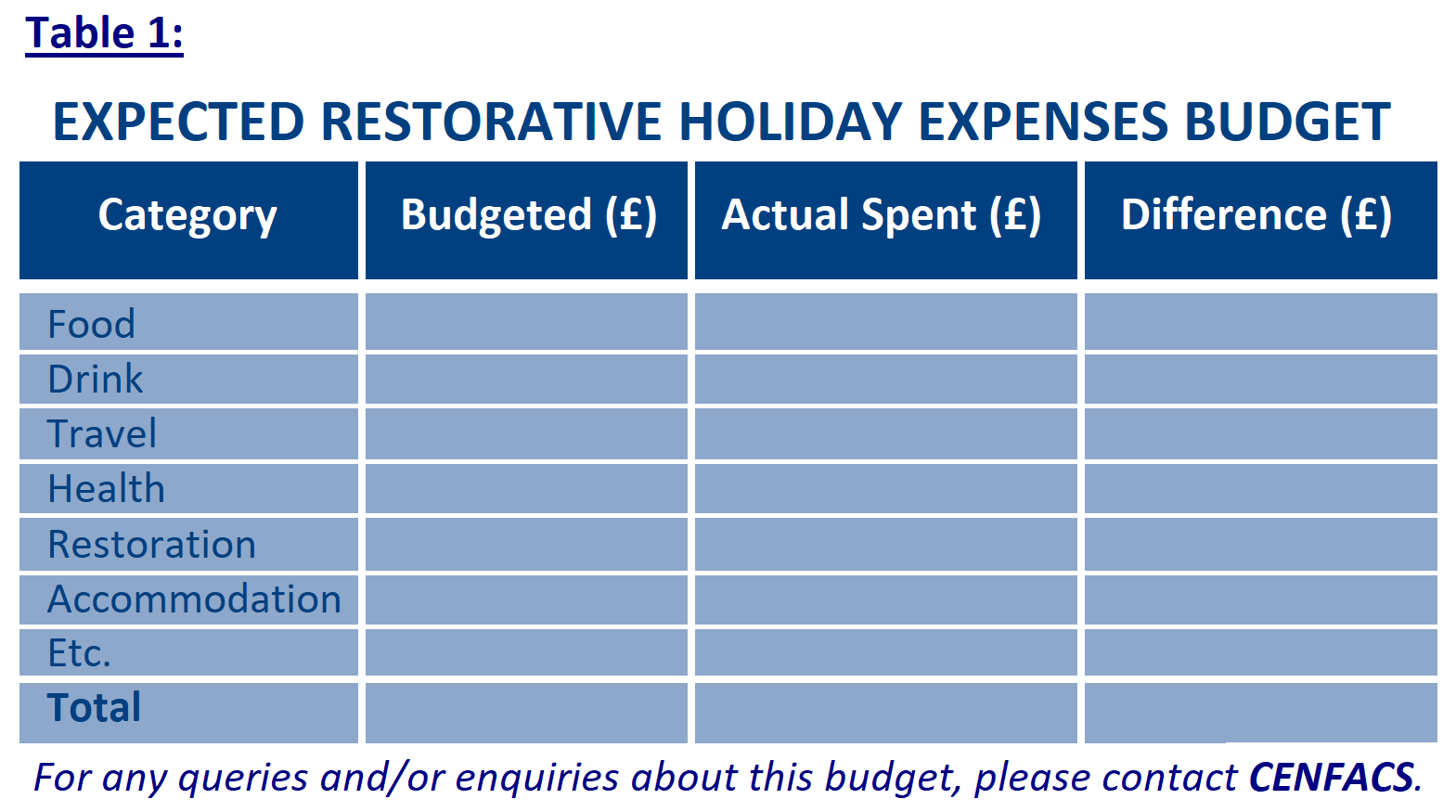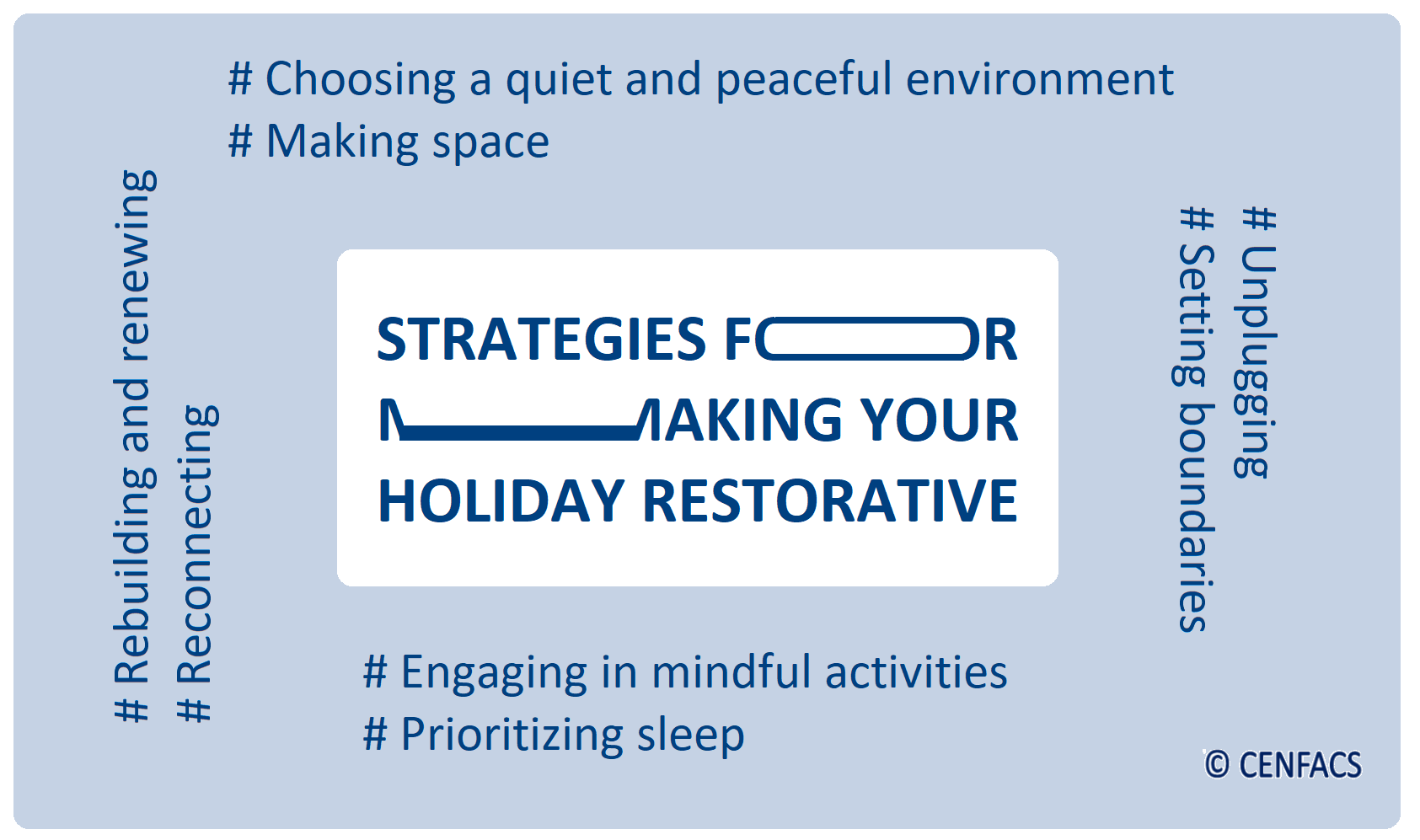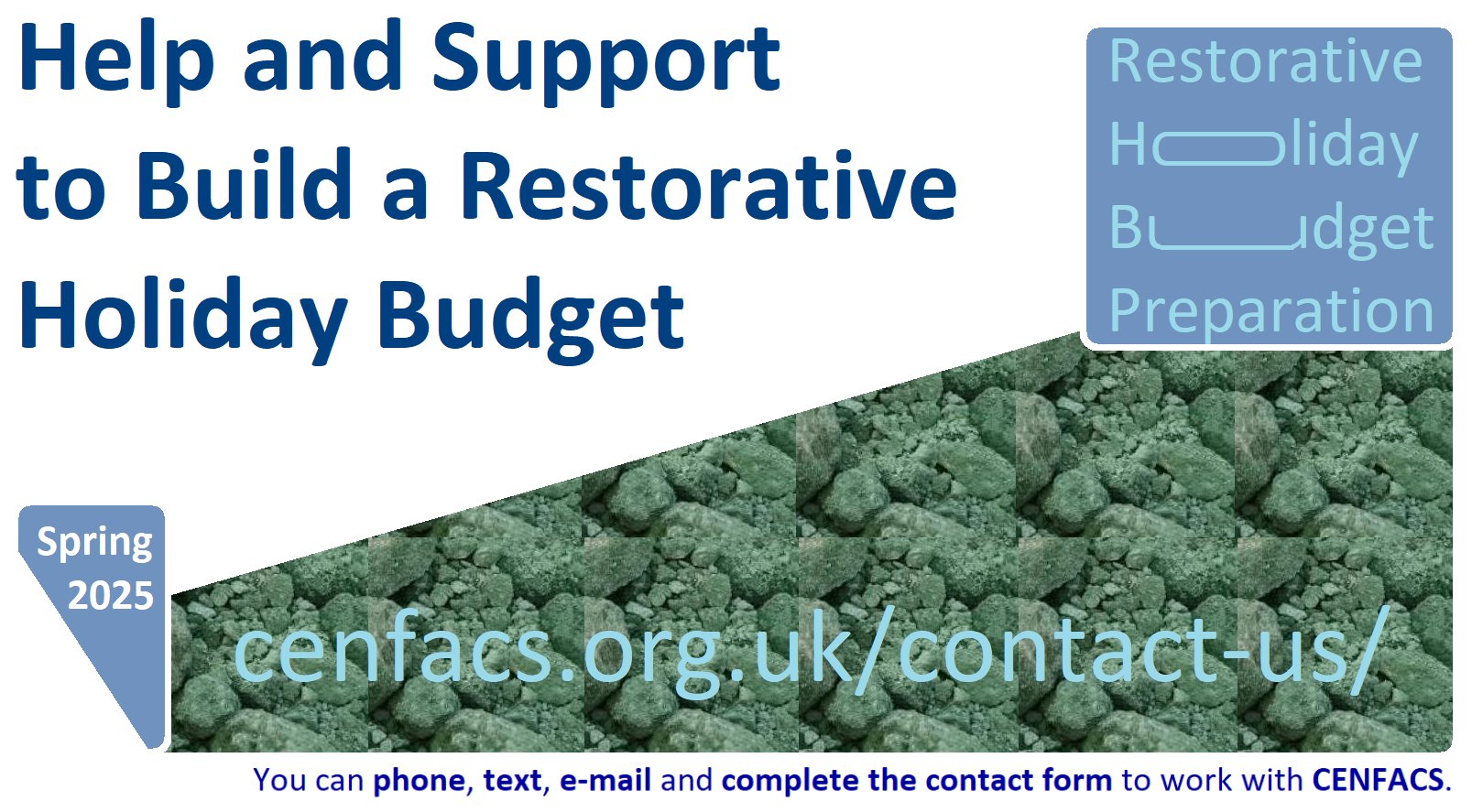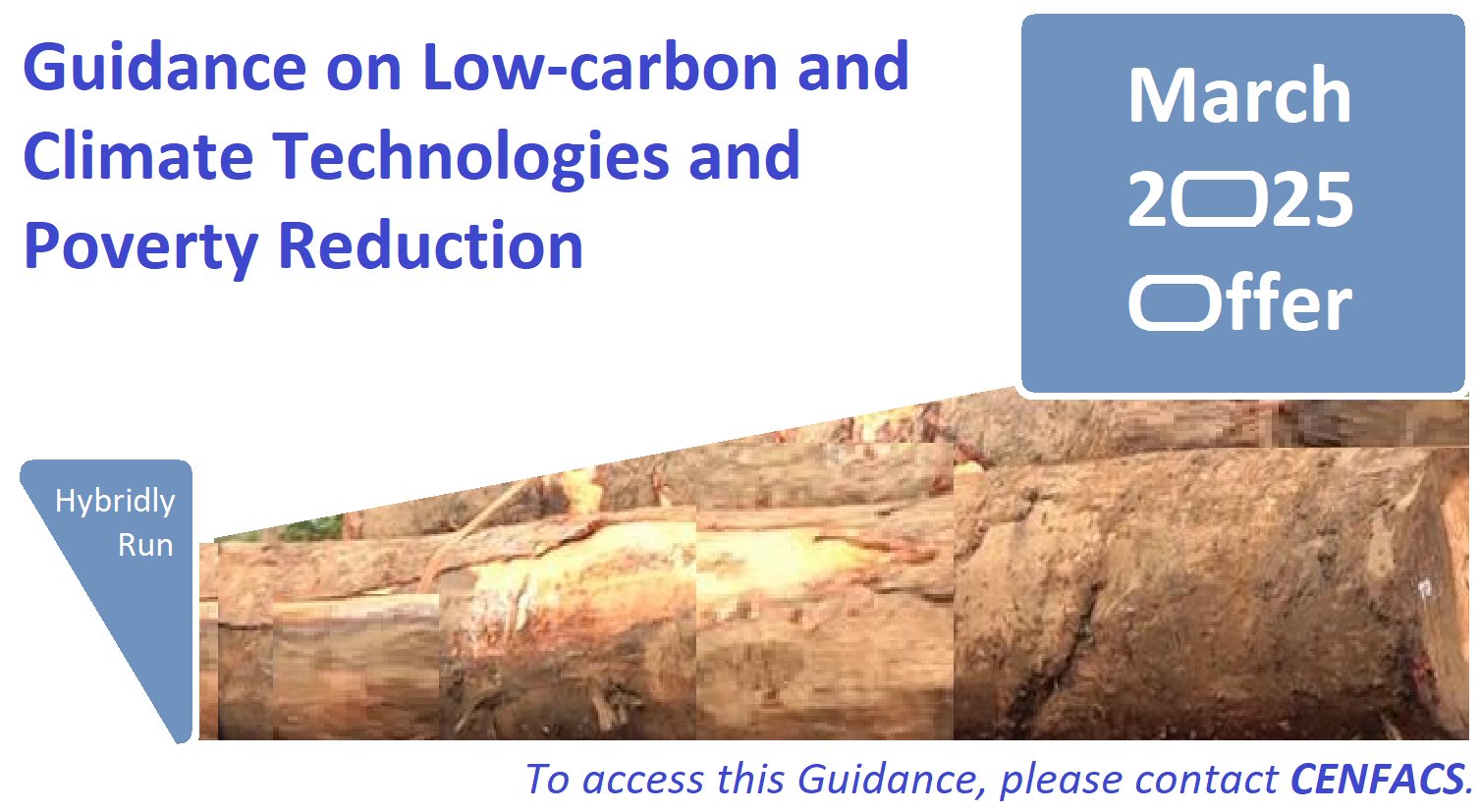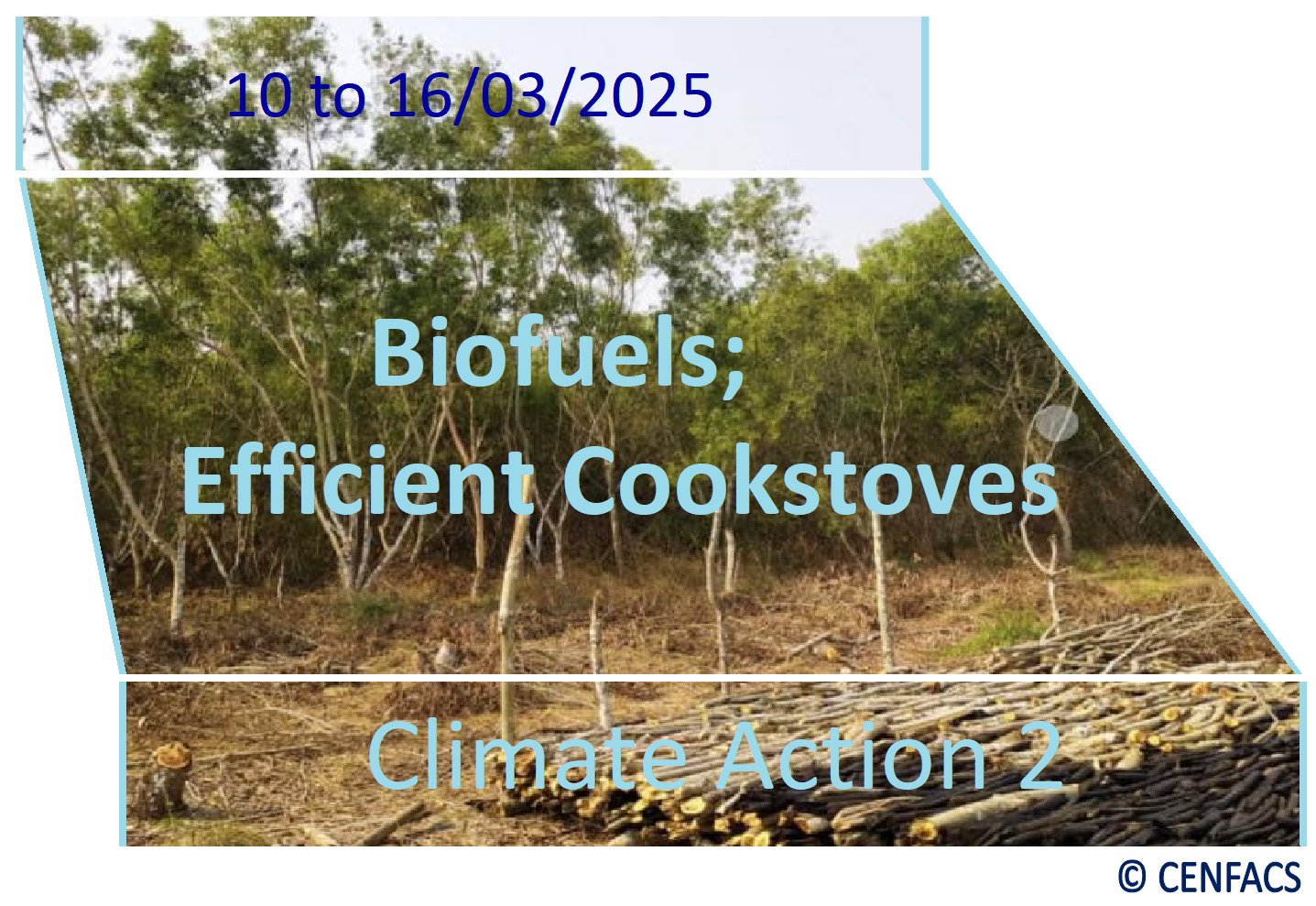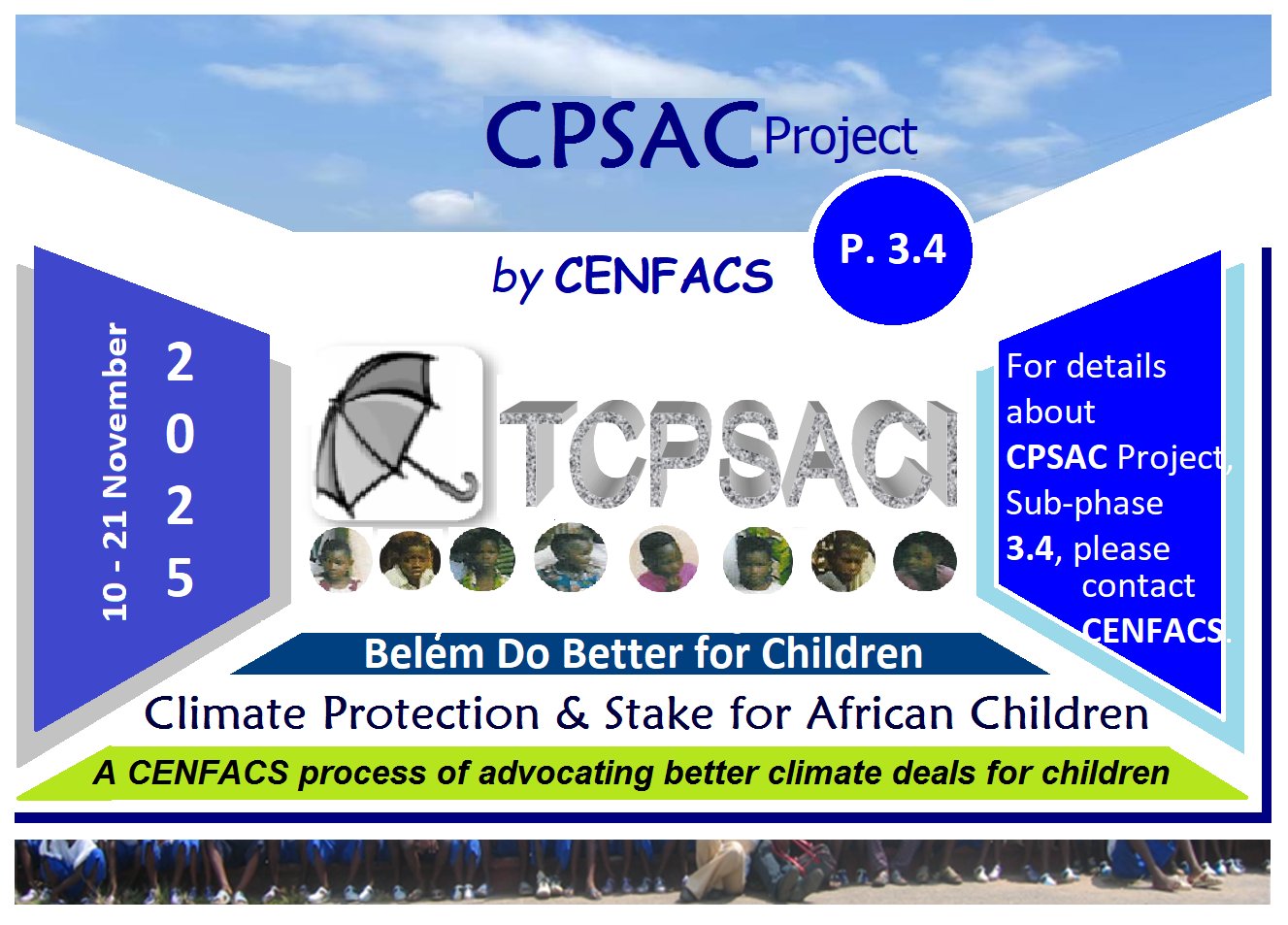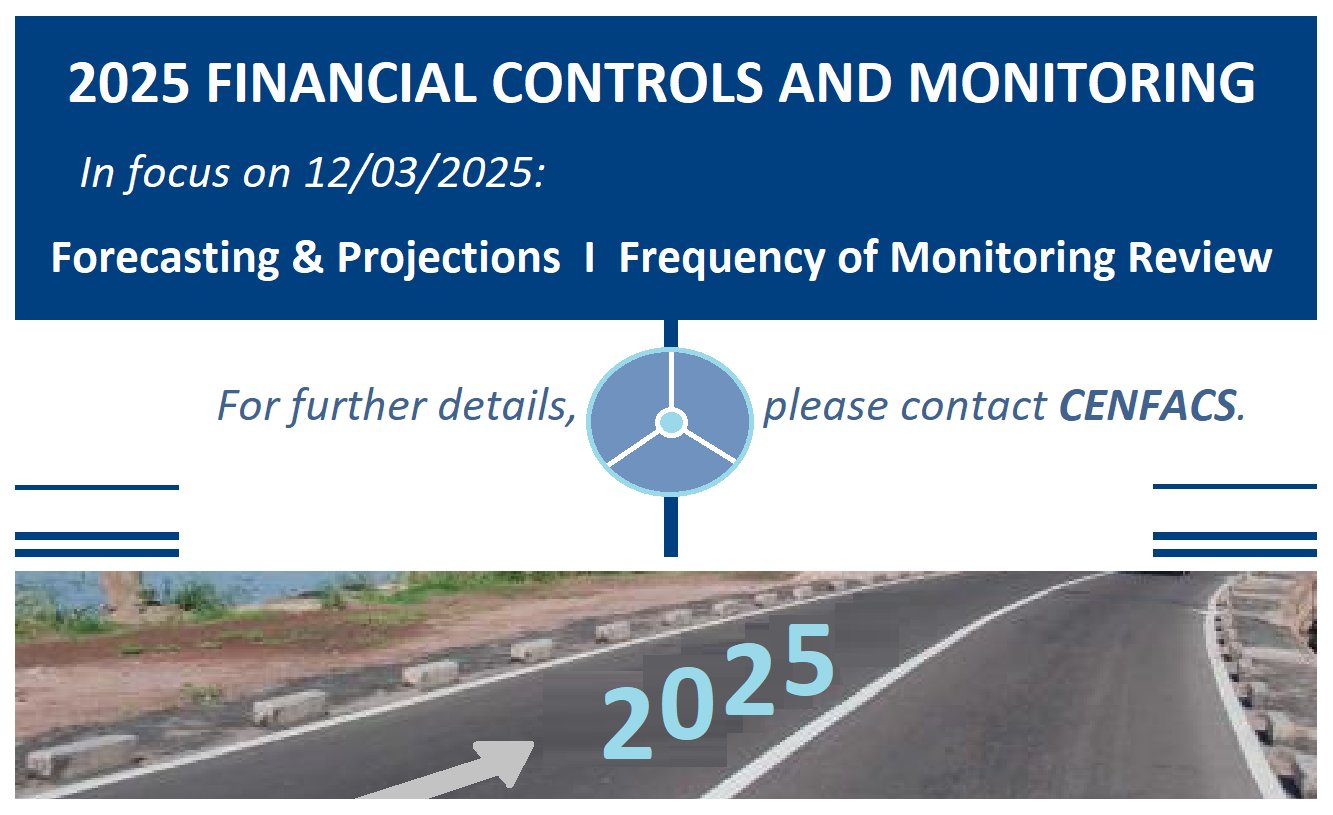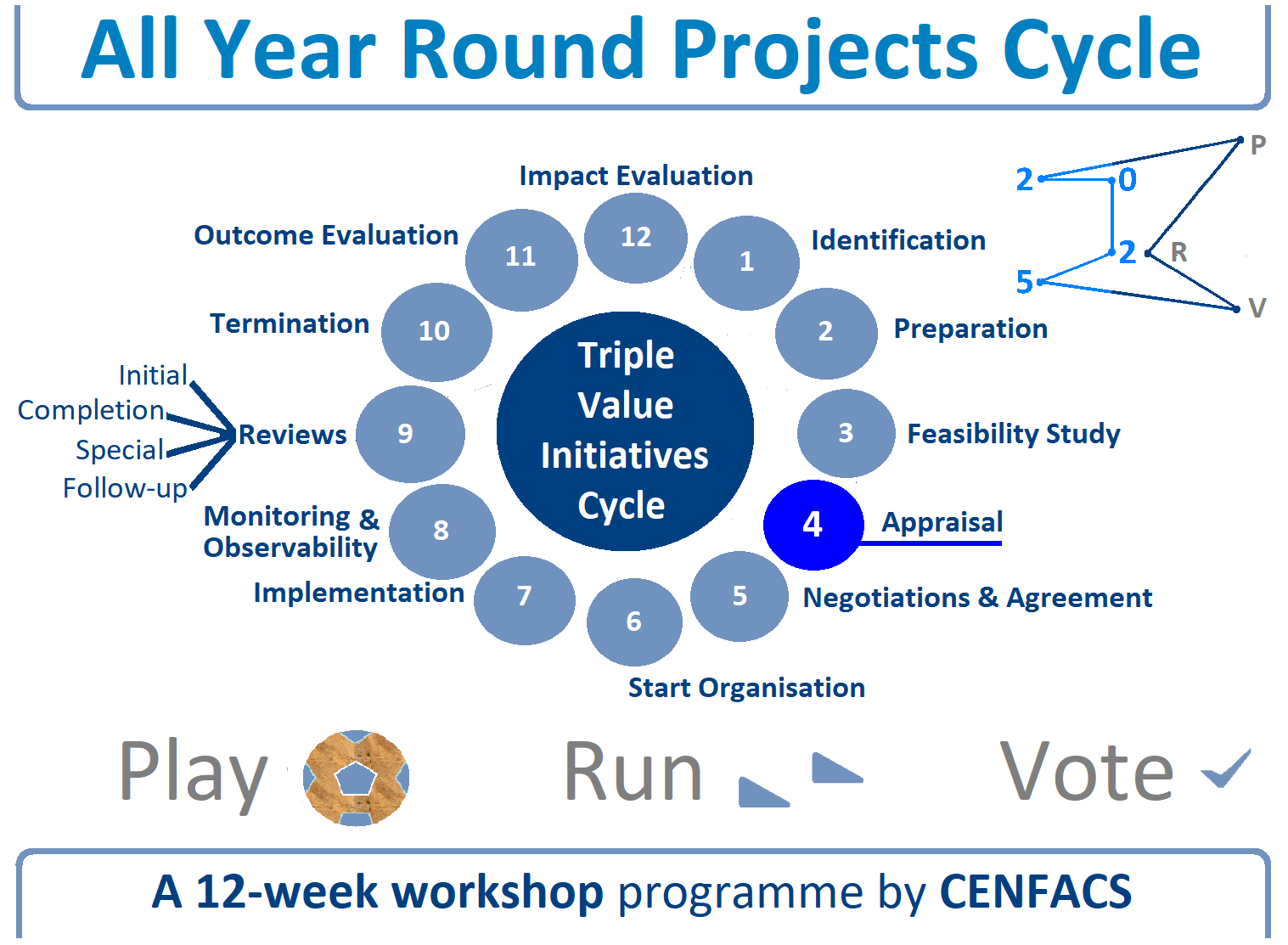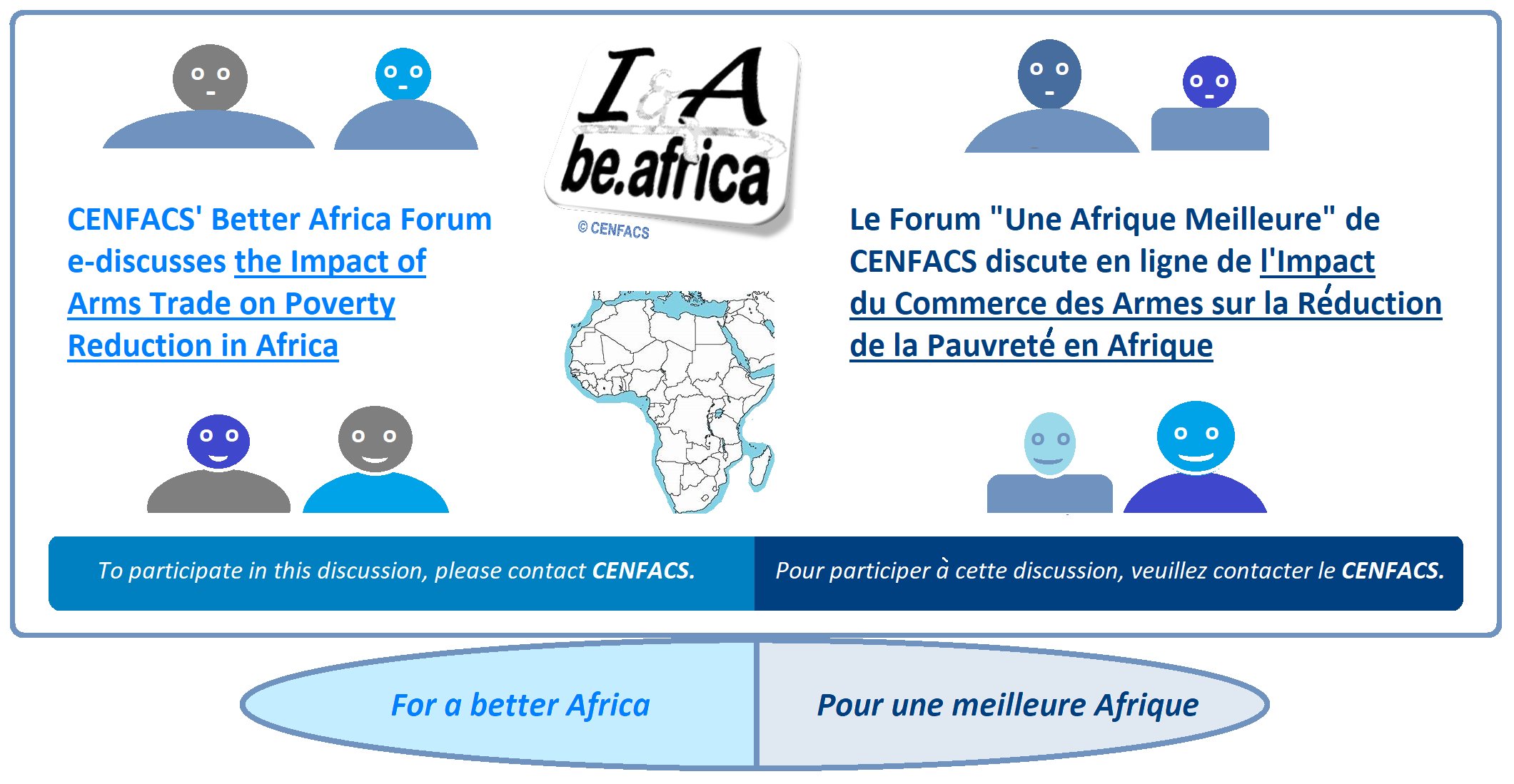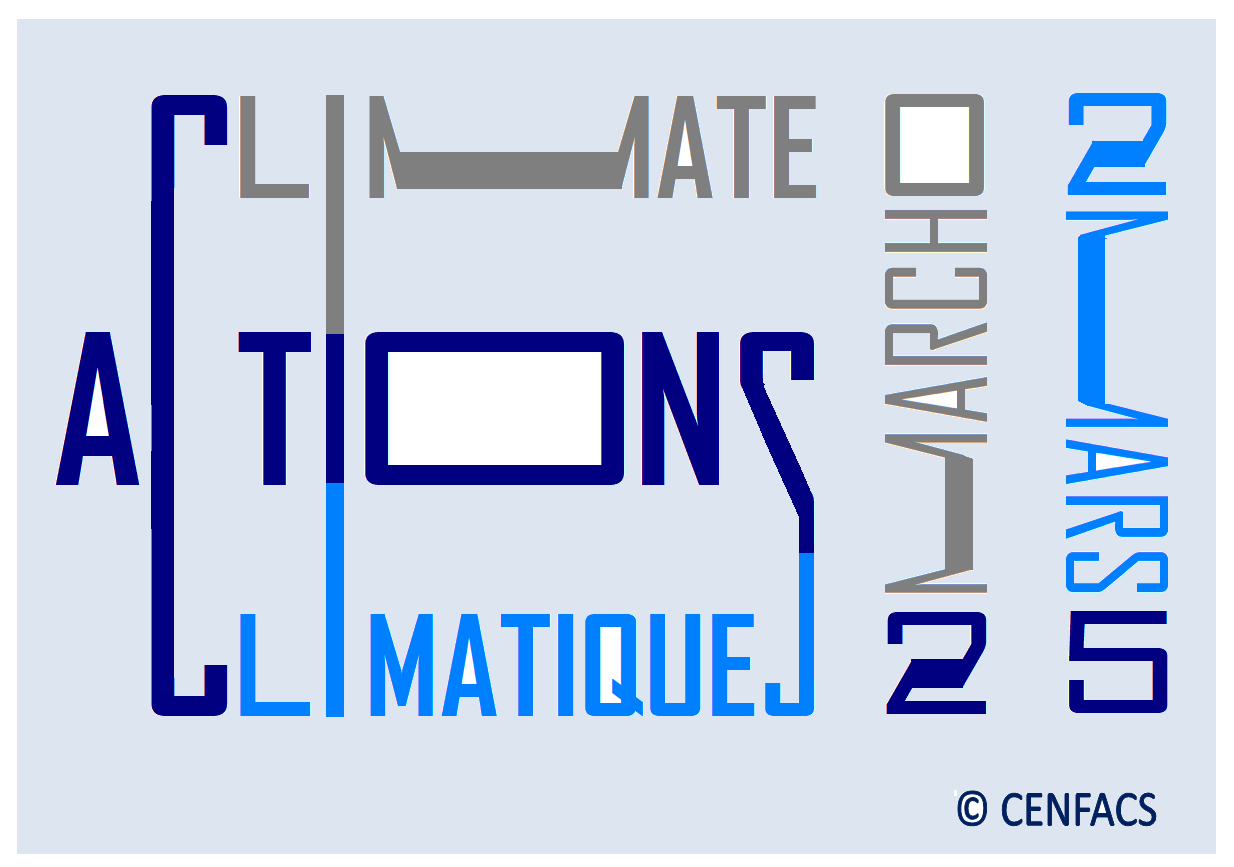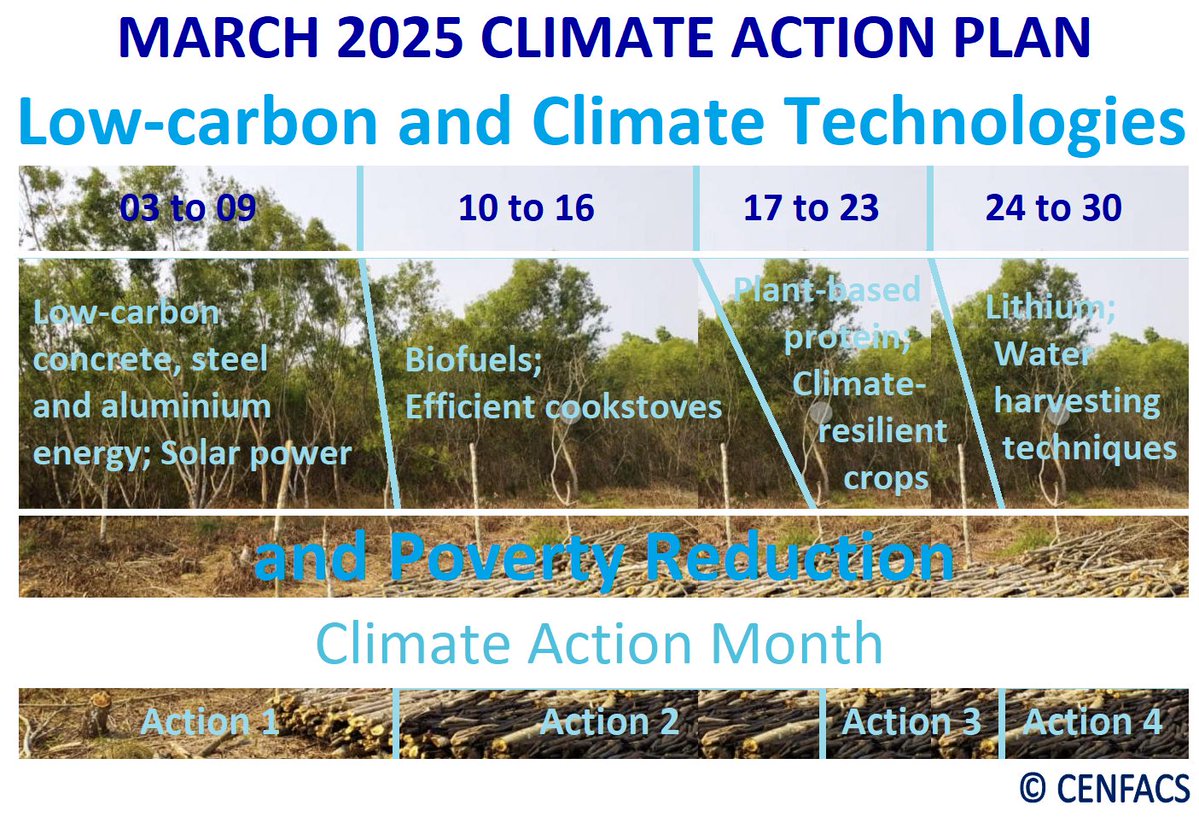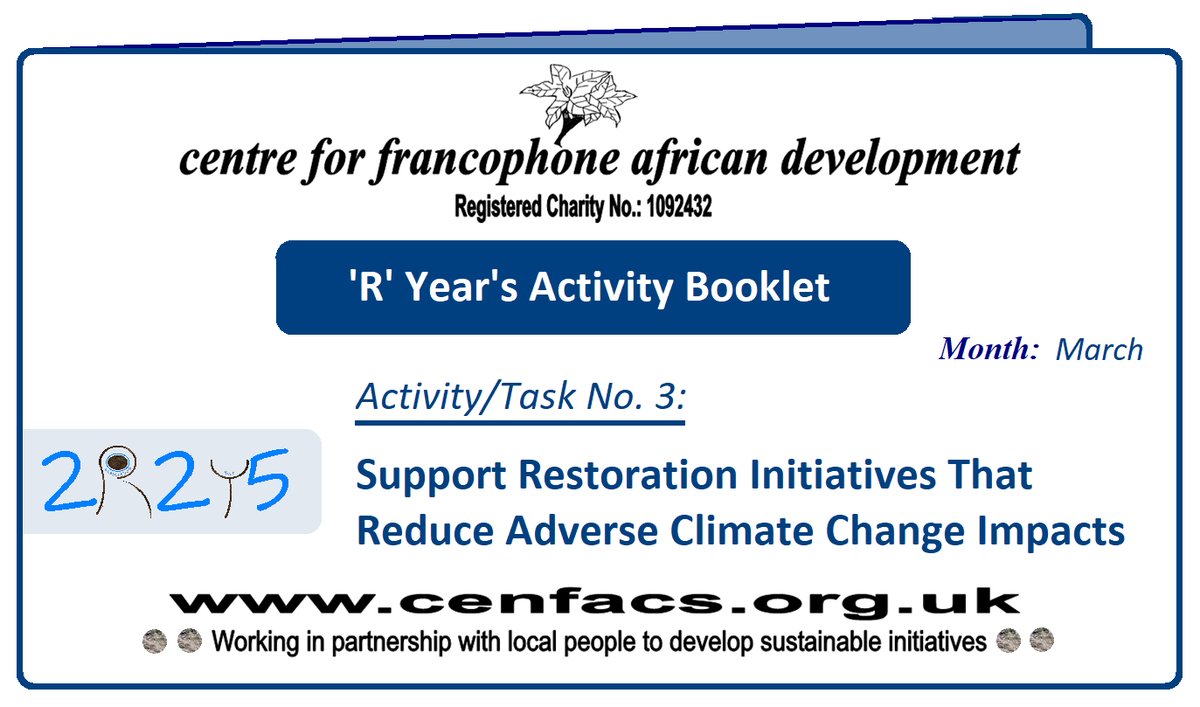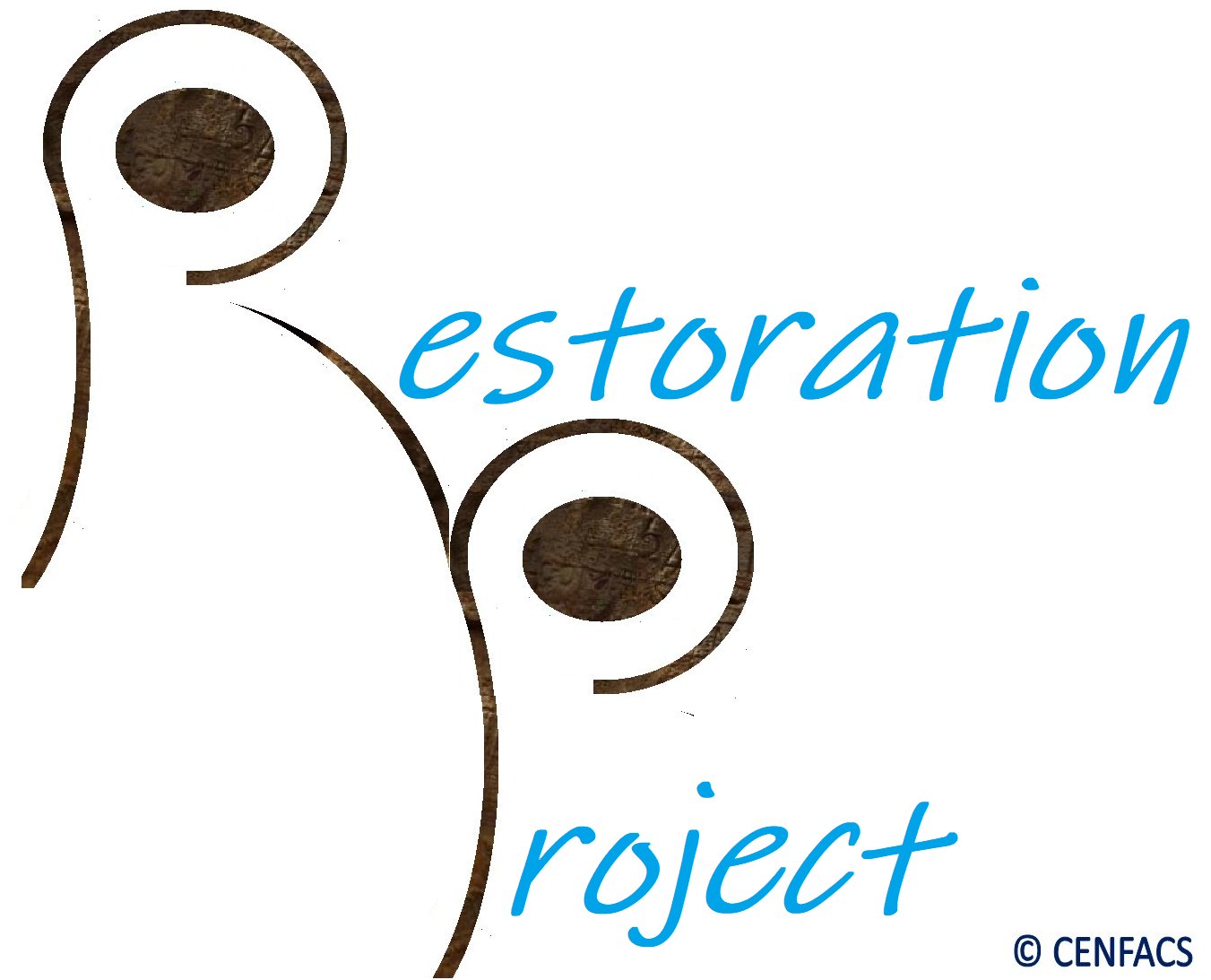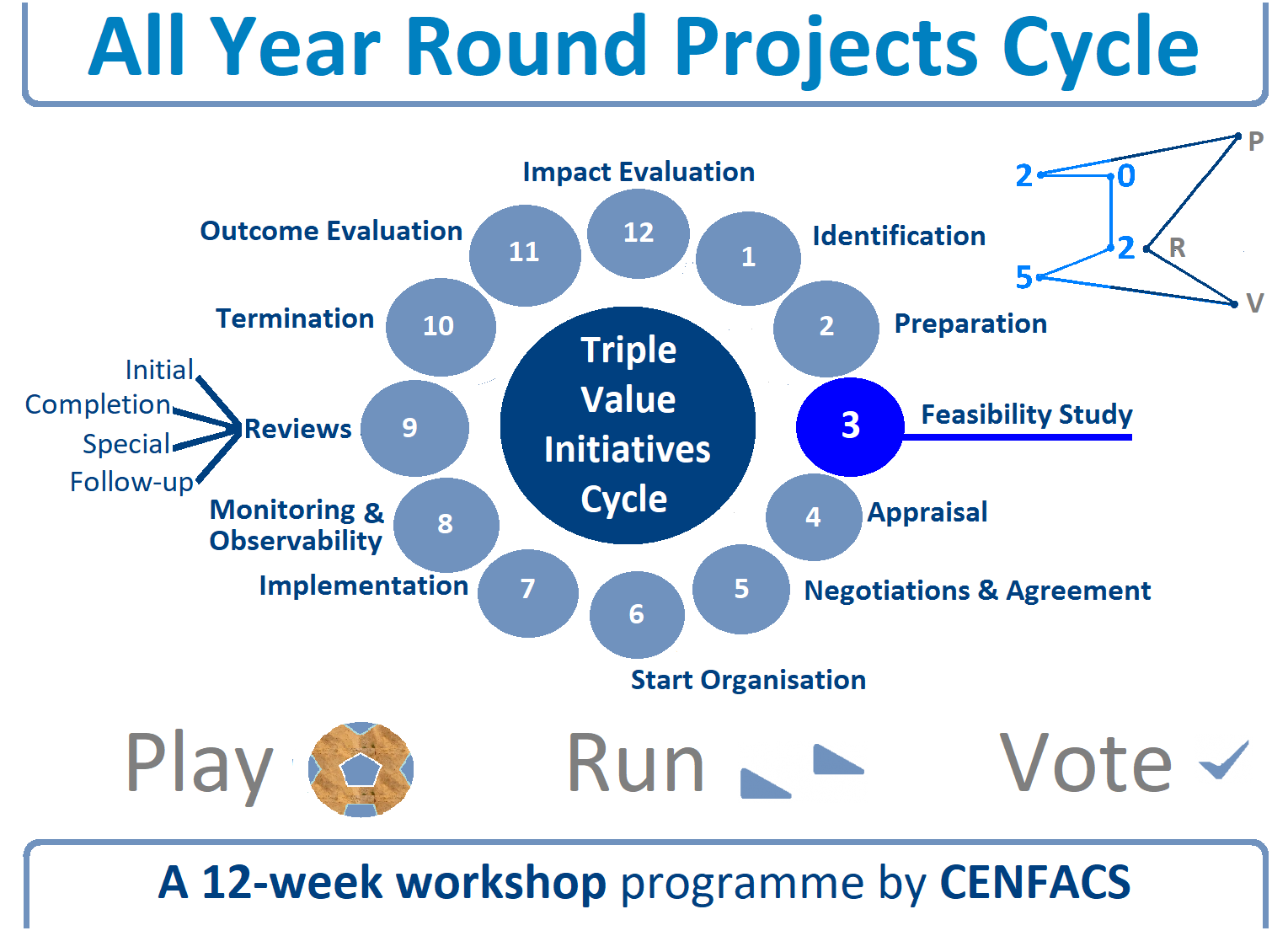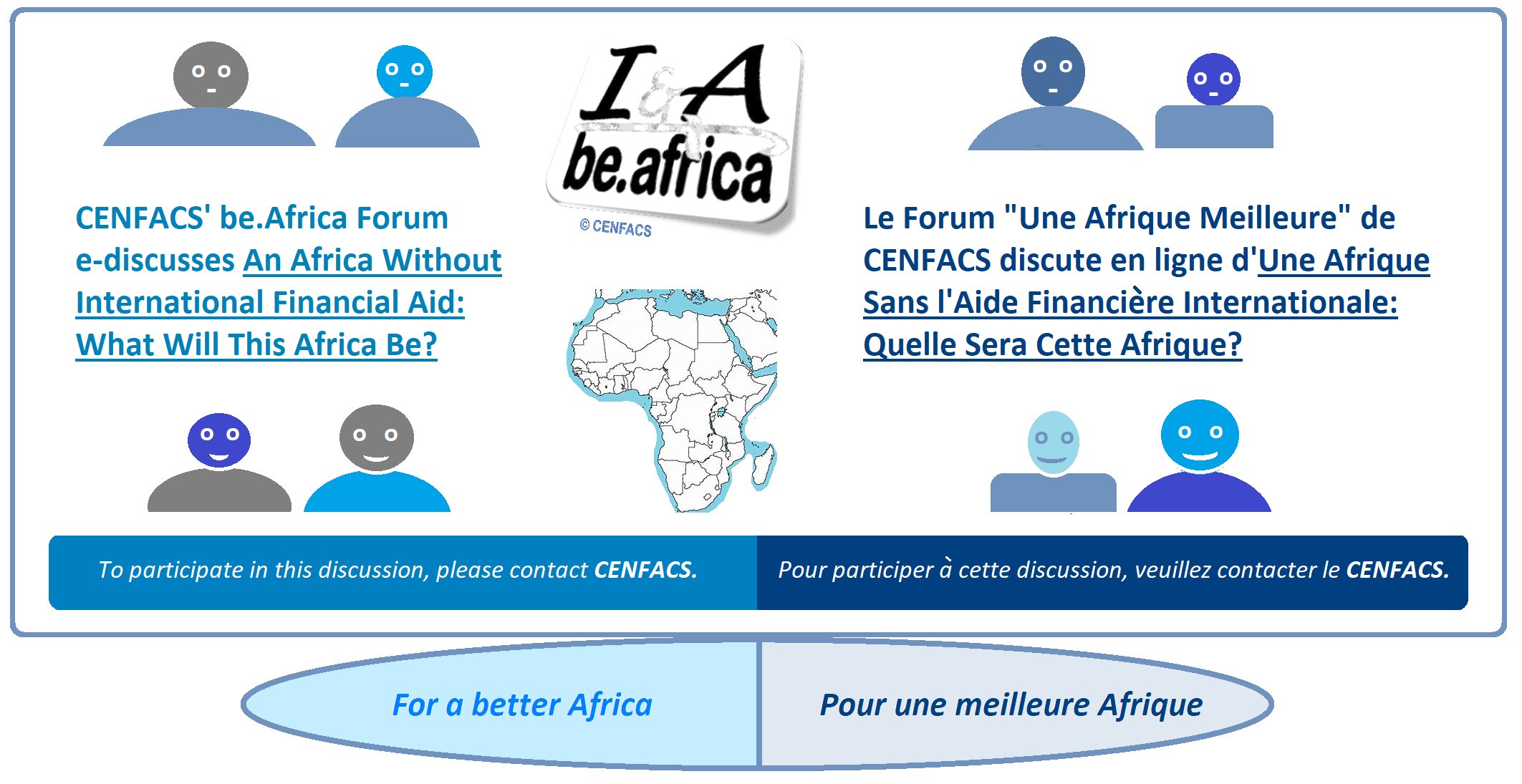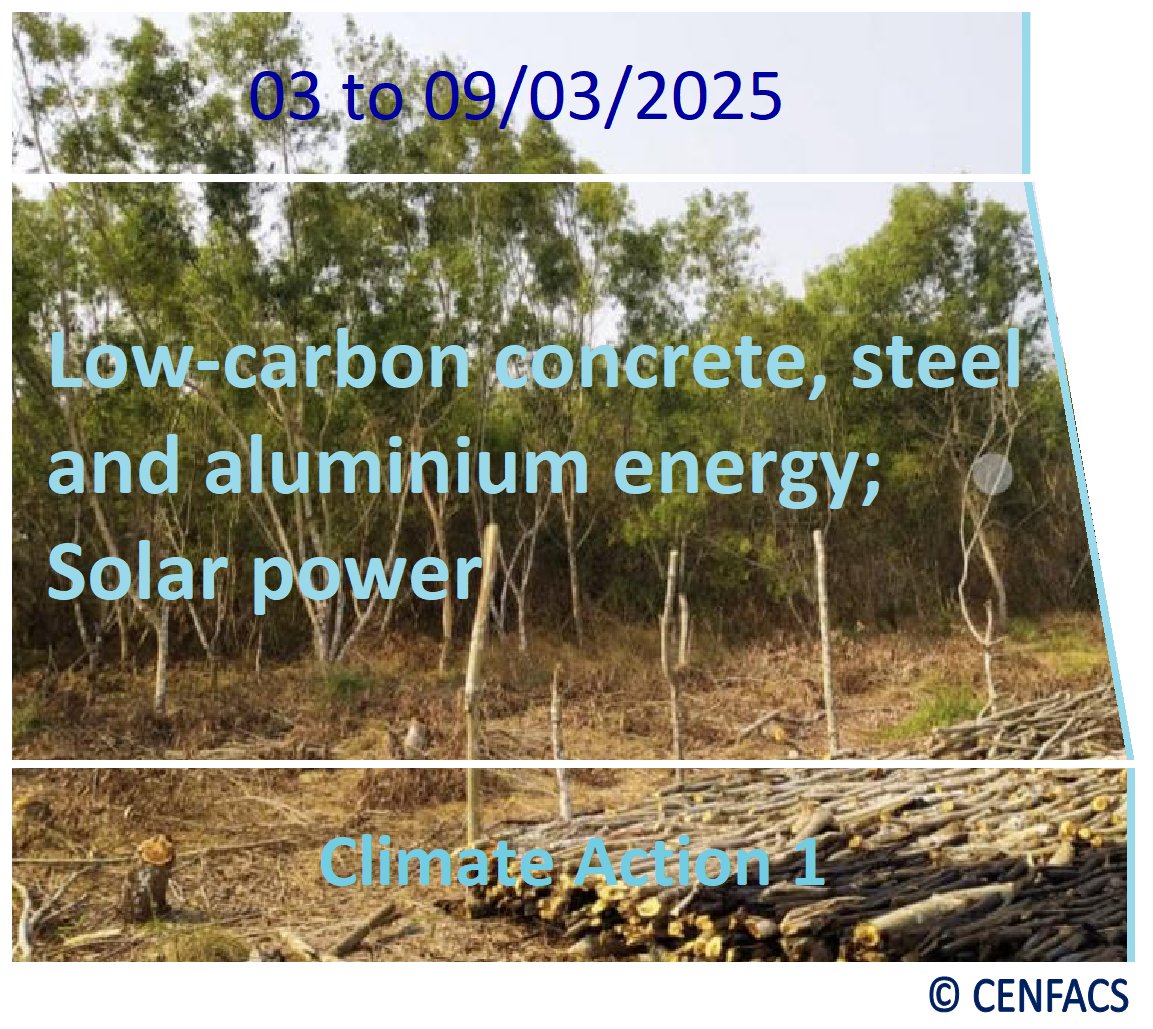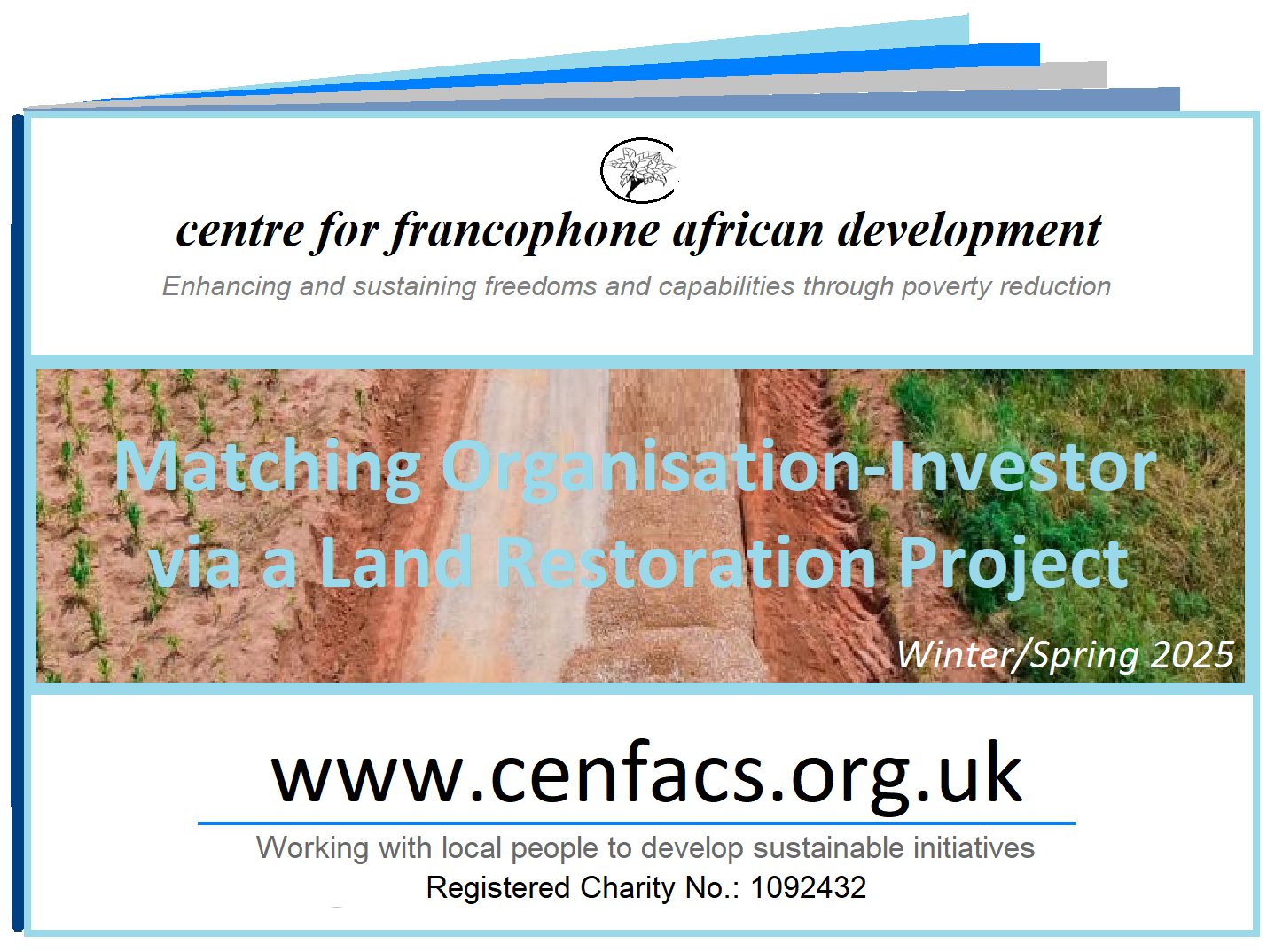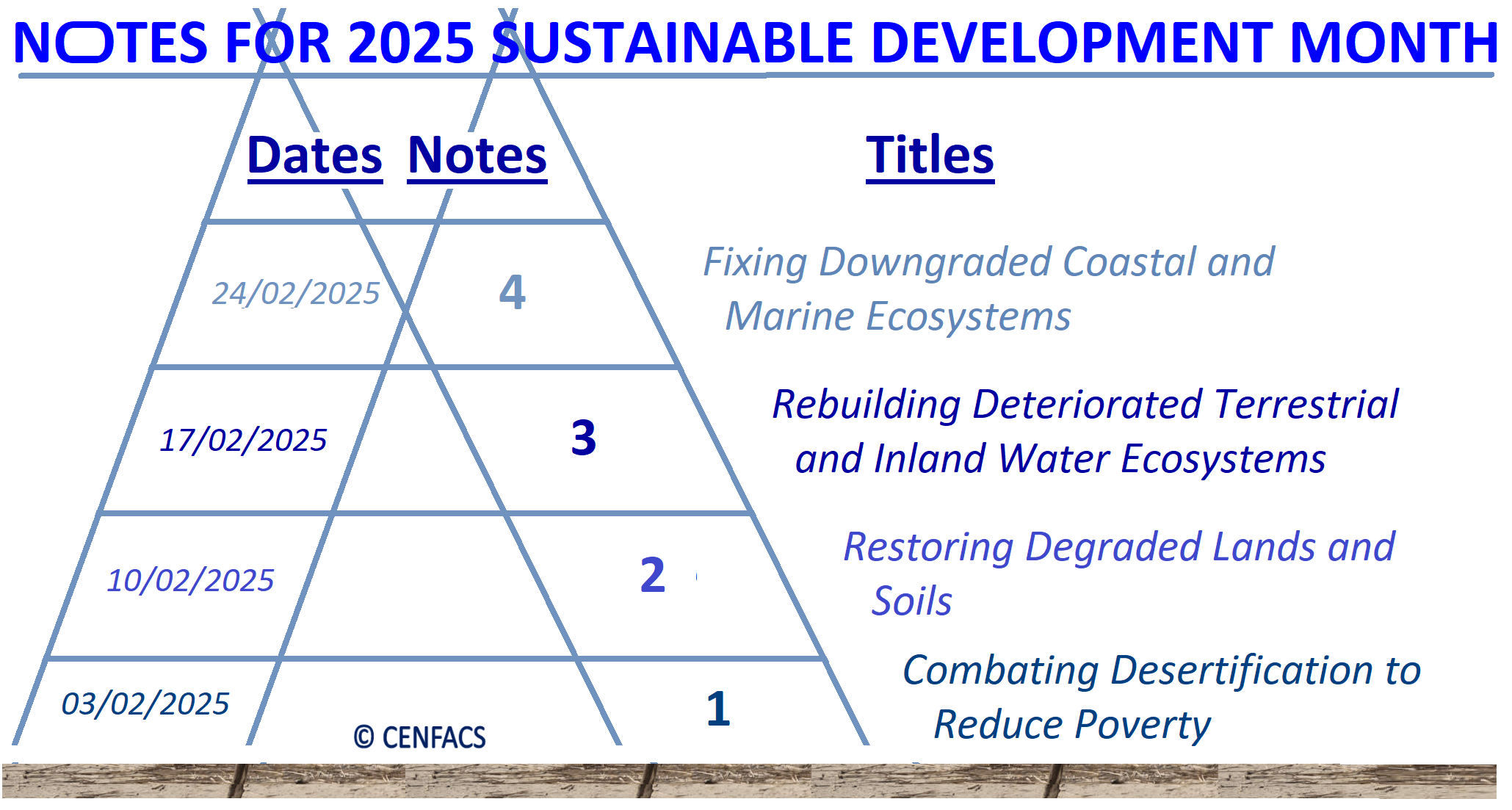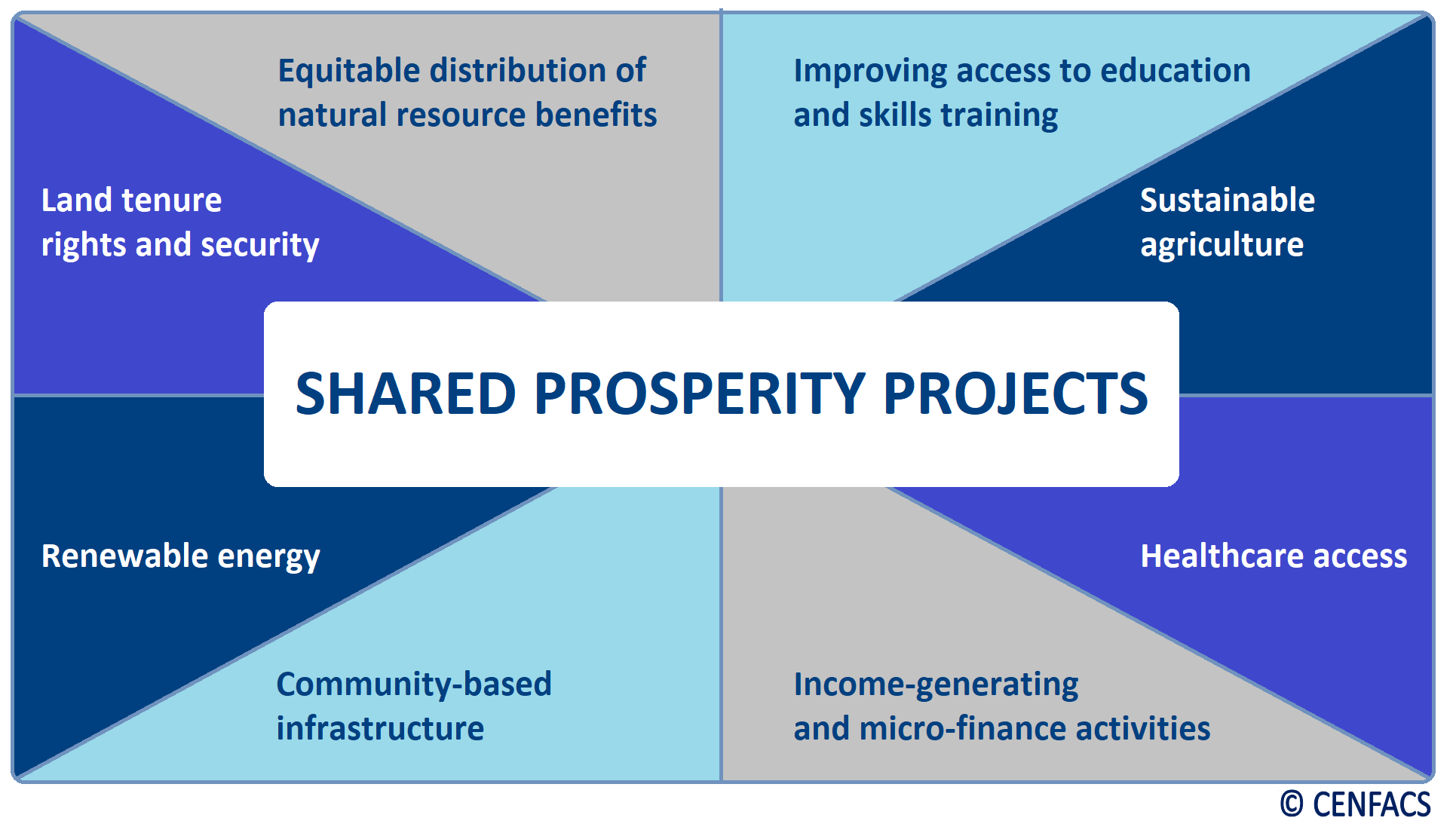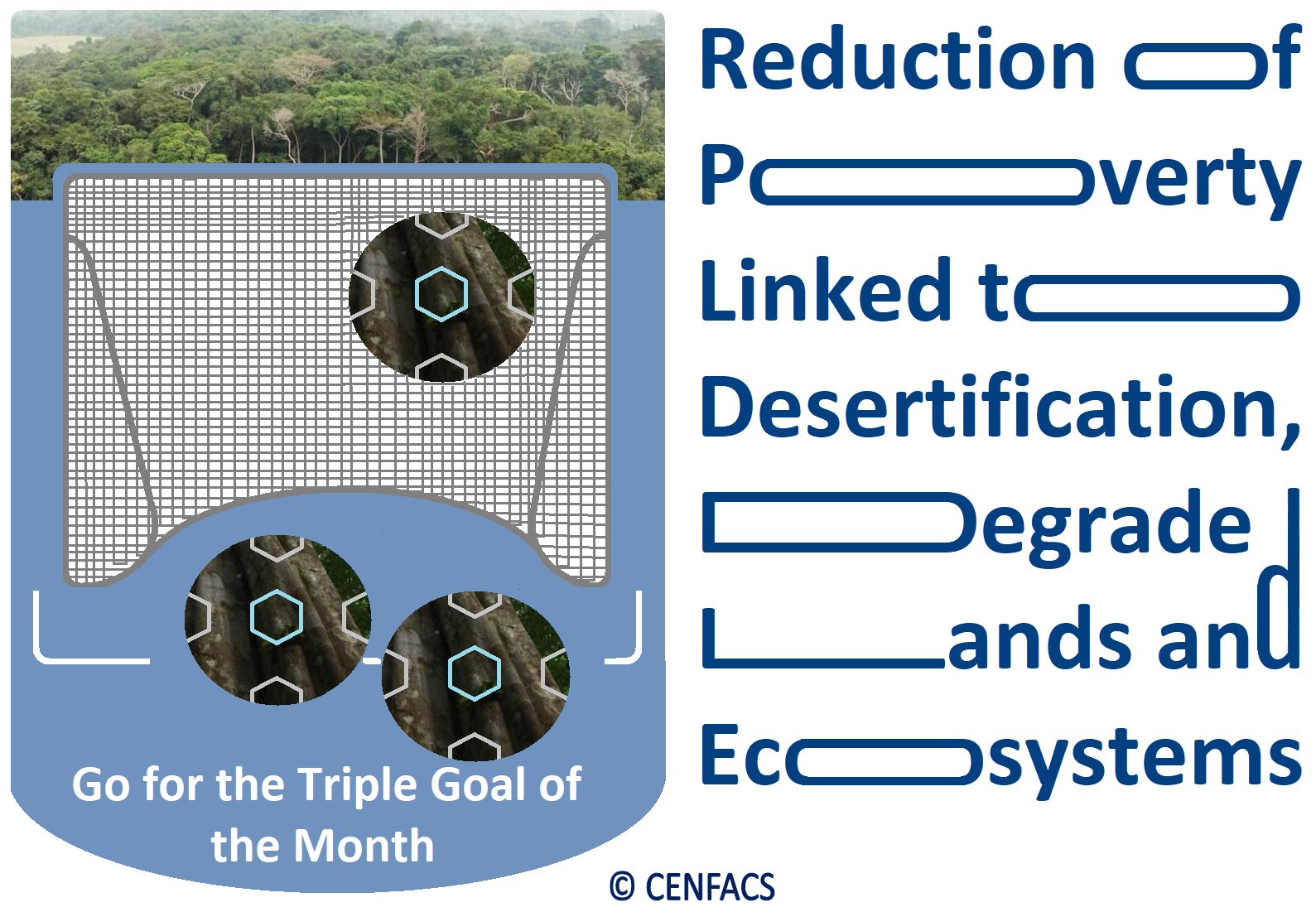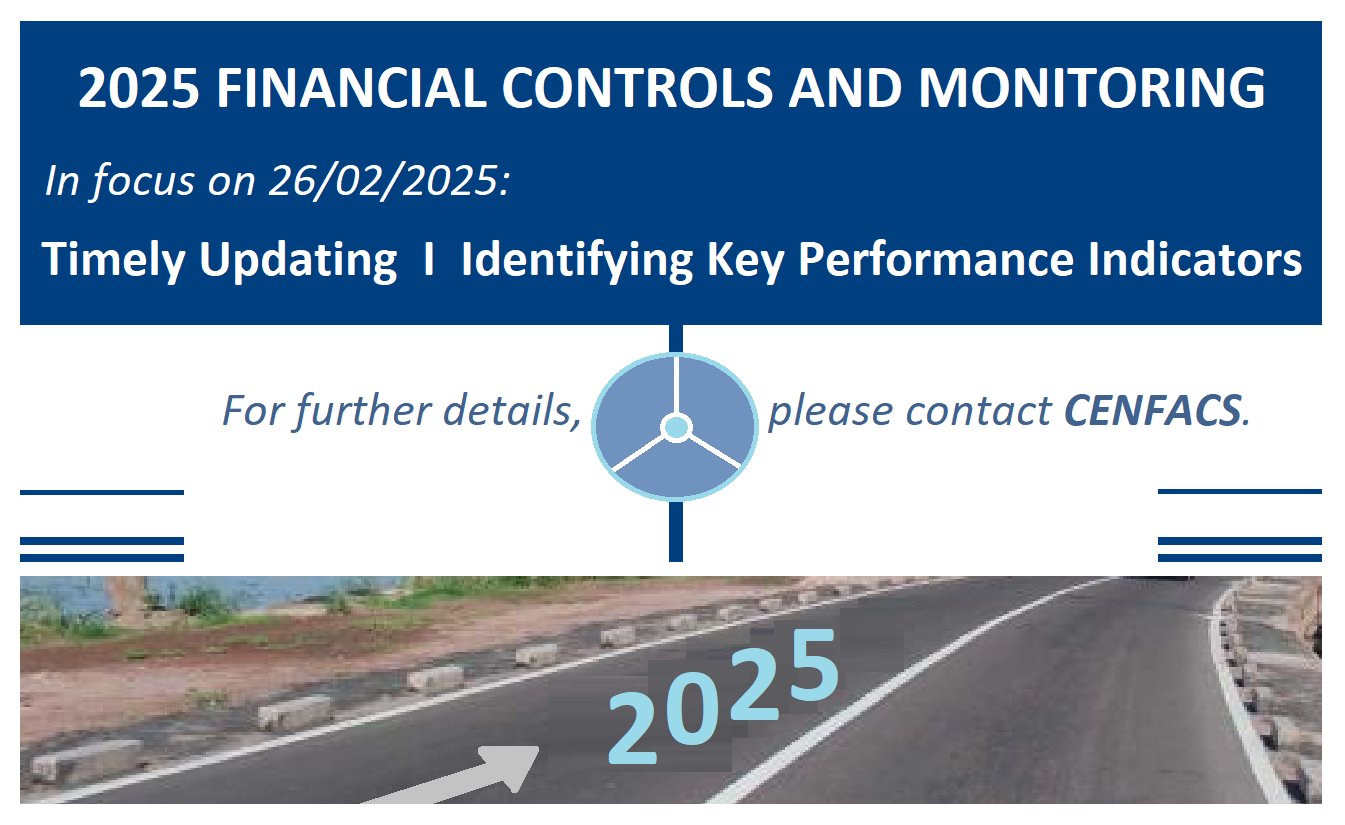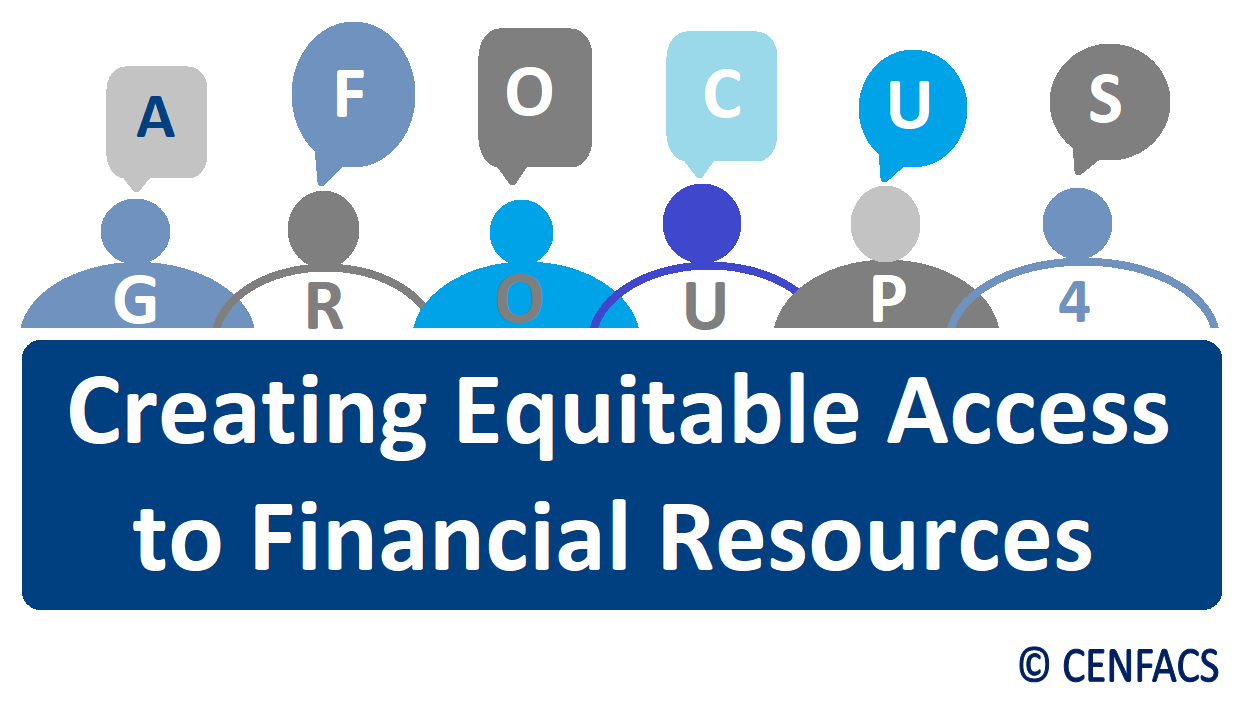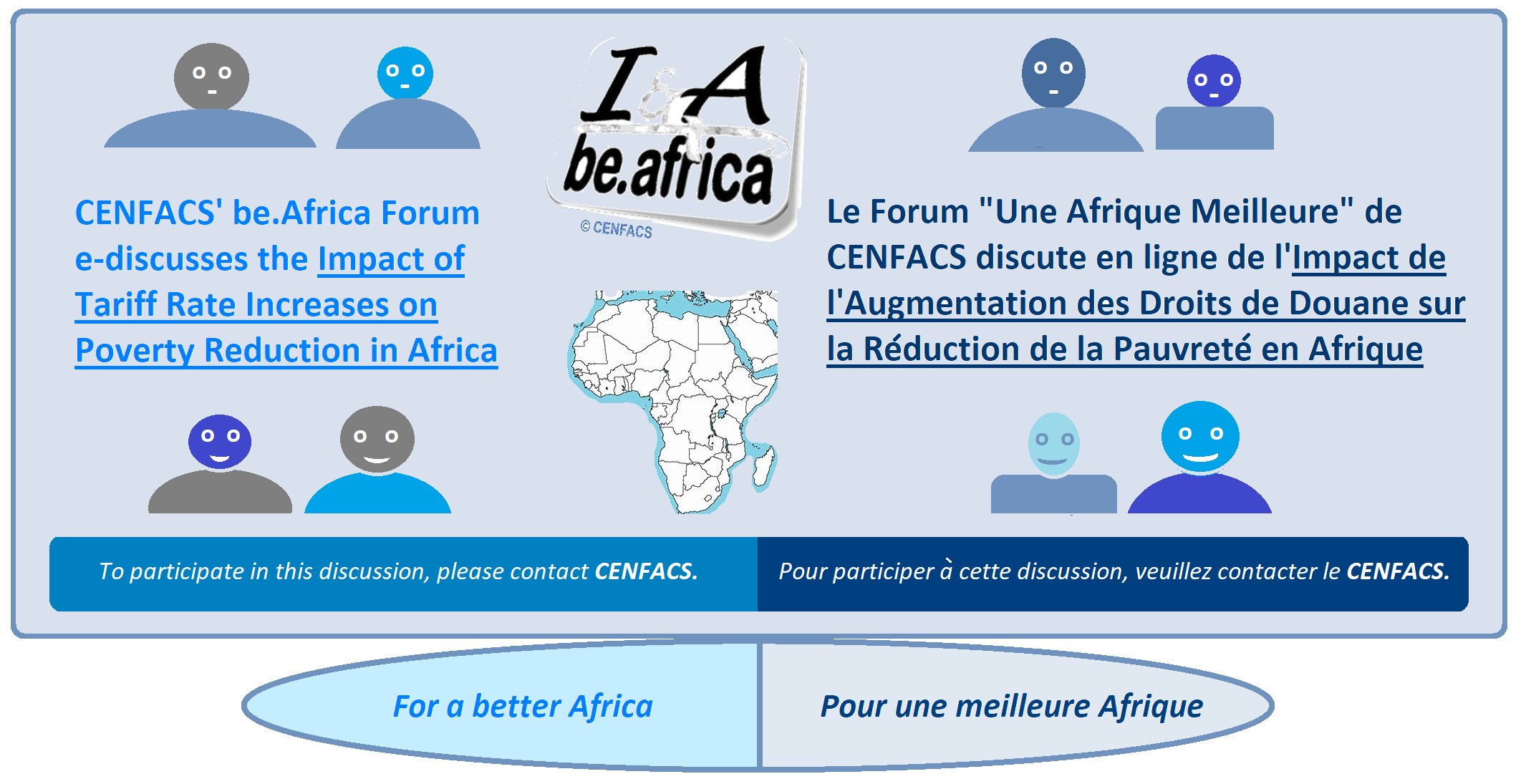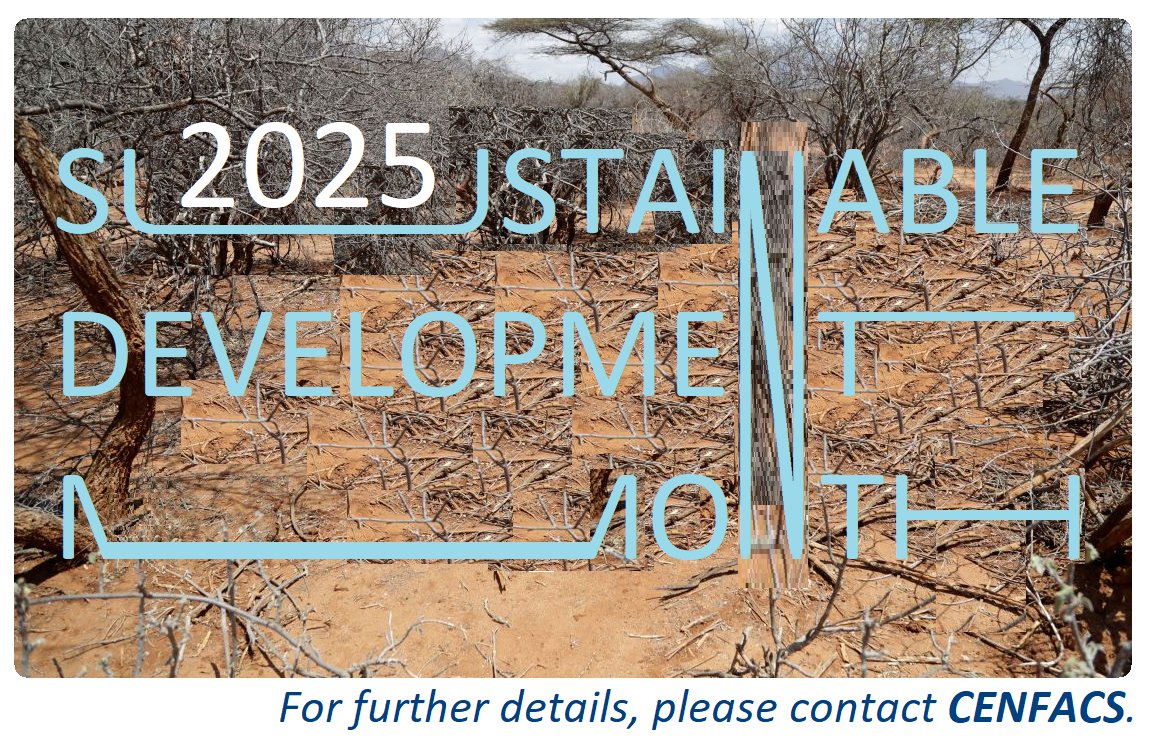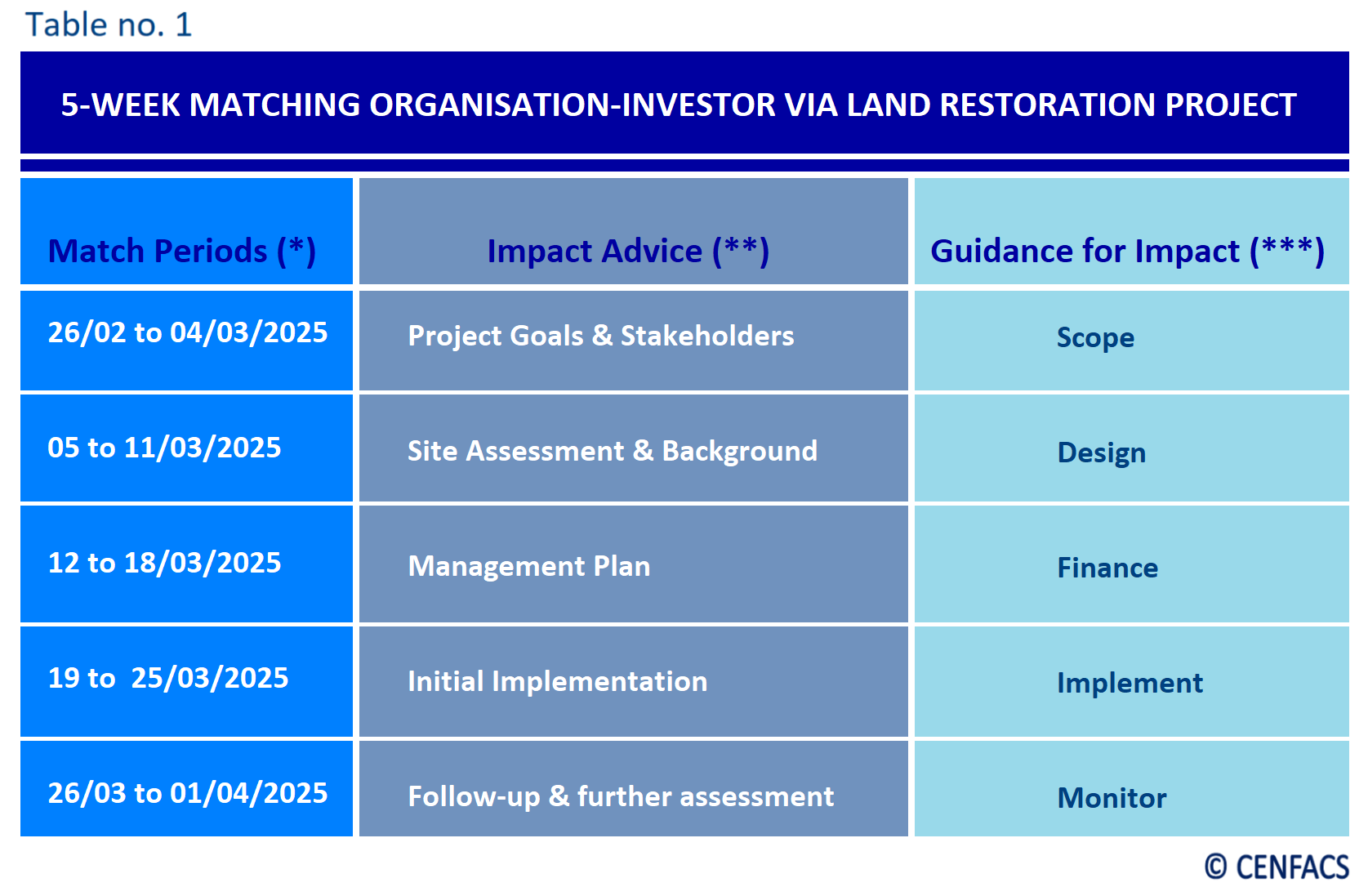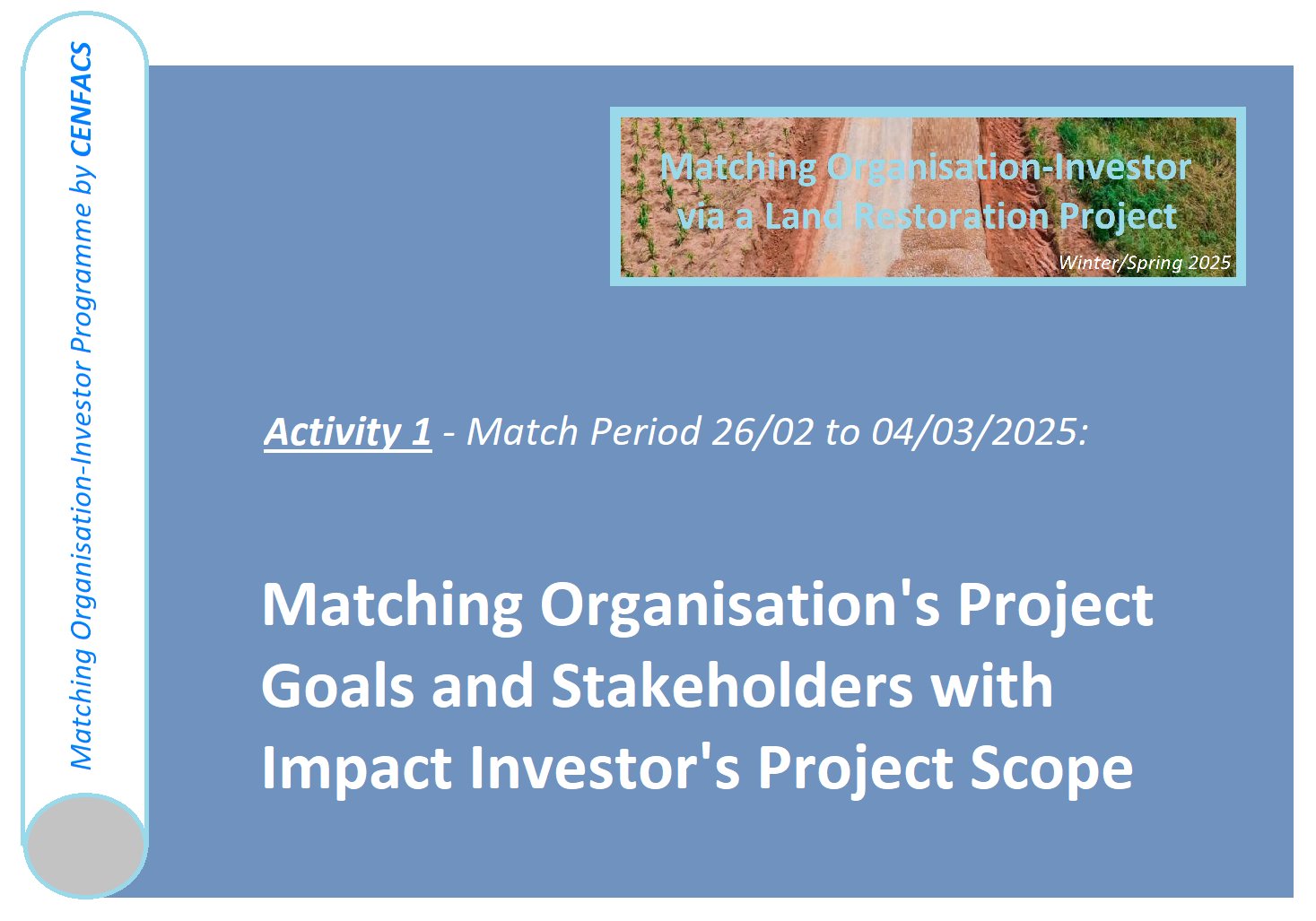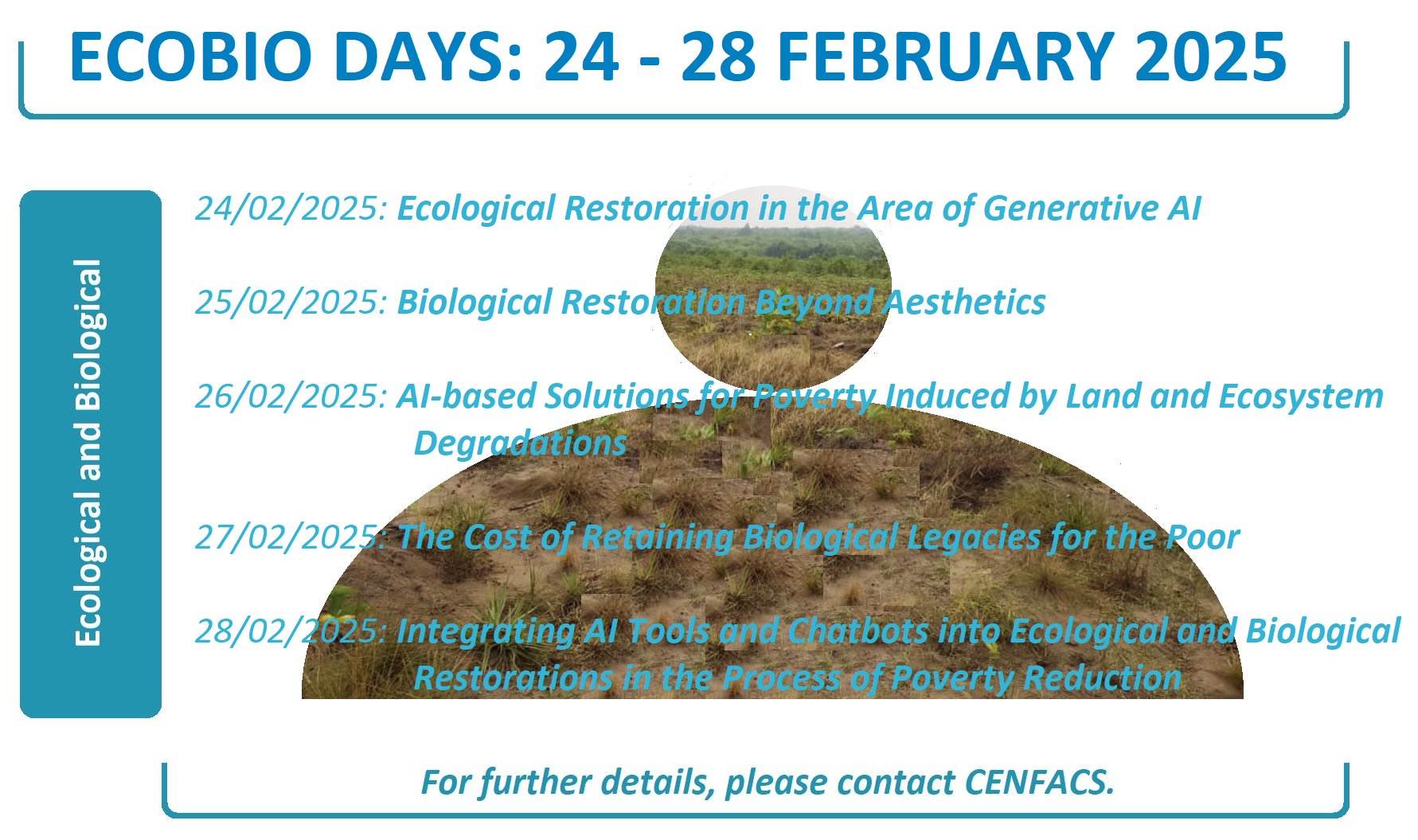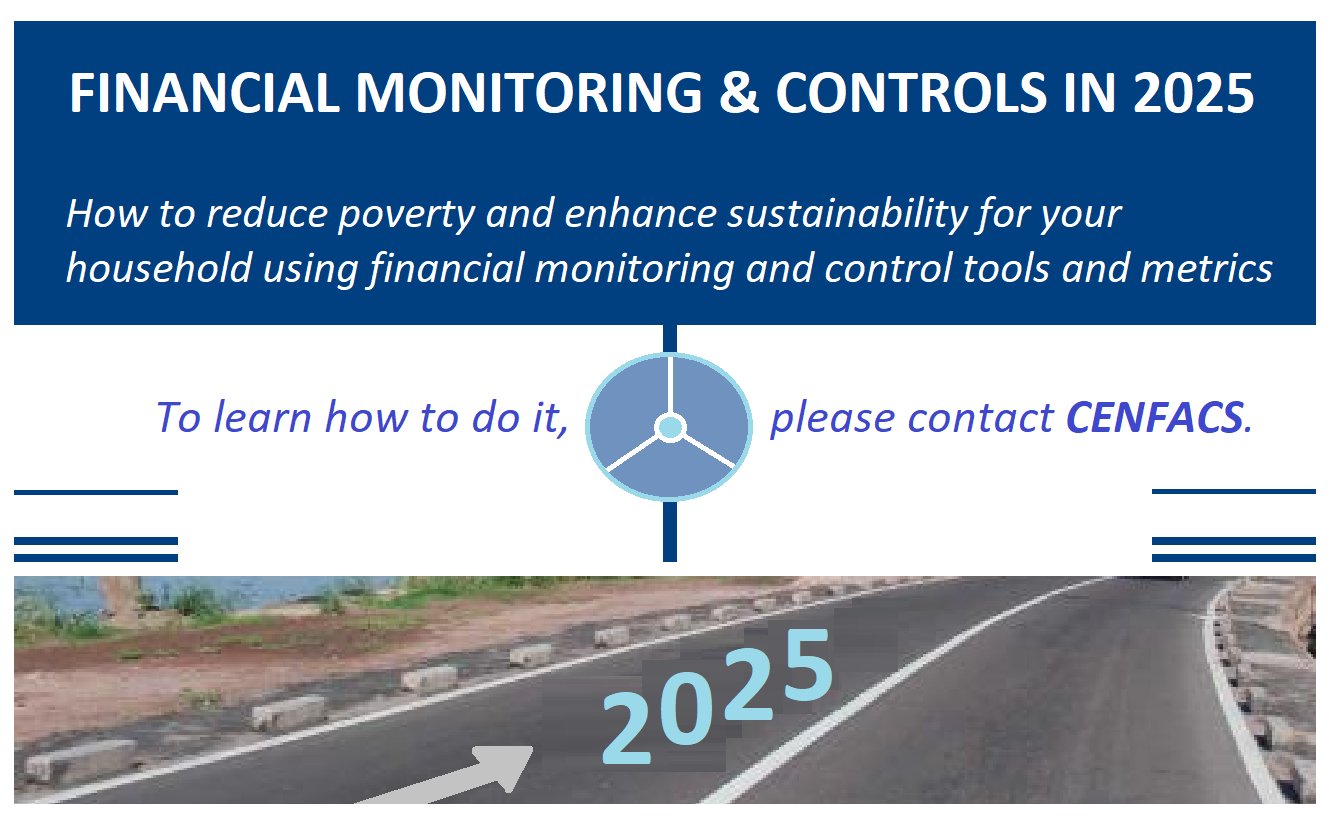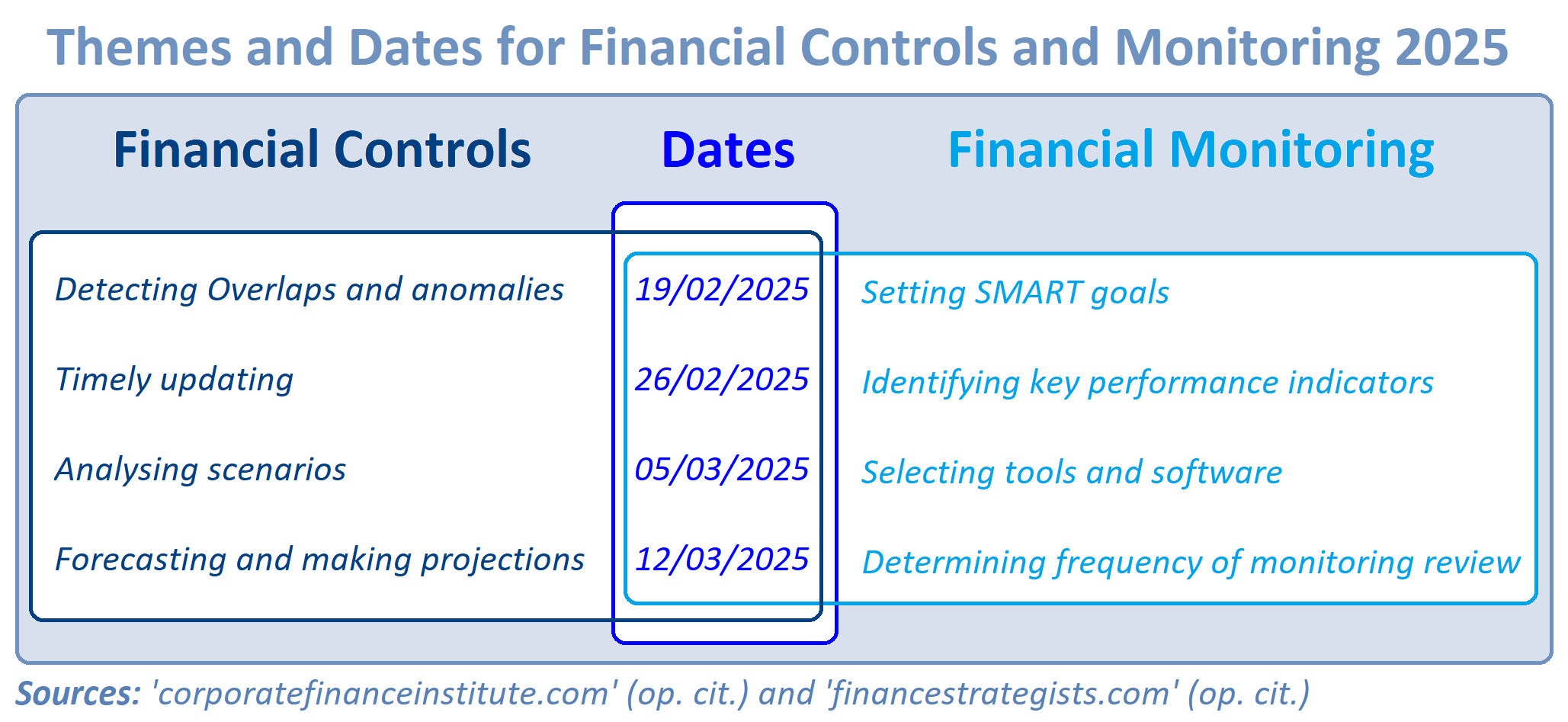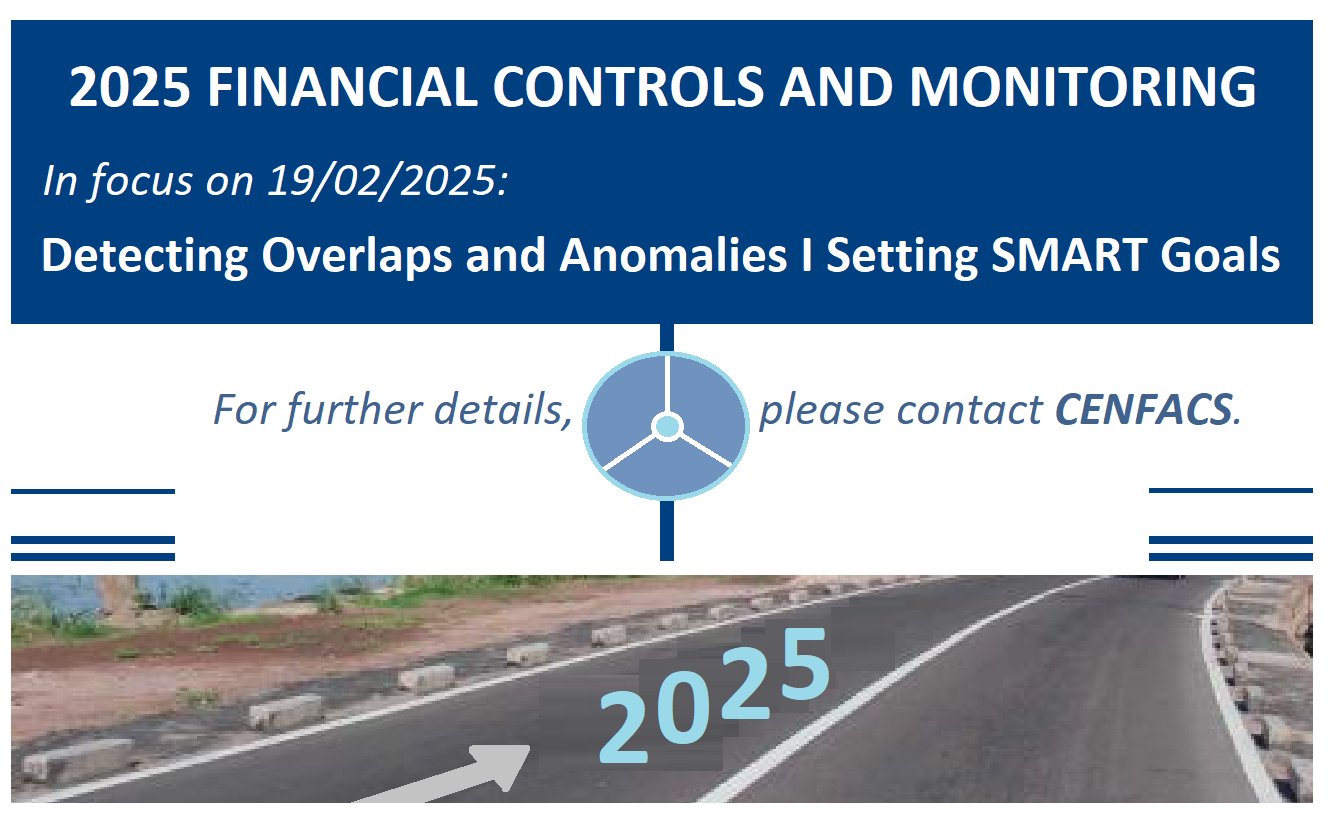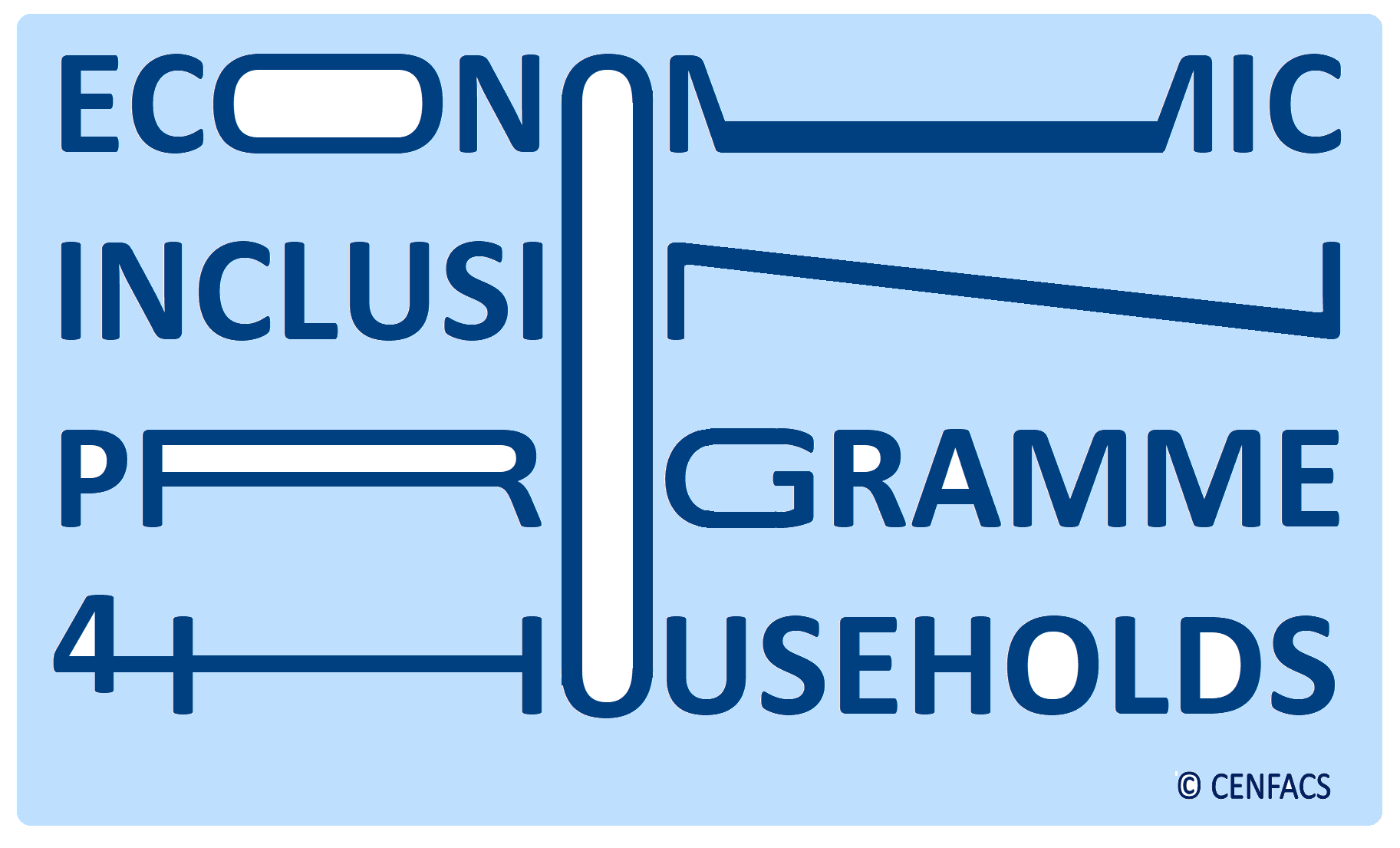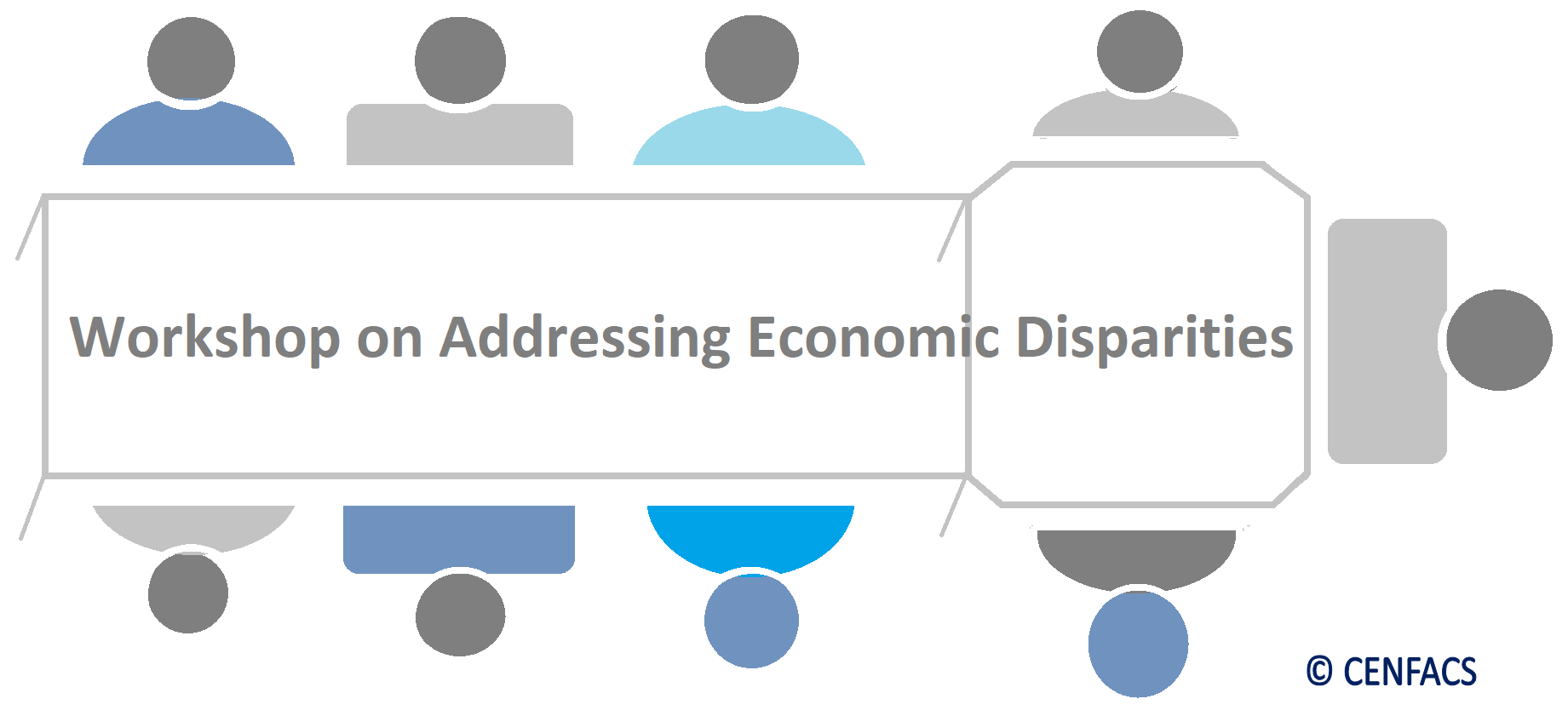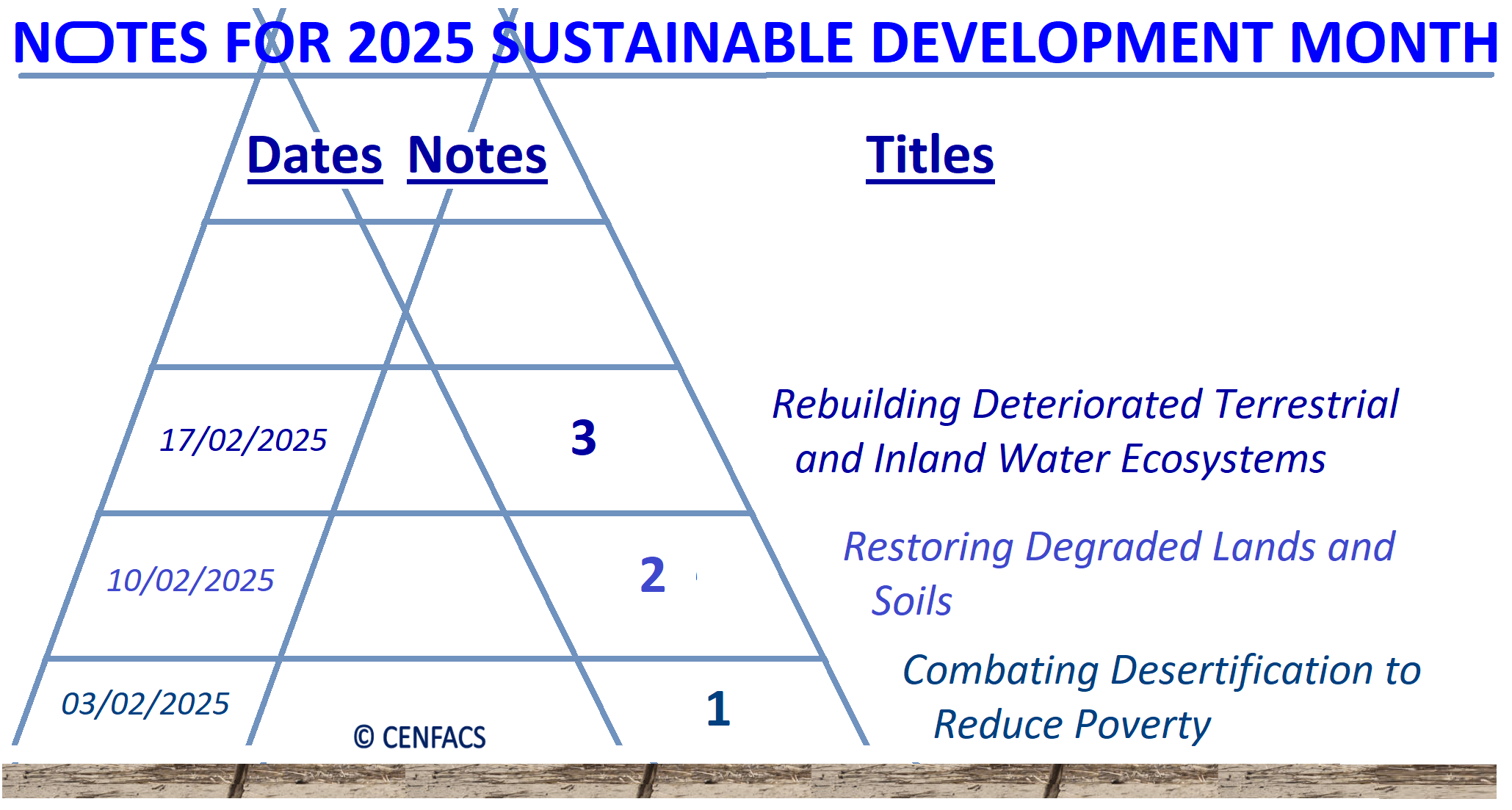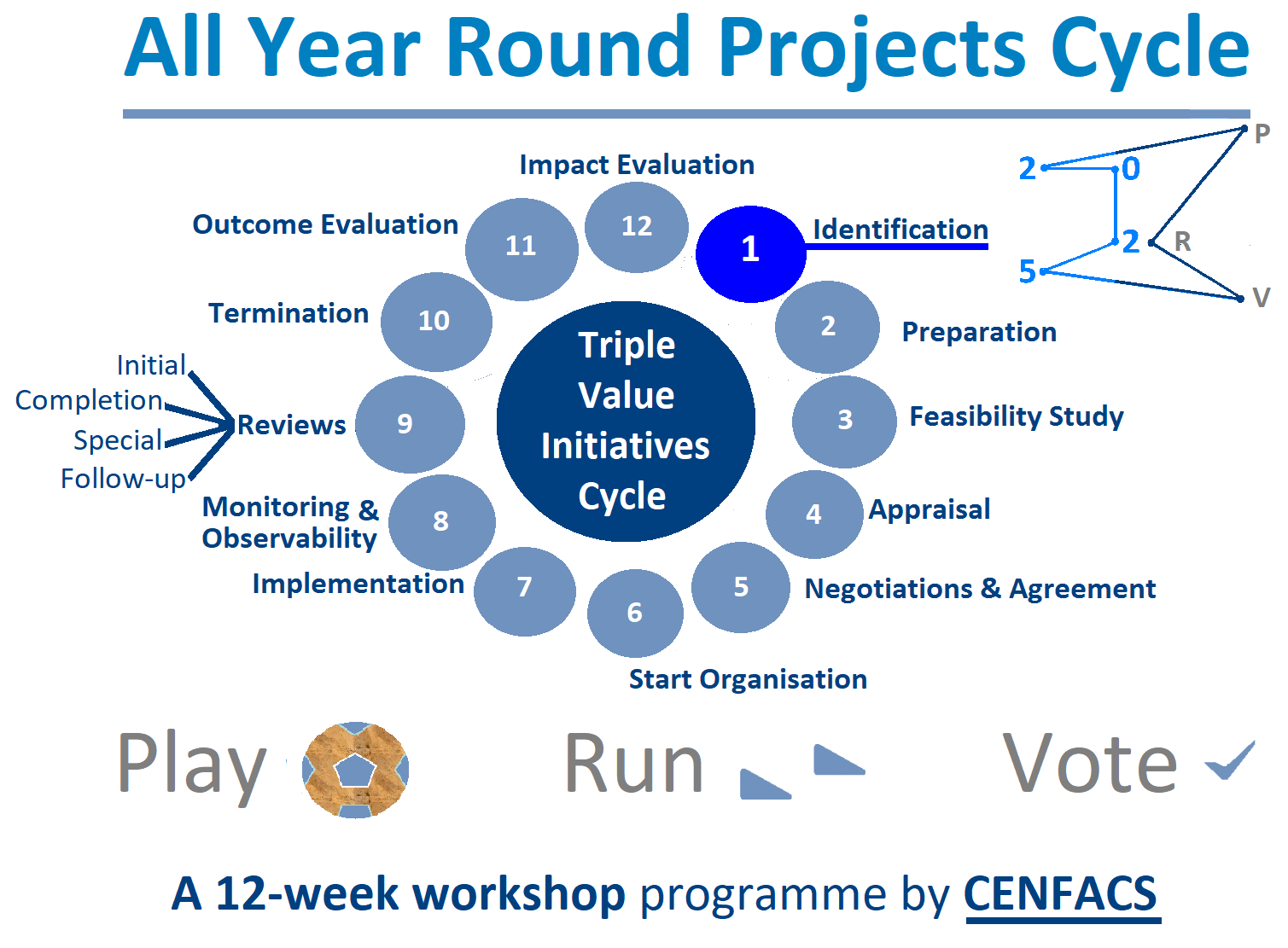Welcome to CENFACS’ Online Diary!
23 April 2025
Post No. 401
The Week’s Contents
• FACS Issue No. 87 of Spring 2025, Titled as African Charities and Finance for Climate and Poverty Reduction in Africa
• The Double Crisis Impacted Peoples of Kinshasa and Tanganyika Ask for Your Help
• Protection Key Note 4 from Wednesday 23/04/2025: Protection of Households’ Intangible Assets
… And much more!
Key Messages
• FACS Issue No. 87 of Spring 2025, Titled as African Charities and Finance for Climate and Poverty Reduction in Africa
The 87th Issue of FACS deals with the strategies and tools that African Charities (ACs) use or can use to undertake climate planning and budgeting as well as frame their investment bid in order to seek and secure or mobilise funds.
The 87th Issue of FACS is a study on how ACs are trying to access funds through capacitated and empowered local institutions where they operate. This is without ignoring any efforts they may do to work with the private or for-profit sector on climate change issues. In other words, the 87th Issue of FACS is an investigation on how ACs are trying to collaborate and partner with others to improve their capacity and coordination to manage issues relating to climate finance.
The 87th Issue also treats of finance for poverty reduction. Indeed, securing climate finance does not necessarily imply obtaining finance for poverty reduction. That is why the Issue will as well work on the use of financial instruments that enable ACs to access funds and respond to the needs of their users and the locals. In this respect, the 87th Issue is a check whether or not there is an alignment between ACs strategy for climate finance and poverty reduction finance. And if there is, where this alignment leads to.
The 87th Issue analyses the relationship between climate finance and finance for poverty reduction. Specifically, it will highlight the interconnectedness between climate change and poverty. It is known that climate change can exacerbate poverty by causing natural disasters, food insecurity, and displacement, while poverty can make people and communities more vulnerable to climate impacts.
Far from being a catalogue of challenges and barriers, the 87th Issue looks at if there are some improvements in ACs finance strategies regarding both climate and poverty reduction issues. In particular, the 87th Issue argues about the following:
σ the integration between strategy for climate finance and strategy relating to finance for poverty reduction since there are co-benefits and synergies between climate change reduction and poverty reduction initiatives
σ a model of working together between ACs and all other actors in mobilizing climate finance and finance for poverty reduction and sustainable development
σ the alignment between climate finance and finance for poverty reduction
σ the improvement of ACs project planning that does not only reflect the needs of climate, but also that considers the request of those of living in poverty in Africa
σ the tracking of both climate funds and funds for poverty reduction and sustainable development
σ the development of frameworks that include both climate investment and impact investing in poverty reduction
σ the improvement in planning and coordination between climate change projects and poverty reduction projects.
To read the key summaries about this new Issue, please go to the Main Development section of this post.
• The Double Crisis Impacted Peoples of Kinshasa and Tanganyika Ask for Your Help
This is an appeal to light a blaze of hope for those who have been recently affected by torrential rains in the city of Kinshasa and in Tanganyika province in the Democratic Republic of Congo.
Since 4 April 2025, the rainfall that affected Kinshasa caused flooding and landslides that have resulted in casualties and damages.
Indeed, the website ‘reliefweb.int’ (1) reports that
“According to the International Federation of Red Cross and Red Crescent Societies (IFRC), as of 7 April, 33 people have died and 46 were injured due to the overflow of Ndjili River, affecting 13 out of 24 municipalities in Kinshasa city area”.
The same ‘reliefweb.int’ states that
“The IFRC reports, as of 13 April 2025, 165 fatalities, 28 injured persons, more than 7,000 displaced people (a number of these people across four relief sites) and a total of over 60,000 affected people across the Kinshasa capital city area”.
Similarly, the Rugumba River in Tanganyika province burst its banks, inundating larges areas of Kalemie and Nyunzu territories, destroying homes, schools and agricultural land.
According to ‘news.un.org’ (2), this severe flooding caused by torrential rains in Tanganyika has displaced nearly 10,000 people.
From the perspective of ‘reliefweb.int’ (op. cit.), this unfolding emergency reflects the double crisis facing the Democratic Republic of Congo, where extreme weather shocks such as flooding compound the suffering caused by ongoing conflict and mass displacement.
“Tanganyika and South Kivu are among four eastern provinces where some 2.3 million people are affected by ongoing conflict, according to the UNHCR’s spokesperson quoted by ‘news,un.org’ (op. cit.)”.
As a result of this double crisis, there are many threats like the spread of epidemics, hunger, malnutrition, poor sanitation, lack of safe drinking water, etc.
Yet, it is possible to help limit the life-threatening and -destroying damages from the double crisis (that is, negative impacts from armed conflicts and weather shocks) on the Congolese. It is practically feasible to mitigate the adverse impacts of bad weather and natural catastrophes as well as of armed conflicts in the Eastern provinces of the Democratic Republic of Congo; conflicts that affect the supply and distribution of goods including in Kinshasa.
You can support the Double Crisis Impacted Peoples of Kinshasa and Tanganyika who Need Lighting a Blaze of Hope.
You can Light up a Blaze of Hope for them.
You can also donate £5 or more since the needs are urgent and pressing.
With the current international aid cuts, there are critical funding gaps/shortfall in humanitarian response. Your donation, however small it may be, can help reduce these gaps.
Through this appeal and your support, CENFACS aims to reach the Double Crisis Impacted Peoples of Kinshasa and Tanganyika.
You support will help
√ alleviate the suffering of the flood-affected communities in Kinshasa and Tanganyika
√ reduce the side effects of the chaos brought by torrential rains
√ avoid the risk of disease outbreak from stagnant and contaminated flood waters
√ respond to the flood victims’ need of food, shelter, safe drinking water, clean sanitation, health and education.
These flood victims (e.g., those left without shelter or a means to earn a living, those in food insecurity as key crops have been wiped out, etc.) need your life-saving humanitarian response right now.
Please help them!
To donate or light a blaze of hope, please get in touch with CENFACS.
• Protection Key Note 4 from Wednesday 23/04/2025: Protection of Households’ Intangible Assets
The last key note of Asset Protection is on Protection of Households’ Intangible Assets. To compose this note, let us explain the meaning of households’ intangible assets and how CENFACS can work with its community on this matter. Since this is the last note, we shall as well deliver our final thought on theme of Asset Protection, theme of the Month of Protection.
• • What Are Household Intangible Assets?
It emerges from the asset protection literature that household intangible assets are non-physical items of value held by a household. These items include knowledge, skills, reputation, and consumer relationships. These assets are not tangible (that is material) like physical property. Despite their immateriality aspect, they contribute to a household’s wealth and well-being.
These assets not every household possess them Poor households lack sufficient intangible assets; assets which could provide economic security ad opportunities for these households to escape from poverty.
But, what are these assets?
• • Types of Poor Households’ Intangible Assets
Among intangible assets that poor households may possess include the following ones:
≈ Social capital: Strong social networks and relationships can provide support, information, and opportunities
≈ Human capital: Skills, knowledge and education are valuable assets that can lead to better employment and income prospects
≈ Political capital: The ability to influence decisions and policies can protect the rights and interests of marginalised communities
≈ Cultural capital: Access to cultural resources and opportunities can enhance wellbeing and social mobility
≈ Access to credit: Financial inclusion and access to credit can make poor people to invest in and improve their livelihoods.
Household intangible assets are valuable as physical ones. The lack of intangible assets can lead to economic hardships and limit access to education, better housing, and a better standard of living. In other words, when households – especially the poorest ones – lack or have insufficient intangible assets, they may experience some difficulties in securing employment, accessing financial resources, receiving support in time of crisis, advocating for their needs, etc.
Some households making our community could be aware about the impact of limited intangible assets on them. Others may not be informed about this impact. For those households that would like to be aware and get more information about it, they can work with CENFACS on household intangible asset protection.
• • Working with the CENFACS Community Members on Intangible Asset Protection
It is about focussing on the various elements to make intangible asset protection works for them. This involves a multi-faceted approach emphasising on education and awareness, legal support and asset-based development initiatives that leverage legal frameworks, seek licensing or franchising opportunities while ensuring that the transfer of creation of any intangible assets is properly done.
Therefore, working with them will be about helping them to
√ be informed about their rights in terms of intangible asset protection
√ know or learn areas of intangible asset protection policies, laws and regulations
√ formalise their rights (e.g., intellectual property rights)
√ secure contracts (where households have the right to exploit their assets)
√ maintain secrecy of their knowledge and skills against those who might misuse the information on them
√ license and franchise their intangible assets if necessary
√ understand legal frameworks that govern intangible asset protection
√ prioritise protection according to asset value
√ signpost them for assistance to intangible asset protection organisations
√ monitor their assets
√ adapt their asset protection strategies according to circumstances of life and economic situations
etc.
The above are just some of ways CENFACS could support the community regarding intangible asset protection. These support services or products make up our financial guidance service relating to intangible asset protection.
• • Final Thought on Asset Protection
All households – rich and poor – need protection of their assets. They require a set of strategies designed to safeguard their wealth from various risks. Asset protection is even important for poor households. This is whether it is about their finances or productive equipment or to enhance the quality of their life or their intangible belongings.
These assets need protection and are important for livelihood and asset-based poverty reduction. There are strategies to protect them. As we have shared together our knowledge on them throughout this asset protection, these strategies include social protection programmes, asset-building initiatives, legal and regulatory frameworks, financial inclusion programmes, educational and awareness programmes, asset transfer programmes, and asset protection trusts. These strategies are helpful in keeping protecting household assets. Without protection, it is difficult to see how household assets and their associated wealth can be properly passed onto future generations and avoid intergenerational asset-based poverty.
Those who need help and support about financial guidance on asset protection and/or for any of the matters listed above falling within our capacity or relating to the Protection Month, they can contact CENFACS.
Extra Messages
• Climate-resilient Asset Building Programmes for Households
• Supporting Networking and Protection against Poverty in 2025
• All-year Round Projects Cycle (Triple Value Initiatives Cycle) – Step/Workshop 10: Terminating Your Play, Run and Vote Projects
• Climate-resilient Asset Building Programme for Households (CrABP4Hs)
We are running a new programme starting from this week, This programme is part of our aim of continuously empowering households, particularly those making our community. The new programme, which is included in our Financial Controls Project, takes into account the elements of asset protection and Financial Resilience Programme for Households, which we ran last year at this time of the year.
To better introduce this new programme, let us briefly explain and provide the areas we have selected in order to work with households.
• • Basic Understanding of CrABP4Hs
CrABP4Hs is set of planned projects that focuses on improving the ability of homes and their occupants to withstand the impact of climate change, like extreme weather events, flooding and rising temperatures. Through this programme, it is expected that homes will be more durable, energy-efficient, and adaptable to the changing climate, while supporting communities in building their overall resilience.
In the context of Financial Controls Project, CrABP4Hs will focus on ways of supporting households in building their overall resilience. From this perspective, CrABP4Hs will include the following four elements which frame our work with these households:
≈ Capacity building
≈ Resilience into your home
≈ Financial incentives
≈ Supporting communities.
These elements will be looked at from the perspective of households since we are trying to work with them so that they could build their assets by adopting climate-resilient approach to these assets. These elements make up the following working plan with them.
Let us kick off the first element of our CrABP4Hs, which is Capacity Building.
• • Climate-resilient Asset Building Programme for Households – In Focus from Wednesday 23/04/2025: Capacity Building
To work with households making our community so that they can build or strengthen the capacity they need in order to build their assets in a climate-resilient way, it is better to explain capacity building and its key aspects.
• • • What Is Capacity Building in the Context of CrABP?
Capacity building can be approached in many ways and areas of life. In the context of a climate-resilient asset building programme, capacity building refers to enhancing the skills, knowledge and resources of individuals and organisations to effectively plan, design, construct, and manage assets that are resilient to climate impacts. It is about strengthening the ability of communities and institutions to adapt to and mitigate the effects of climate change on their built environment.
Households can participate or even take a lead in the planning, designing, construction and management processes of their assets so that the latter could be resilient to climate impacts. To participate, they need a certain level of capacity. And they do not have it, they can build it.
• • • Essential of Aspects of Capacity Building for Households in the Context of CrABP
They include strengthening of technical skills, improving household capacity, empowering households’ communities, promoting knowledge sharing and collaboration, and access to resources. Let us briefly explain each of these aspects.
Regarding the strengthening of skills, households can take basic training in climate-resilient building design, construction techniques, and the use of appropriate materials and techniques. This training can help them understand if their home is climate-resilient or not.
Concerning the empowerment of households’ communities, every household has relations with a number of communities that make that household to live their life. It is useful for households to engage with its communities in the planning and implementing climate-resilient assets if they want their needs and priorities to be properly met.
As to the improvement of household capacity, it is the ability of households to develop and implement climate-resilient policies, procedures, and practices.
As far as the promotion of knowledge sharing, it is possible for households to share their knowledge on climate-resilient building matters. They can even create a platform for such sharing.
With regard to access to resources, it is desirable for households to have access to technical and financial resources they need to implement their climate-resilient asset projects or plans.
The above-mentioned aspects of capacity building show that it is possible for households to manage them. For instance, being able to manage these aspects of capacity would enable households to easily communicate with maintenance personnel dealing with their properties.
Those households that are struggling to develop their capacity in order to build climate-resilient assets, they can work with CENFACS.
For any queries and/or enquiries about Capacity Building in the context of CrABP as well as Climate-resilient Asset Building Programmes for Households (including how to access this programme), please do not hesitate to contact CENFACS.
• Supporting Networking and Protection against Poverty in 2025
The Month of Protection within CENFACS is also a giving one towards protection. It is the month of supporting CENFACS’ Networking and Protection Project (NPP). To support this project, one may need to understand it.
• • What Is CENFACS’ Networking and Protection Project?
It is a child poverty reduction initiative designed to help and support the vulnerably poor children from HARMS, THREATS and RISKS from any forms of exploitation, neglect and abuse in Africa. The project helps and supports them through the improvement of the flow of information, knowledge development, self-help activities, the increase and diversification of opportunities and chances together with and on behalf of these children.
The project involves building and strengthening our connections within our community, fostering collaboration, and enhancing safety.
NPP contains three elements as follows.
a) Networking and protection for individual needs: It includes identifying protection needs for those in need of particular attention within our community, create networks of protectors, and implement safety measures to protect community members.
b) Networking and protection for community development: It is about connecting our members and sister organisations to poverty reduction spaces for resource sharing, knowledge exchange, and the development of protection and poverty-relieving solutions.
c) Networking and protection for a better world: It is about helping our members to be organised around shared concerns and work together to bring about a better world.
One can back this project by Supporting Networking and Protection against Poverty in 2025.
• • What Supporting Networking and Protection against Poverty in 2025 Is about
It is about the following:
√ Improving the flow of information with and amongst the vulnerable people and communities for poverty relief
√ Preventing and responding to any forms of vulnerability threats and risks coming from close and global environments by using protection tools and metrics at our disposal
√ Re-empowering the vulnerable by increasing and diversifying opportunities and strengths amongst them.
• • What Your Support Can Achieve
It will help
√ To raise awareness and improve the circulation and dissemination of information for poverty reduction and vulnerability relief
√ To prevent human exploitation (particularly child exploitation) and respond to child protection and safeguarding issues
√ To re-empower and re-strengthen poor people and communities’ capacities and capabilities to protect young generations
√ To widen and diversify opportunities to the vulnerable to escape from poverty
√ To develop a well-informed base to reduce information gap and other types of vulnerabilities linked to the lack of networking, interconnectedness and protection.
• • How to Support Networking and Protection against Poverty in 2025
You can DONATE, PLEDGE AND MAKE A GIFT AID DECLARATION of any amount as a way of supporting Networking and Protection against Poverty in 2025.
To donate, gift aid and or support differently, please contact CENFACS.
You can donate
*over phone
*via email
*through text
*by filling the contact form on this site.
On receipt of your intent to donate or donation, CENFACS will contact you. However, should you wish your support to remain anonymous; we will respect your wish.
• All-year Round Projects Cycle (Triple Value Initiatives Cycle) – Step/Workshop 10: Terminating Your Play, Run and Vote Projects
There are various reasons that can lead to project termination. ‘Taskmanagementguide.com’ (3) states that
“Failure and success are two basic reasons for terminating projects”.
The same ‘taskmanagementguide.com’ explains that success happens when project goals and objectives are accomplished on time and under budget, while failure occurs when project requirements are not met.
The above reasons for project termination can be related to the types of project termination to a certain degree; types which could be termination by addition or by integration or by starvation. In the end, what is project termination?
• • Defining Project Termination
There are similarities in the definition of project termination. To simplify the matter, let us refer to the definition of ‘taskmanagementguide.com’, which is
“Project termination is a situation when a given project is supposed to be closed or finalised because there’s no more need or sense for further continuation”.
Similarly, Project Management Institute (4) argues that
“Projects by definition are time bound, and must terminate”.
However, to effectively finalise a project, one needs to follow project closure procedures.
Let us follow project closure procedures to close out one of our all-year-round projects.
• • Example of Terminating Your All-year Round Projects: Case of Play Project
Realistically speaking, any of your All-year Round Projects close out just a week before 23/12/2025. As explained above, there is a procedure for terminating them. This procedure can be simple or complex depending on project.
Let say, you want to finalise your Play Project. To do that, we are going to use a 8-step model of terminating a project as provided by ‘taskmanagementguide.com’ (op. cit.)
• • • Terminating Your Play All-year Round Project
To terminate your Play Project, you need proceed with the following:
a) Close any agreements you made with any third parties
(e.g., if you borrow materials from the library to research on poverty reduction performance of African countries, you need to close the given borrowing agreement by returning the materials, which can be a book, video, tape, etc.)
b) Handover responsibilities and accountabilities
(i.e., transfer assignments to your play mates)
c) If you have been playing with friends and family members, you will dismiss them
d) Release the resources used
(e.g., returning books to the lending library)
e) If you open a project book to record your results and accounts, you need to close it
f) Record and report your lessons learnt and experiences
g) Accept or reject your result which in this case should be the best African Country Poverty Reducer of 2025
h) Share your result with the community and CENFACS by 23/12/2025.
The above is one of the possible ways of terminating your All-year Round Projects.
For those who would like to dive deeper into Terminating their Play or Run or Vote project, they should not hesitate to contact CENFACS.
Message in French (Message en français)
• Protection des Animaux Menacés en Afrique : Le Cas des Bonobos
Nous continuons à plaider pour la protection des animaux (faune) en Afrique et ailleurs dans le monde en développement, où les animaux sont tués, commercialisés illégalement ou illicitement et disparaissent à un point tel que certaines espèces sont au bord de la disparition. L’un de ces animaux qui a besoin de protection est le bonobo.
• • Que sont les bonobos ?
En bref, les bonobos sont des grands singes en danger critique d’extinction que l’on ne trouve qu’en République Démocratique du Congo. Comme les chimpanzés, les bonobos partagent plus de 98 % de l’ADN avec les humains. Ils ne vivent qu’à un seul endroit et c’est un endroit isolé – au cœur de la forêt tropicale de la République Démocratique du Congo, selon l’African Wildlife Foundation (5).
• • État de conservation des bonobos
Selon l’African Wildlife Foundation, les bonobos sont de plus en plus menacés par les êtres humains, qui les ont tués au point de les mettre en danger. On estime qu’il reste entre 15 000 et 20 000 bonobos sauvages. Ils sont en danger critique d’extinction.
Leur nombre diminue pour trois raisons principales : le braconnage, les obstacles à l’application des lois sur la faune et la gestion de la conservation, et les maladies. Ces raisons et d’autres sont avancées par la plupart des défenseurs (ses) de l’environnement et des organisations environnementales – comme Treehugger (6) – qui travaillent sur la question.
• • Moyens d’aider à sauver les bonobos
Pour sauver la population de bonobos, les actions de protection suivantes peuvent être prises :
# Réduire et mettre fin au commerce illégal de viande de brousse
# Faire respecter les lois sur la faune sauvage et la gestion de la conservation en République Démocratique du Congo, en particulier autour de l’habitat des bonobos
# Lutter contre la destruction et la dégradation de l’habitat des bonobos
# Améliorer la conservation de l’agriculture et le développement urbain à proximité de l’habitat des bonobos
# Effectuer des reboisements près des sites de bonobos pour maintenir le bonobo habitats
# Traiter les maladies infectieuses liées aux agents pathogènes d’origine humaine et naturelle trouvés chez les bonobos
# Soutenir l’action du CENFACS sur la protection des animaux menacés en Afrique, en particulier le plaidoyer sur les “Grandes Bêtes“
# Faire un don à des organisations caritatives et autres organisations bénévoles travaillant sur la question des bonobos ou à des campagnes similaires
# Faire un don pour protéger les espèces vulnérables comme les bonobos.
Les membres de notre communauté qui souhaitent plaider avec nous pour la protection des bonobos sont invités à s’impliquer dans cette campagne de plaidoyer. D’autres personnes peuvent également se joindre à nous.
Les organisations africaines qui travaillent sur les bonobos et qui ont la même préoccupation que la nôtre, elles peuvent partager avec nous leur expérience et travailler sur cette question de la protection des bonobos.
Pour vous impliquer ou partager votre travail sur la protection des bonobos, veuillez contacter le CENFACS.
Main Development
• FACS Issue No. 87 of Spring 2025, Titled as African Charities and Finance for Climate and Poverty Reduction in Africa
The contents and key summaries of the 87th Issue of FACS are given below.
• • Contents and Pages
I. Key Terms Relating to the 87th Issue of FACS (Page 2)
II. Interconnectedness between African Charities, Climate Finance and Poverty Reduction Finance (Page 2)
III. Climate Finance Needs of African Charities (Page 3)
IV. Climate Finance Challenges and Barriers Faced by African Charities (Page 3)
V. Climate Finance Opportunities for African Charities(Page 4)
VI. Climate and Poverty Reduction Finance Strategies and Tools for African Charities (Page 4)
VII. Instruments Financiers Permettant aux Organisations Caritatives Africaines d’Accéder à des Fonds (Page 5)
VIII. Améliorer la Planification des Projets des Organisations Caritatives Africaines en Tenant Compte du Climat et des Besoins des Pauvres(Page 5)
IX. Alignement du Financement de l’Action Climatique et du Financement de la Réduction de la Pauvreté(Page 6)
X. Intégration des Stratégies Relatives au Financement de l’Action Climatique et au Financement de la Réduction de la Pauvreté (Page 6)
XI. Survey, Testing Hypotheses, E-questionnaire and E-discussion on Climate Finance and Poverty Reduction Finance (Page 7)
XII. Support, Tool and Metrics, Information and Guidance on Climate Finance and Poverty Reduction Finance (Page 8)
XIII. Workshop, Focus Group and Booster Activity about African Charites’ Work on Climate Finance and Poverty Reduction Finance (Page 9)
XIV. Giving and Project (Page 10)
• • Key Summaries
Please find below the key summaries of the 87th Issue of FACS from page 2 to page 10.
• • • Key Terms Relating to the 87th Issue of FACS (Page 2)
There are three terms used in the context of this Issue of FACS. These terms are African charities, climate finance and poverty reduction finance. Let us briefly explain these key terms.
• • • • African charities
To explain African charities, let us first clarify the word ‘charity’. Our explanation of this word comes from ‘howcharitieswork.com’ (7) which provides three statements, which are:
“a) A charity’s aims have to fall into categories that the law says are charitable
b) It has to be established exclusively for what is known as public benefit
c) Charities can’t make profits (that is; all the money they raise has to go towards achieving their aims; a charity can’t have owners or shareholders who benefit from it)”.
The term African charities relate to charities from Africa. We presume that our African counterpart charities would share the above-mentioned rules for charity. We also assume that the law in African countries would classify the African charities we are talking about as charitable as it is in the UK.
• • • • Climate Finance
Climate Finance (CF) refers to financial resources mobilized to support climate change mitigation and adaptation efforts in developing countries. It aims to help countries reduce greenhouse gas emissions and build resilience to the impacts of climate change. It is critical element of the Paris Agreement with the Green Climate Fund being a key player.
According to the United Nations Framework Convention on Climate Change (8), climate finance is described as
“Local, national or transnational financing – drawn from public, private and alternative sources of finance – that seeks to support mitigation and adaptation actions that will address climate change” (p. 19)
Examples of CF initiatives include renewable energy projects, investing in climate-resilient infrastructure, supporting adaptation measures in vulnerable communities, etc.
To effectively combat climate change, African Charities need access to CF, but funding gaps persist in Africa. African Charities also require finance to reduce poverty.
• • • • Poverty Reduction Finance (PRF)
PRF, which aims to improve lives like CF, refers to financial resources required to address the root causes and consequences of poverty. PRF’s goal is to improve the living standards of people living in poverty, increase their income, and empower them to participate in economic and social life.
Examples of PRF projects include microfinance, investment in education and healthcare, social safety nets, and programmes to promote economic development.
The above-named three key terms shape the contents of the 87th Issue of FACS.
• • • Interconnectedness between African Charities, Climate Finance and Poverty Reduction Finance (Page 2)
Charities (here African charities), climate finance and poverty reduction finance are interconnected because climate change disproportionally impacts the poor, exacerbating poverty and hindering development.
Climate finance, which supports both mitigation and adaptation efforts, can help reduce poverty by mitigating climate change impacts and building resilience in vulnerable communities. Charities play an important role in both providing direct aid, advocating for policy changes and collaborating with governments and international organisations to ensure that climate finance is accessible and effective for the most vulnerable populations.
If one focuses on charities to explain this interconnectedness, one can argue that charities provides direct assistance to climate change-affected communities, advocate so that climate finance is effectively used to support poverty reduction efforts, collaborate with stakeholders on climate finance issues, and build capacity to manage climate risks and access climate funds.
For instance, during COP29 in Baku (9) charities advocated for the delivery of pledges made on climate finance and poverty reduction finance. At this COP29, developed nations pledged to channel $300 billion a year into developing countries by 2035 to support their efforts to deal with climate change.
• • • Climate Finance Needs of African Charities (Page 3)
African Charities need funding to address climate change and work with communities on climate change matter. According to the website ‘climatepolicyinitiative,org’ (10),
“Due to a lack of capacity and guidance to make accurate assessments and a lack of data, it is sometimes difficult to estimate their needs”.
They need both mitigation and adaptation resources, but mostly they require to meet investment adaptation needs which are underfunded. Their needs are not properly represented since climate finance flows are unevenly distributed between regions and sectors across Africa. Raising funds from their project beneficiaries and members for climate purposes is limited and the private sector can only provide a tiny portion of the climate finance they need. Briefly, there is a genuine need from African Charities to raise climate finance. However, many of these African Charities face barriers or challenges regarding climate finance.
• • • Climate Finance Challenges and Barriers Faced by African Charities (Page 3)
There are challenges and barriers that African countries face in accessing public and private climate finance. The African Climate Conversation (11) explains that these barriers are commonly similar to challenges in mobilising other types of developmental finance including an instable political context, a volatile macroeconomic situation, and weak institutional and regulatory frameworks.
African charities too face these challenges and barriers for accessing and mobilising climate finance in Africa. These challenges are both internal and external in the countries they operate.
Internally, they face weak institutions or institutional capacity relating to weak or lack of internal capacity and weak systems, lack of locally relevant data, etc. Externally, they are confronted with funding levels, international public finance terms (like debt, risk and liquidity).
Despite these challenges and barriers, there are opportunities or African charities can create their own windows of opportunities.
• • • Climate Finance Opportunities for African Charities (Page 4)
Climate finance opportunities can be scaled up or African charities can create their own ones. African charities can create their favourable conditions by proceeding with the following:
~ Improving their climate project planning and budgeting
~ Involving in locally-led climate finance initiatives
~ Enhancing collaboration and partnership over climate finance
~ Increasing diverse use of climate finance instruments (for instance, the use of concessional finance which can act as flexible and accessible finance tool)
etc.
By proceeding with the above practices, African charities will be in a better position to grab climate finance opportunities offered to them.
• • • Climate and Poverty Reduction Finance Strategies and Tools for African Charities (Page 4)
There are strategies and tools that African charities can use to undertake climate planning and frame their investment bid. In practical terms, they can use finance tools below.
a) Climate finance tools
They are as follows.
~ Climate budget tagging: It helps identify and track climate-related expenditures with a budget.
~ Green budgeting: It involves embedding climate targets and measures into the budget process.
~ Tools like Excel-based system can assist decision-makers in prioritizing climate action plans and evaluating initiatives.
b) Poverty reduction finance strategies and tools
They include loans, grants and other financial interventions aimed at lifting individuals and communities out of poverty. They imply strategies that improve economic opportunities, access to resources, and overall well-being, ultimately seeking to achieve sustainable poverty reduction. African charities use these strategies (like micro-finance, poverty alleviation funds, micro-finance for livelihoods, etc.) to lift their beneficiaries out of poverty.
• • • Instruments Financiers Permettant aux Organisations Caritatives Africaines d’Accéder à des Fonds (Page 5)
Il existe différents instruments que les organisations caritatives africaines peuvent utiliser pour accéder aux fonds. Parmi ces instruments, on peut citer le financement par fonds propres (comme les actions et les obligations) et diverses formes de garanties et d’investissements en quasi-fonds propres. D’autres options comprennent des partenariats avec le secteur privé, des outils d’atténuation des risques et des instruments tels que le paiement des services écosystémiques.
Par exemple, le financement individuel et communautaire sous forme de microfinancement, de financement participatif et de programmes de prêts communautaires peut permettre aux organisations caritatives africaines d’accéder à des fonds.
De plus, les organisations caritatives africaines peuvent accéder à des fonds par l’intermédiaire d’institutions locales dotées de capacités et d’habilitations en tirant parti des connaissances locales, des relations et de la capacité de ces institutions à attirer et à gérer des fonds. Il s’agit notamment d’utiliser les entreprises communautaires locales, d’attirer des investissements par le biais de partenaires locaux et de s’engager avec les locaux pour des initiatives de financement et de politique.
• • • Améliorer la Planification des Projets des Organisations Caritatives Africaines en Tenant Compte du Climat et des Besoins des Pauvres (Page 5)
Pour améliorer la planification des projets qui reflète les besoins du climat et des pauvres en Afrique, les projets des organisations caritatives africaines doivent être conçus en tenant compte de l’action climatique communautaire, en se concentrant sur le renforcement de la résilience et l’adaptation aux conditions changeantes.
Il s’agit de favoriser les partenariats, de s’engager dans une planification urbaine intégrée et de mettre en œuvre des projets pilotes pour relever des défis spécifiques. Dans ce processus de planification, il est également important de sensibiliser les gens aux impacts des changements climatiques et à l’importance des solutions locales.
• • • Alignement du Financement de l’Action Climatique et du Financement de la Réduction de la Pauvreté (Page 6)
Il est possible d’aligner le financement de l’action climatique et le financement de la réduction de la pauvreté. Selon le Fonds Monétaire International (12)
« Pour aligner le financement de l’action climatique sur le financement de la réduction de la pauvreté, il faut veiller à ce que les efforts d’action climatique contribuent également aux buts et objectifs de réduction de la pauvreté. Cet objectif est atteint grâce à la combinaison de stratégies, notamment l’intégration des considérations climatiques dans les plans de réduction de la pauvreté ou de développement, la priorité accordée aux populations vulnérables dans le financement de la lutte contre le changement climatique et la garantie que les politiques climatiques n’ont pas d’impact négatif sur les pauvres.
Le financement de l’action climatique et le financement de la réduction de la pauvreté peuvent être alignés car ils sont étroitement liés. Le premier joue un rôle essentiel dans le soutien du second. En mettant l’accent sur l’adaptation et l’atténuation, la création d’emplois verts et l’assurance d’un accès équitable aux ressources ; le financement de l’action climatique peut contribuer à la réduction de la pauvreté et à l’édification de communautés plus résilientes et durables.
• • • Intégration des Stratégies Relatives au Financement de l’Action Climatique et au Financement de la Réduction de la Pauvreté (Page 6)
Il s’agit d’aligner le financement de l’action climatique sur les plans et les priorités de développement, de maximiser les co–bénéfices entre l’action climatique et la réduction de la pauvreté, et de veiller à ce que les populations les plus vulnérables bénéficient des investissements climatiques. L’intégration garantira que les investissements climatiques répondent également aux besoins sociaux et économiques, en favorisant une croissance inclusive et en réduisant les vulnérabilités au changement climatique.
Par exemple, l’action climatique des organisations caritatives africaines, en particulier l’atténuation et l’adaptation, peut s’attaquer directement à la pauvreté en réduisant la pauvreté énergétique et en aidant leurs utilisateurs à accéder à des actifs résilients au climat. De même, les efforts de réduction de la pauvreté peuvent contribuer à la résilience climatique en renforçant la protection des pauvres, en améliorant leur accès aux services essentiels et en leur donnant les moyens de faire face aux impacts climatiques.

• • • Survey, Testing Hypotheses, E-questionnaire and E-discussion on Climate Finance and Poverty Reduction Finance (Page 7)
• • • • Survey on the effectiveness of climate finance and poverty reduction finance in achieving climate and poverty reduction goals via African Charities
The survey is on how climate finance and poverty reduction finance intersect and whether they effectively address both environmental challenges and social inequality, particularly for African Charities that use both types of funds.
The purpose of this survey is to collect information from a sample of our Africa-based Sister Organisations and community members regarding their perception on this effectiveness.
Participation to this survey is voluntary.
As part of the survey, we are running a questionnaire which contains some questions. Two of these questions are:
Q: What is the role of climate finance in reducing carbon emissions, building resilience to climate change impacts and alleviating poverty induced by climate change?
Q: Will cuts in international aid reduce efforts to poverty reduction or provide a new window of opportunities for poverty reduction finance?
You can respond and directly send your answer to CENFACS.
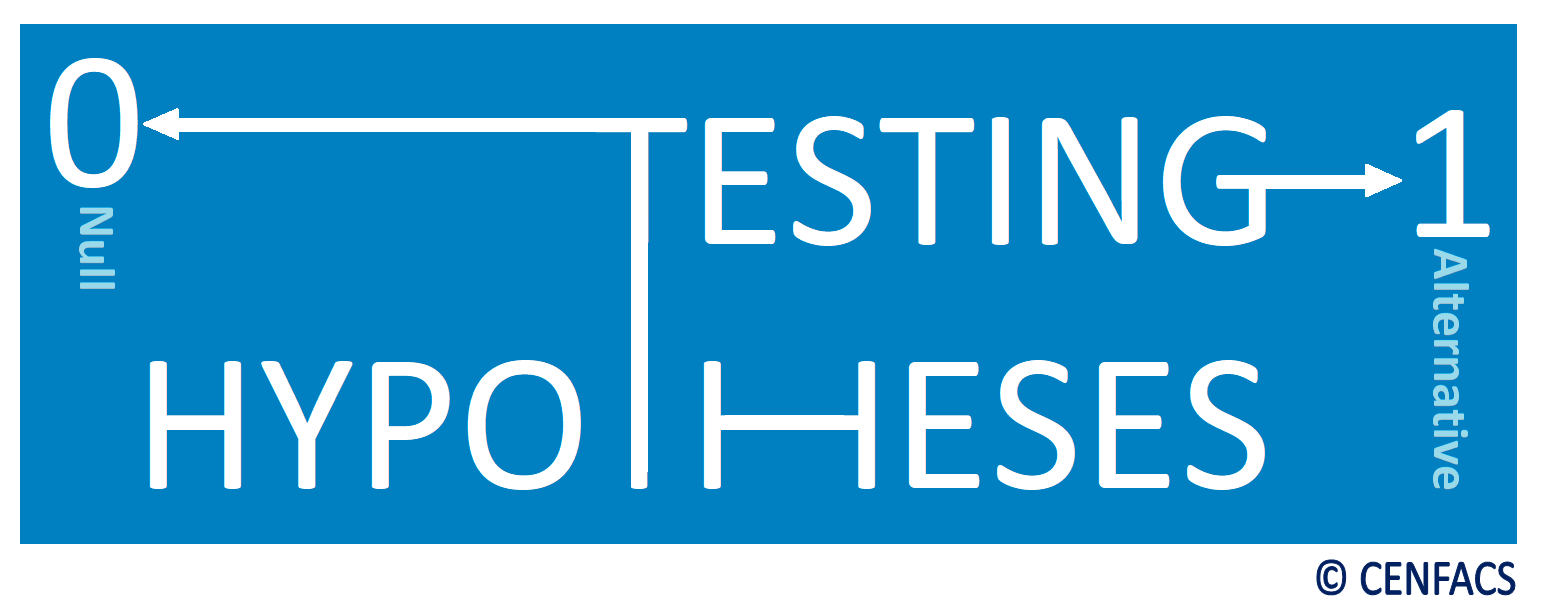
• • • • Testing hypotheses about causal relationships or intersection between climate finance and poverty reduction finance
Testing the hypotheses about the relationship between climate finance and poverty reduction finance examines how financial resources for climate action (mitigation and adaptation) impact poverty reduction efforts and vice versa. It explores if and how investments in climate initiatives can simultaneously alleviate poverty, and if poverty reduction strategies can be effective in achieving climate goals. This also involves understanding the potential for both to be mutually supportive, as well as identifying potential trade-offs.
For those of our members who would like to dive deep into the relationship between climate finance and poverty reduction finance, they can test the inference of the following hypotheses:
a.1) Null hypothesis (Ho): Climate finance can boost poverty reduction
a.2) Alternative hypothesis (H1): Climate finance cannot boost poverty reduction
b.1) Null hypothesis (Ho): Poverty reduction can support climate action
b.2) Alternative hypothesis (H1): Poverty reduction can support climate action.
The above tests are for those of our members who would like to dive deep into the relationship between climate finance and poverty reduction finance. In order to conduct these tests, one needs data.
• • • • E-question on your view about climate finance and poverty reduction finance
Both climate finance and poverty reduction finance aim to improve lives in Africa. This can raise the following question:
Q: Does Africa require the same amount of finance for climate and poverty reduction? In other words, should climate finance be aligned with poverty reduction finance in Africa?
Any of our readers and users can answer the above-mentioned question. You can provide your answer directly to CENFACS.
For those answering any of this question and needing first to discuss the matter, they can contact CENFACS.
• • • • E-discussion on integrating climate action and poverty reduction via finance
The e-discussion is on how investing in climate-resilient initiatives in Africa can help protect communities from climate shocks while reducing poverty.
For those of our members who may have any views or thoughts or even experience to share with regard to this matter, they can join our e-discussion to exchange their views or thoughts or experience with others.
To e-discuss with us and others, please contact CENFACS.
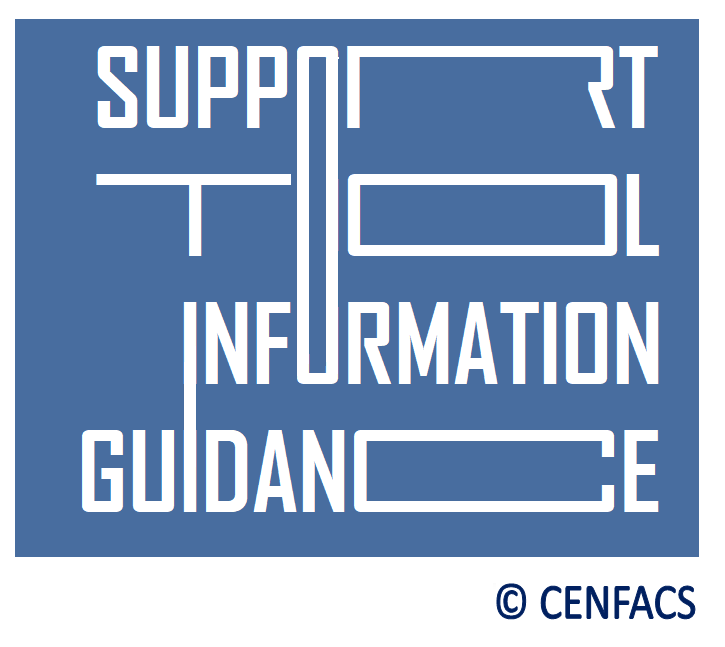
• • • Support, Tool and Metrics, Information and Guidance on Climate Finance and Poverty Reduction Finance (Page 8)
• • • • Ask CENFACS for Guidance regarding Climate Finance and Poverty Reduction Finance
Need some guidance regarding climate finance and poverty reduction finance, CENFACS can guide you on the following:
~ finding climate finance instruments
~ identifying potential funding sources
~ assessing financial viability of your projects
~ ensuring that projects align with sustainability goals.
The above-mentioned areas of guidance can also be done through capacity building, advocacy, advice, networking, signposting, etc.
For those African Charities, especially CENFACS‘ Africa-based Sister Organisations, that are looking for guidance or direction for dealing with Climate Finance and Poverty Reduction Finance issues, CENFACS is prepared to work with them on this matter.
CENFACS can work with them to explore ways of aligning their mission with the goals of reducing poverty and adverse impacts of climate change.
We can work with them under our International Advice-, Guidance- and Information-giving Service. We can as well signpost them to organisations working on Climate Finance and Poverty Reduction Finance.
Need advice, guidance and information; please contact CENFACS for support.
• • • • Tools and metrics of the 87th Issue of FACS
The 87th Issue of FACS uses four tools or metrics which are: the Index of Alignment, Metrics that track climate funds and poverty reduction funds, the Multidimensional Poverty Index and Poverty Gap Ratio.
Let us briefly explain these tools or metrics.
• • • • • Index of Alignment
There is not one single universally recognised index that directly measures the alignment of climate finance with poverty reduction. The UK uses International Climate Finance (ICF) framework and its Key Performance Indicators (KPIs) to align climate finance with poverty. The UK uses KPIs to measure the effectiveness of ICF, in particular the ones below.
KPI 2.1: It measures the number of people with improved access to clean energy.
KPI 6: It quantifies tonnes of greenhouse gas emissions reduced or avoided.
KPI 4: It informs about the number of people whose resilience has been improved.
These KPIs are aligned with the United Nations Sustainable Development Goals (SDGs), including SDG13 (Climate Action) and SDG1 (No Poverty).
• • • • • Metrics that track climate funds and poverty reduction funds
The 87th Issue of FACS considers metrics like total greenhouse gas (GHG) emissions (Scope 1 and 2), portfolio alignment with climate targets, and climate value-at-risk to assess potential financial impacts of climate change. It also focuses on both financial and social impact metrics, including budget adherence, cost per outcome, and measure of poverty reduction like headcount poverty gap, and multidimensional poverty indices, as well as access to education, healthcare, and basic infrastructure.
Two of these metrics (that is, Multidimensional Poverty Index and Poverty Gap) are explained below.
• • • • • Poverty tool and metrics: The Multidimensional Poverty Index and Poverty Gap Ratio
a) The Multidimensional Poverty Index (MPI)
According to ‘hdr.undp.org’ (13),
“MPI is the proportion of the population that is multidimensionally poor adjusted by the intensity of the deprivations” (p. 26).
It is also a measure of the relationship between poverty and peace.
The same ‘hdr.undp.org’ states that
“83.2 percent of the world’s 1.1 billion multidimensionally poor people live in Sub-Saharan Africa and South Asia. Sub-Saharan Africa has 553 million people living in poverty and South Asia 402 million” (p. 1)
b) Poverty Gap Ratio
This is an interesting metrics of poverty as it measures the intensity of poverty.
The online ‘marketbusinessnews.com’ (14) explains that
“The poverty gap ratio or poverty gap index is the average of the ratio of the poverty gap to the poverty line. Economists and statisticians express it as a percentage of the poverty line for a region or whole country…The poverty gap ratio considers how far, on the average, poor people are from poverty line”.
African Charities can use it to compare how far the poor are from the poverty line.
The above tools and metrics can be used in dealing with the work of African Charities, climate finance and poverty reduction finance.
For example, one can use the poverty gap ratio to measure the average shortfall of the income poor women in Africa from the poverty line.
• • • • Information and guidance on climate finance and poverty reduction finance
Information and Guidance include two types areas of support via CENFACS, which are:
a) Information and guidance on climate finance and poverty reduction finance
b) Signposts to improve Users’ Experience about impact investing in climate finance and poverty reduction finance.
• • • • • Information and guidance on climate finance and poverty reduction finance
Those Africa-based Sister Organisations (ASOs) that are looking for information and guidance on climate finance and that do not know what to do, CENFACS can work with them (via needs assessment conducted under CENFACS’ International Advice Service) or provide them with leads about other organisations, institutions and services that can help them.
We can provide information and guidance to address climate finance issues and support to ASOs to reduce poverty and address the impacts of climate change. The support aims to help ASOs adapt to climate change, pursuit low-carbon development, manage resources sustainably, etc.
• • • • • Signposts to improve Users’ Experience about impact investing in climate finance and poverty reduction finance
For those who are looking for whereabout to find help about impact investing in climate finance and poverty reduction finance, we can direct them to the relevant services and organisations.
More tips and hints relating to the matter can be obtained from CENFACS‘ Advice-giving Service and Sessions.
Additionally, you can request from CENFACS a list of organisations and services providing help and support in the area of climate finance, although the Issue 87 does not list them. Before making any request, one needs to specify the kind of organisations and information they are looking for.
To make your request, just contact CENFACS with your name and contact details.
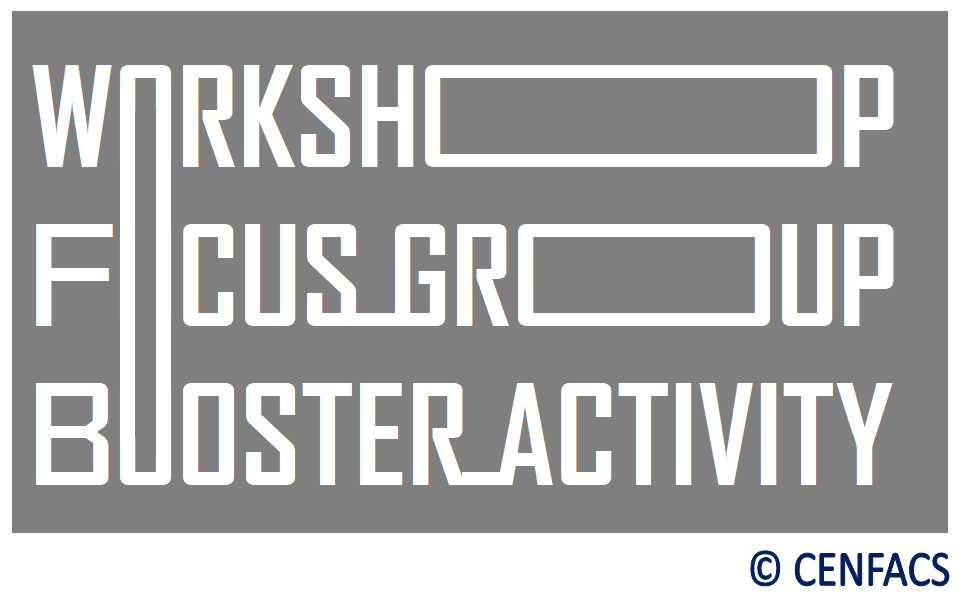
• • • Workshop, Focus Group and Booster Activity about African Charities and Their Links with Climate Finance and Poverty Reduction Finance (Page 9)
• • • • Mini themed workshop on climate finance and poverty reduction finance
It is a training or learning event that focuses on how to mobilise, manage, and utilise funding to address both climate change and poverty. It aims to educate participants about climate finance mechanisms, sustainable finance principles, and how to integrate poverty reduction considerations into climate-resilient projects and investments.
Key aspects of the workshop will include understanding climate finance, sustainable finance principles, integrating poverty reduction, capacity building, networking and collaboration.
The workshop will cover climate finance development, addressing climate finance and poverty, climate-resilient development, sustainable finance, green economy, and disaster risk financing.
The workshop aims at supporting those without or with less information and knowledge about climate finance and poverty reduction finance . Those who need an in-depth climate finance skills training assessment are also welcome. The workshop will provide recommendations for actions with options and opportunities for the participants.
To enquire about the workshop, please contact CENFACS.
• • • • Focus group on climate finance and poverty reduction finance
This is a qualitative research method to be used to explore how people perceive the relationship between the two topics (that is, climate finance and poverty reduction finance). The focus group will bring together a small group of individuals (between 6 and 10) making the CENFACS Community to discuss their ideas, experiences, and perspectives on how climate finance can be used to reduce poverty.
The focus group will help understand needs, inform policy, promote ownership, identify barriers, and test new ideas about climate finance and poverty reduction finance.
To take part in the focus group, group that will use deliberative practice strategies, please contact CENFACS.
• • • • Booster activity: ‘Talking to Climate and Poverty Reduction Experts’
This user involvement activity revolves around the answers to the following question:
Q: Do you talk to a sustainable development advisor or a climate and development specialist or climate finance and poverty reduction consultant about issues relating to climate finance and poverty reduction finance?
Those who would like to answer this question and participate to our ‘Talking to Climate and Poverty Reduction Experts’ Activity, they are welcome.
To take part in this activity, please contact CENFACS.
• • • Giving and Project (Page 10)
• • • • Readers’ giving
You can support FACS, CENFACS bilingual newsletter, which explains what is happening within and around CENFACS.
FACS also provides a wealth of information, tips, tricks and hacks on how to reduce poverty and enhance sustainable development.
You can help to continue its publication and to reward efforts made in producing it.
To support, just contact CENFACS on this site.
• • • • Project Integrating Climate Finance and Poverty Reduction Finance (PICFPRF)
PICFPRF is an integrative initiative that strategically directs financial resources to benefit both climate action and poverty reduction efforts. It is a project that help ensure that climate action benefits the most vulnerable populations and contributes to sustainable development goals.
PICFPRF involves channelling funds towards activities that simultaneously tackle climate change and reduce poverty. It will ensure that climate action funds are aligned with poverty reduction funds in Africa.
The real aim of this project is to reduce and possibly end poverty linked to the lack of climate action funds and poverty reduction funds.
To support or contribute to PICFPRF, please contact CENFACS.
For further details including the implementation plan of the PICFPRF, please contact CENFACS.
The full copy of the 87th Issue of FACS is available on request.
For any queries and comments about this Issue, please do not hesitate to contact CENFACS.
_________
• References
(1) https://reliefweb.int/disaster/fl-2025-000045-cod (accessed in April 2025)
(2) https://news.un.org/en/story/2025/04/1162261 (accessed in April 2025),
(3) www.taskmanagementguide.com/glossary/what-is-project-termination-.php (Accessed in April 2023)
(4) https://www.pmi.org/learning/library/project-termination-delay-1931 (Accessed in April 2023 )
(5) https://www.awf.org/blog/endangered-bonobo-africas-forgotten-ape (accessed in April 2025)
(6) https://www.treehugger.com/bonobos-endangered-5217207 (accessed in April 2025)
(7) https://howcharitieswork.com/about-charities/what-is-a-charity/ (accessed in October 2024)
(8) Frettas, A. S. & Mwanki, G., (2024), Climate Finance in Africa: An Overview of climate finance flows, challenges and opportunities, Ed. UNDP
(9) https://www.carbonbrief.org/cop29-key-outcomes-agreed-at-the-un-climate-talks-in-baku/ (accessed in December 2024)
(10) https://www.climatepolicyinitiative,org/publication/climate-finance-needs-of-african-countries/ (accessed in April 2025)
(11) https://www.bii.co.uk/en/african-climate-conversation/improving-access-to-climate-finance-for-enhanced-climate-action-in-africa/ (accessed in April 2025)
(12) https://www.imf.org/en/Publications/fandd/issues/2021/09/climate-change-and-inequality-guivarch-mejean-taconet (accessed in April 2025)
(13) https://hdr.undp.org/system/files/documents/hdp-document/mpireport2024.pdf (accessed in January 2025)
(14) https://marketbusinessnews.com/information-on-credit/gap-ratio–definition-meaning (accessed in August 2023)
_________
• Help CENFACS Keep the Poverty Relief Work Going This Year
We do our work on a very small budget and on a voluntary basis. Making a donation will show us you value our work and support CENFACS’ work, which is currently offered as a free service.
One could also consider a recurring donation to CENFACS in the future.
Additionally, we would like to inform you that planned gifting is always an option for giving at CENFACS. Likewise, CENFACS accepts matching gifts from companies running a gift-matching programme.
Donate to support CENFACS!
FOR ONLY £1, YOU CAN SUPPORT CENFACS AND CENFACS’ NOBLE AND BEAUTIFUL CAUSES OF POVERTY REDUCTION.
JUST GO TO: Support Causes – (cenfacs.org.uk)
Thank you for visiting CENFACS website and reading this post.
Thank you as well to those who made or make comments about our weekly posts.
We look forward to receiving your regular visits and continuing support until the end of 2025 and beyond.
With many thanks.
